Timeline of terrorism in the Basque Country (1968-2011)
1968
In June Javier Etxebarrieta (Txabi) became the first member of ETA who killed a human being (the civil guard José Pardines) and the first who died, afterwards, in a confrontation with the police.
In August the leader of the political-social brigade of Gipuzkoa, Melitón Manzanas, was shot dead next to his house in Irún. This was the first murder committed by ETA which had been planned beforehand. A State of Exception was declared and the approach “action-repression-action” was adopted.
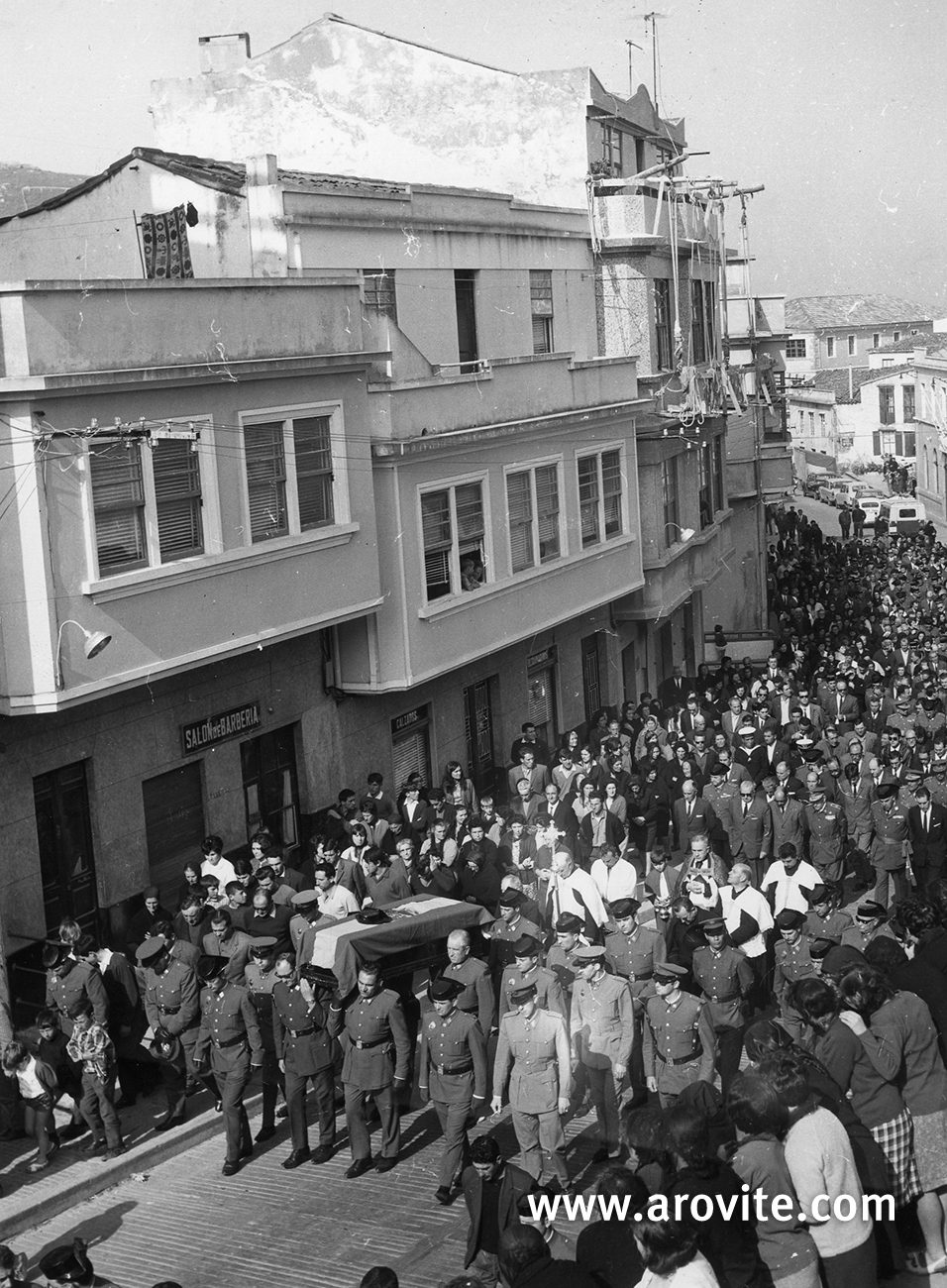
Funeral in Malpica de Bergantiños, La Coruña, 7/06/1968, of the civil guard José Pardines, who was killed by ETA in Billabona, Gipuzkoa. Archive of the Municipality of Bilbao (AMB), Collection of La Gaceta del Norte.
1969
A great number of detentions of important members of ETA.
1970
Council of war against 16 militants of ETA in December. Six of them were condemned to death. The trial of Burgos unleashed a wave of protests against Franco’s regime, and ETA gained much popularity. The death penalty was commuted to life sentence.
In the Sixth Assembly of ETA there was a division between the leftist ETA VI and the ultra-nationalist ETA V.
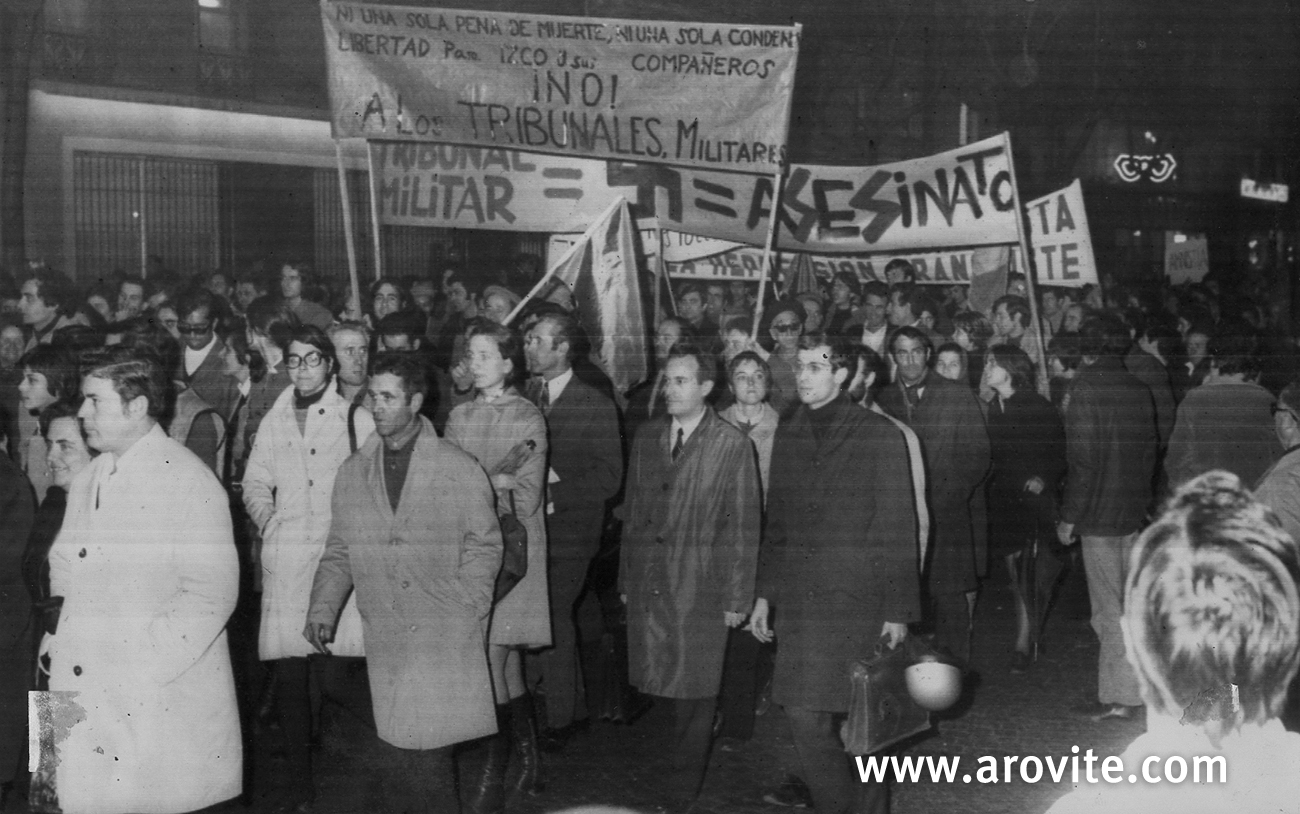
Demonstrators marched in Paris, 3/12/1970, to protest against the trial of Burgos, initiated that day. AMB, Collection of La Gaceta del Norte.
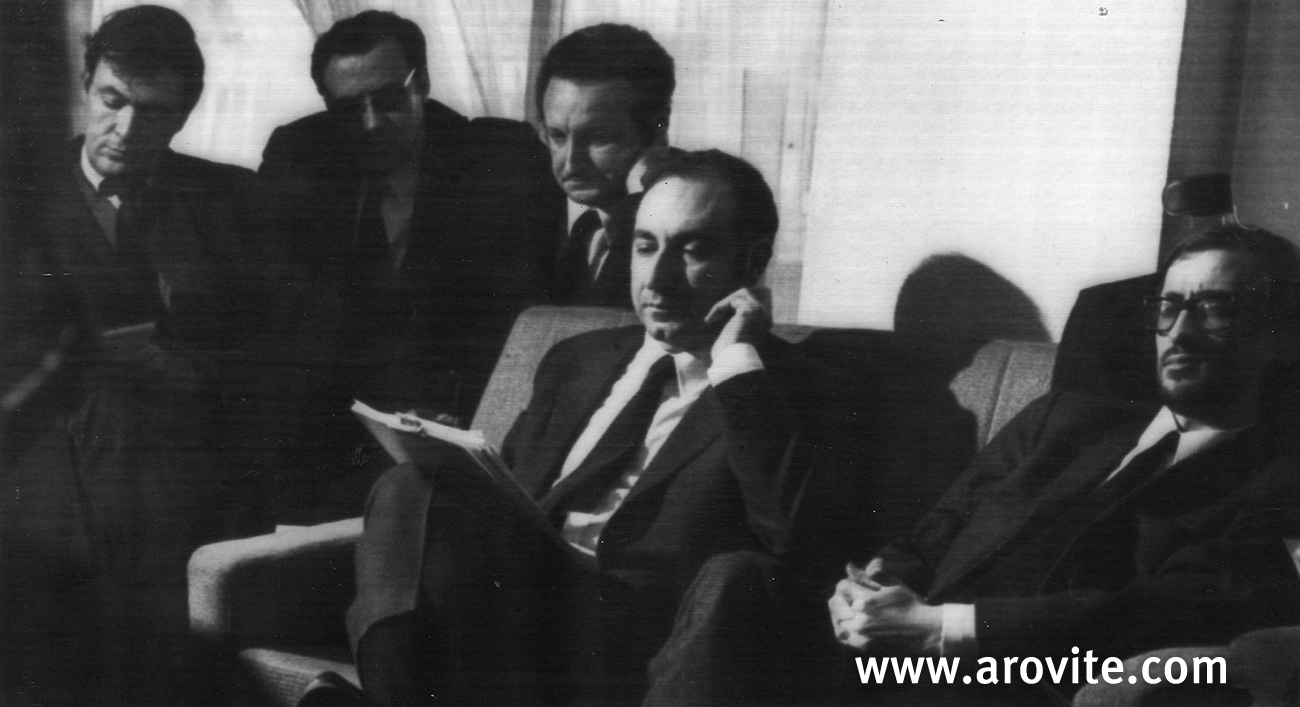
Juan María Bandrés, one of the lawyers who defended the members of ETA who were judged by a military court in Burgos, read a statement to the media. The prosecution had asked for six death penalties and 752 years in prison for all of them. Burgos, 10/12/1970. AMB, Collection of La Gaceta del Norte.
1972
ETA was strengthened by the incorporation of EGI-Batasuna, split of the youth wing of the PNV: Euzko Gaztedi (Basque Youth) of the Inland.
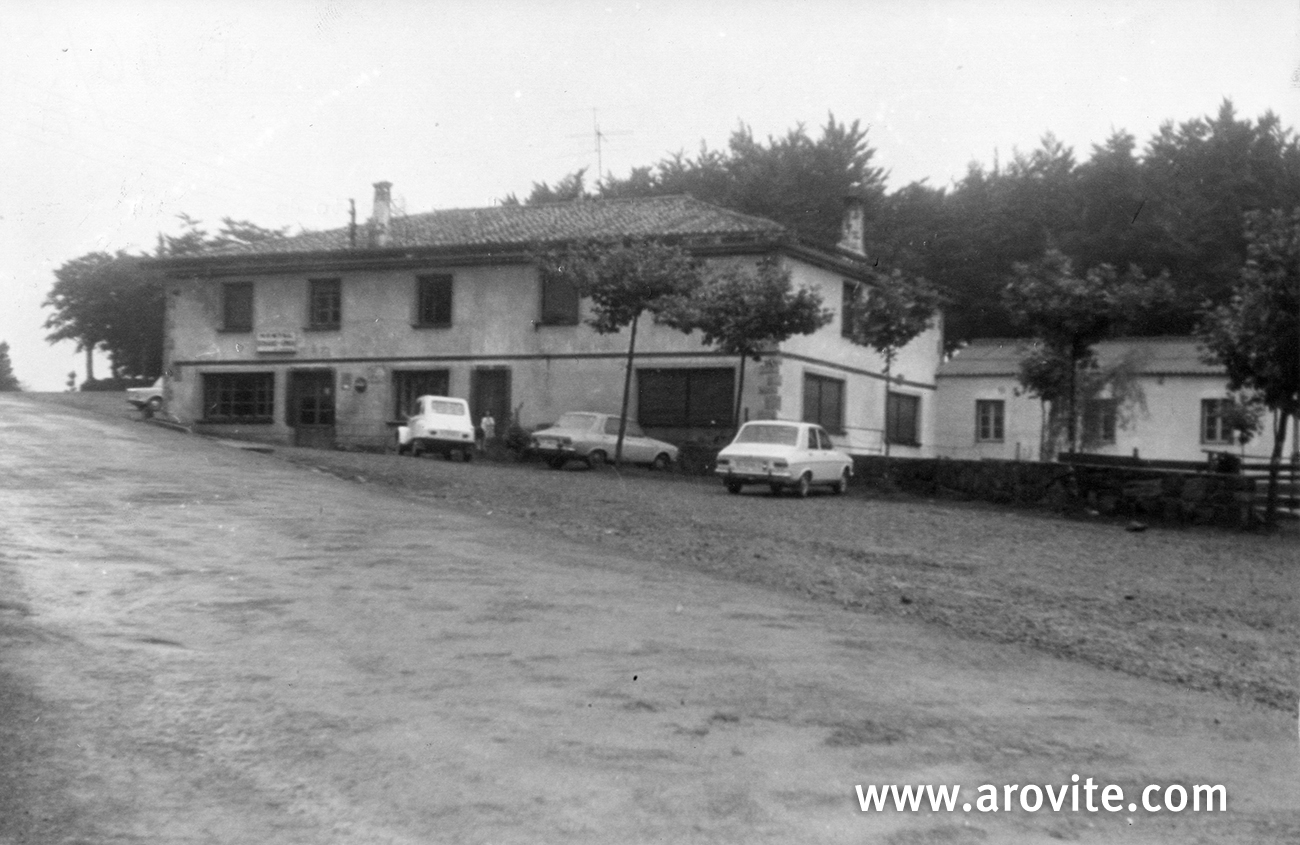
Parador Etxabe Enea, in the port of Kanpazar, Bizkaia, 1972. The place where members of EGI, the youth organization of PNV, met with representatives of ETA. Here, the representatives of EGI were divided. Some, who were conducted by Iñaki Mugika Arregi, decided to join ETA in the armed action. Others preferred to continue with peaceful action. AMB, Collection of La Gaceta del Norte.
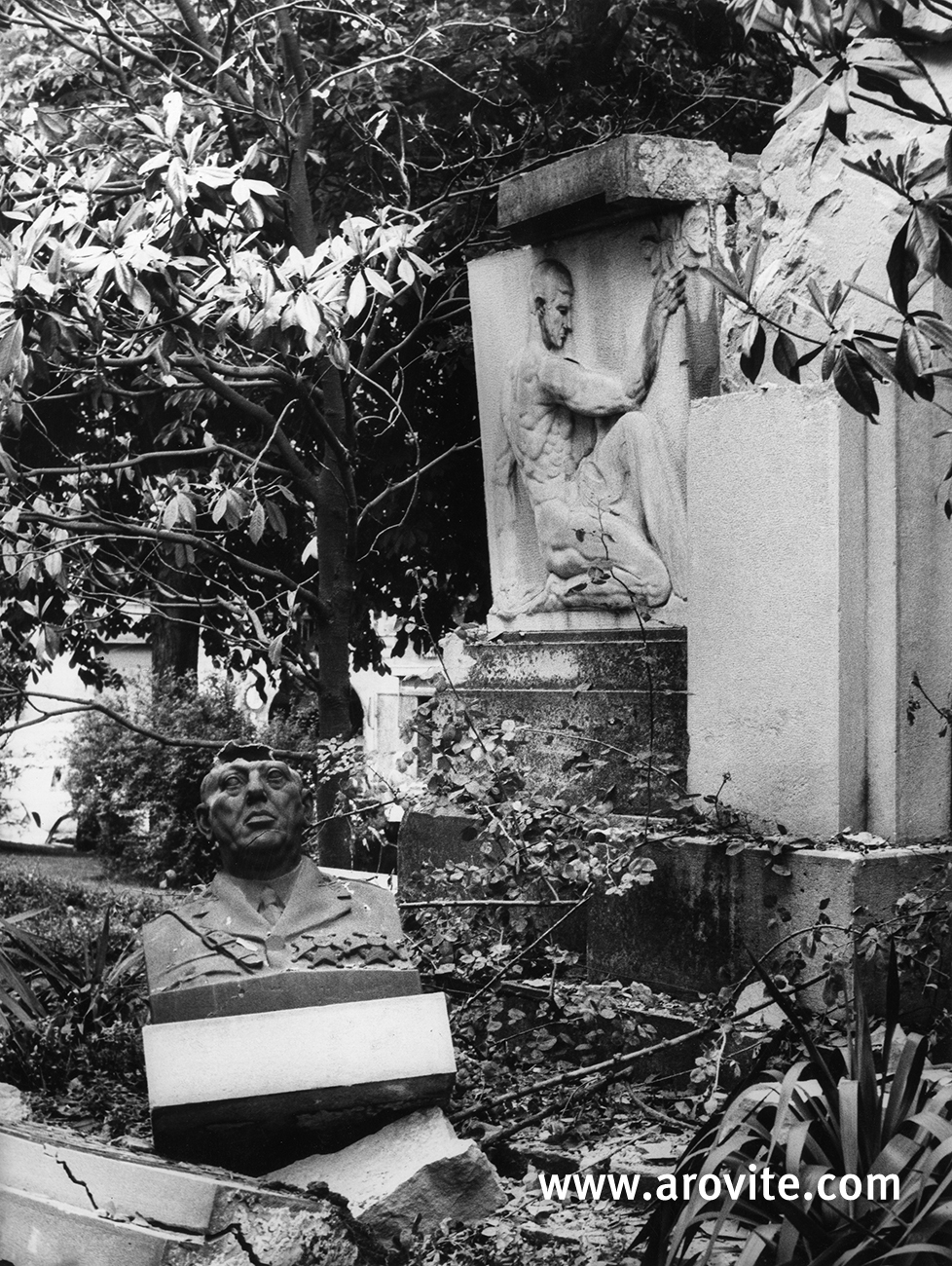
Francoist monument for the general José Sanjurjo, which was destroyed in Pamplona, 27/06/1972. AMB, Collection of La Gaceta del Norte.
1973
In April the charismatic leader of ETA Eustaquio Mendizabal (Txikia) was killed by the police after a shooting.
In December ETA killed the admiral Luis Carrero Blanco, president of the Spanish Government and Franco’s right arm, in one of its attacks that received the most attention.
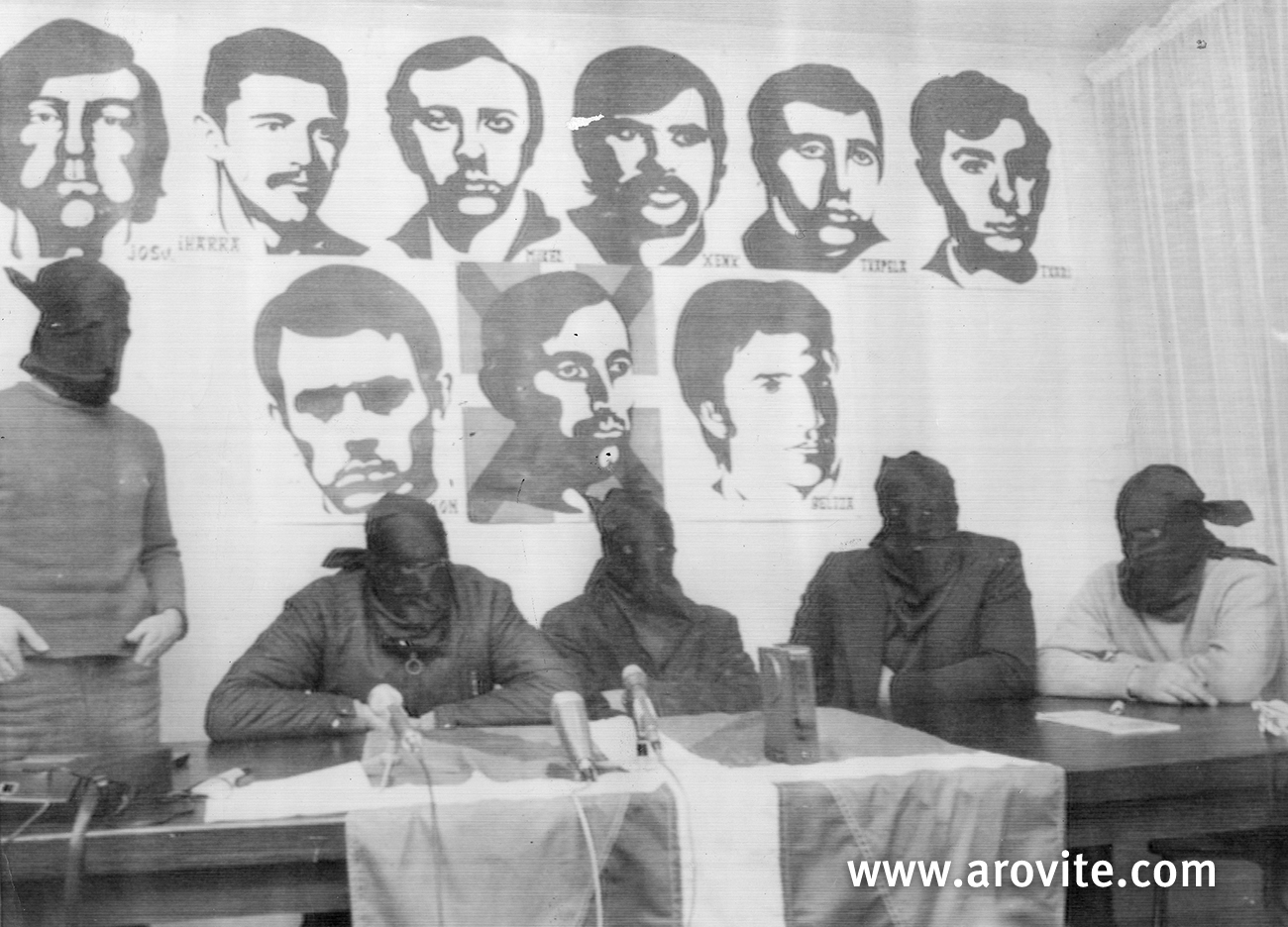
Four hooded men, who were members of ETA, claimed to have been responsible for the assassination of Luis Carrero Blanco. The declaration was made during the press conference that was celebrated in a villa in the south west of France, 29/12/1973. The masked man who was the only one standing was the translator. The pictures on the wall were all portraits of dead members of ETA. AMB, Collection of La Gaceta del Norte.
1974
All the members of Security Forces now became an objective of ETA. In September an explosion killed 13 people in cafeteria Rolando. This was the first indiscriminate attack carried out by the terrorist organization.
The «laborist front» of ETA split to found the party LAIA, Langile Abertzale Iraultzaileen Alderdia (Party of the Patriotic Revolutionary Workers).
Another division led to two new branches: military ETA (ETAm) and political-military ETA (ETApm). The latter promoted the foundation of the abertzale union LAB.
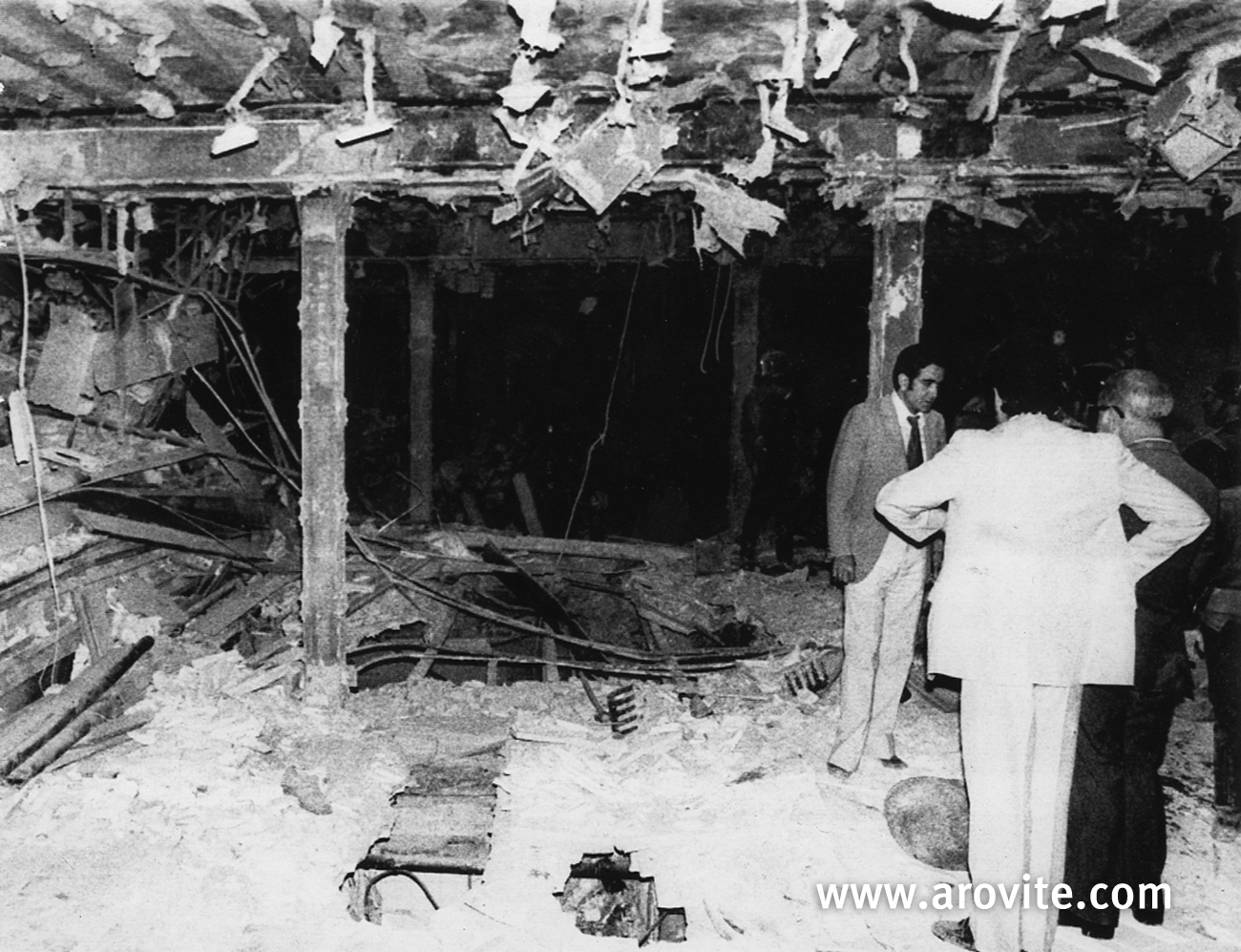
Explosion of a device which was located by ETA in cafeteria Rolando in Calle Correo, close to the Puerta del Sol. Madrid, 13/09/1974. AMB, Collection of La Gaceta del Norte.
1975
In August the Spanish Government passed a severe Anti-Terrorist decree-law.
Undercover agent, Mikel Lejarza (Lobo), made possible the practical dismantling of ETApm.
In September, at the end of the Francoist regime, the executions of the members of ETApm Juan Paredes, Txiki, and Ángel Otaegi unleashed a new wave of protests in Spain and abroad, especially in the Basque Country. As a consequence, Franco declared his last State of Exception.
On the 20th of November, the dictator Francisco Franco died.
Juan Carlos I became King.
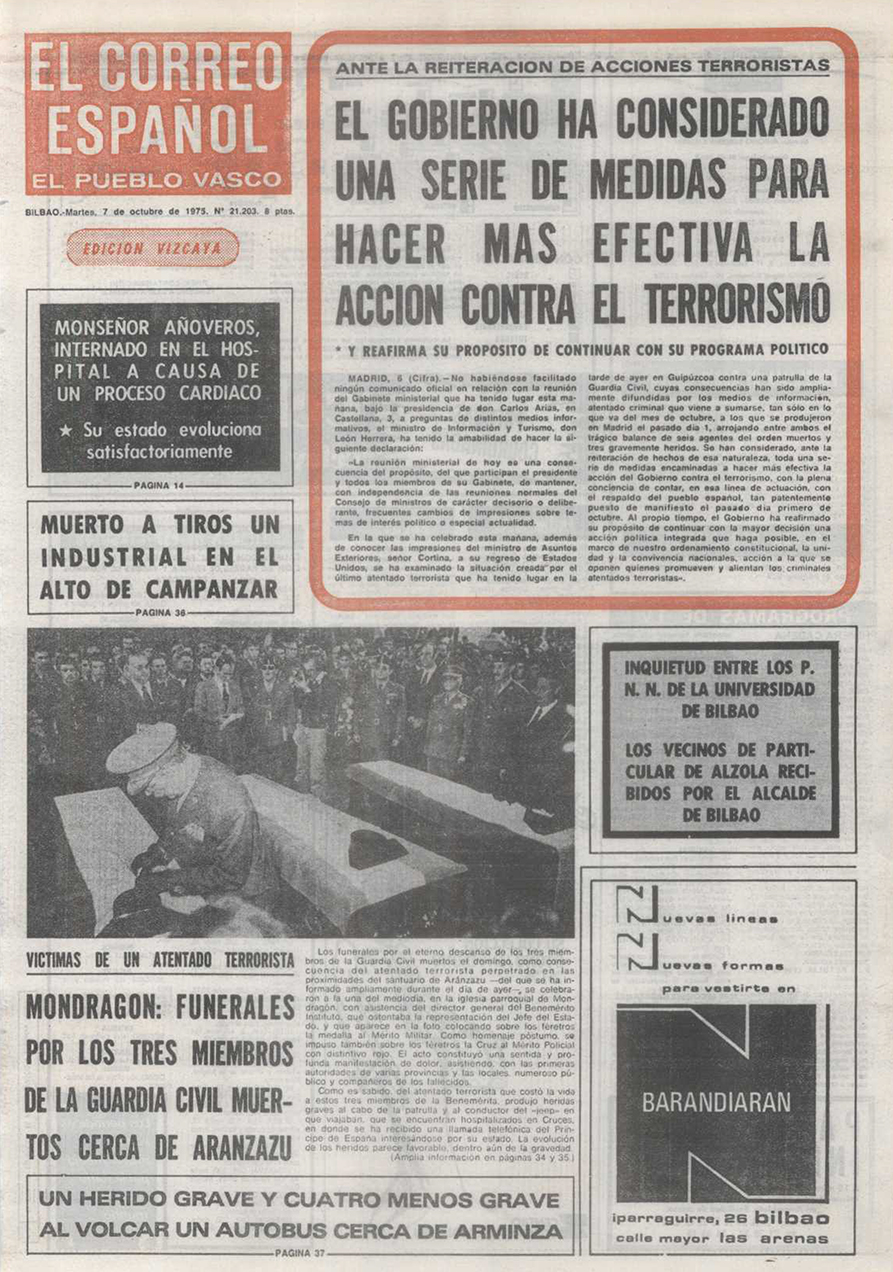
Cover of El Correo Español – El Pueblo Vasco, 07/10/1975, on which the funeral for the three civil guards (Jesús Pascual Martín, Esteban Maldonado and Juan José Moreno) was reported. All three were killed in an attack carried out by ETAm in Oñati.
1976
In July the radical Basque nationalist forces published the «KAS alternative» (Koordinadora Abertzale Sozialista, Patriotic Socialist Coordinator).
In the light of the political change in Spain and based on the plan of Eduardo Moreno Bergaretxe (Pertur), ETApm promoted the foundation of the party EIA, which would be part of the future list of candidates EE.
Pertur disappeared in the French Basque Country before the 7th Assembly of ETApm took place. His project was approved.
In December the Spanish Political Reform Act (Ley para la Reforma Política) was ratified.
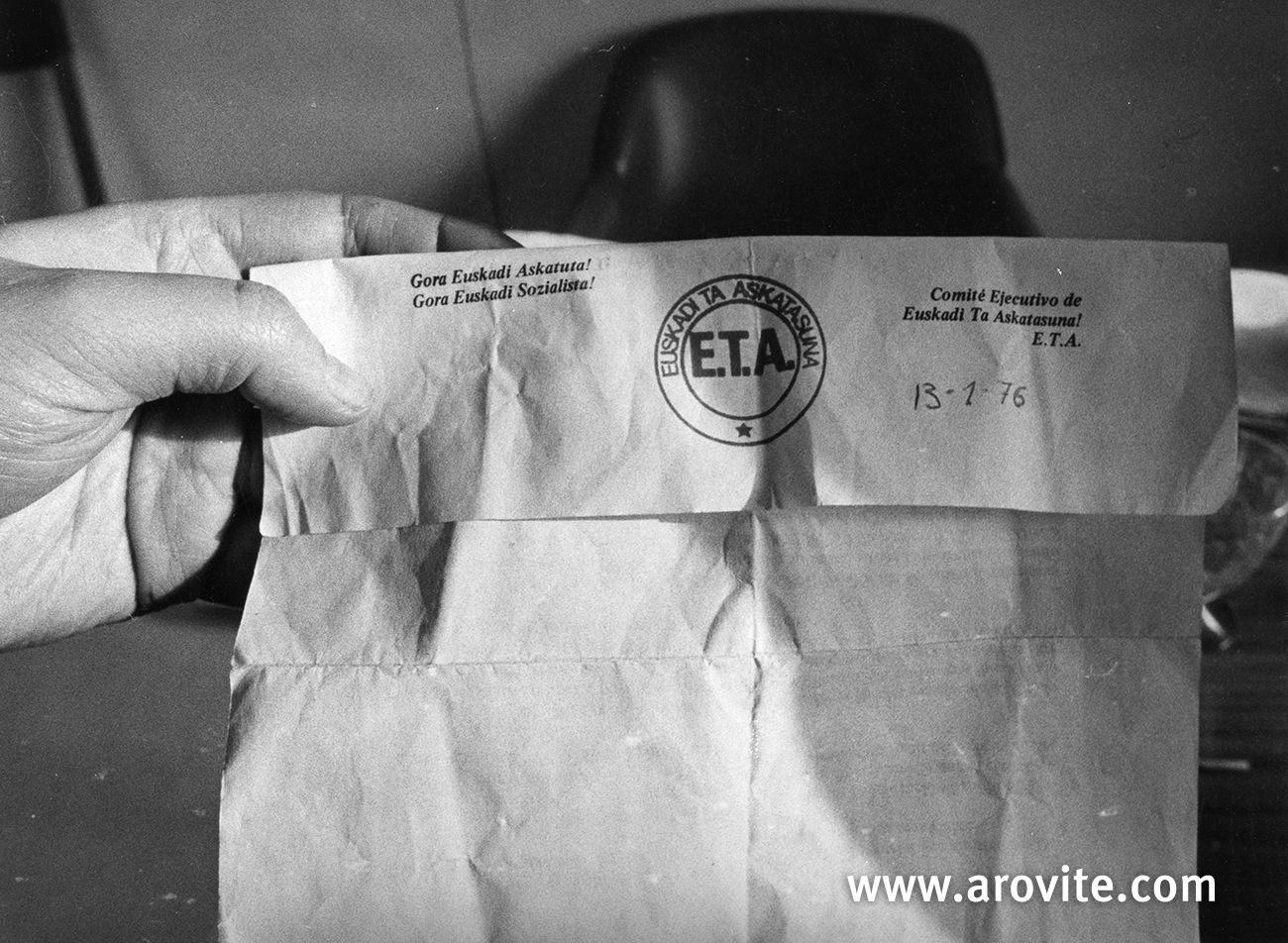
Letter written by ETApm asking for 100 million pesetas for the rescue of the business owner José Luis Arrasate. AMB, Collection of La Gaceta del Norte.
1977
In May a pro-amnesty week ended with the death of several people in the Basque Country because of police repression.
The Government of Adolfo Suárez and ETApm hold conversations in Geneva which resulted in the banishment of the most important ETA prisoners in May.
ETAm, EHAS, Euskal Herriko Alderdi Sozialista (Socialist Party of the Basque Country), and LAIA boycotted the general elections in June, which were the first democratic elections to be held after the Second Republic.
In September the newspaper Egin appeared, which took a radical Basque nationalist position.
In October the Spanish Parliament passed an Amnesty Law for all the terrorist prisoners. The two branches of ETA continued with their attacks.
The so-called bereziak (special) commandos split from ETApm and joined ETAm. Soldiers were now potential targets for ETA.
The two branches of ETA began a campaign of attacks against the nuclear power plant of Lemóniz and its sponsoring company, Iberduero, which would last until 1984, with a total of 300 attacks.
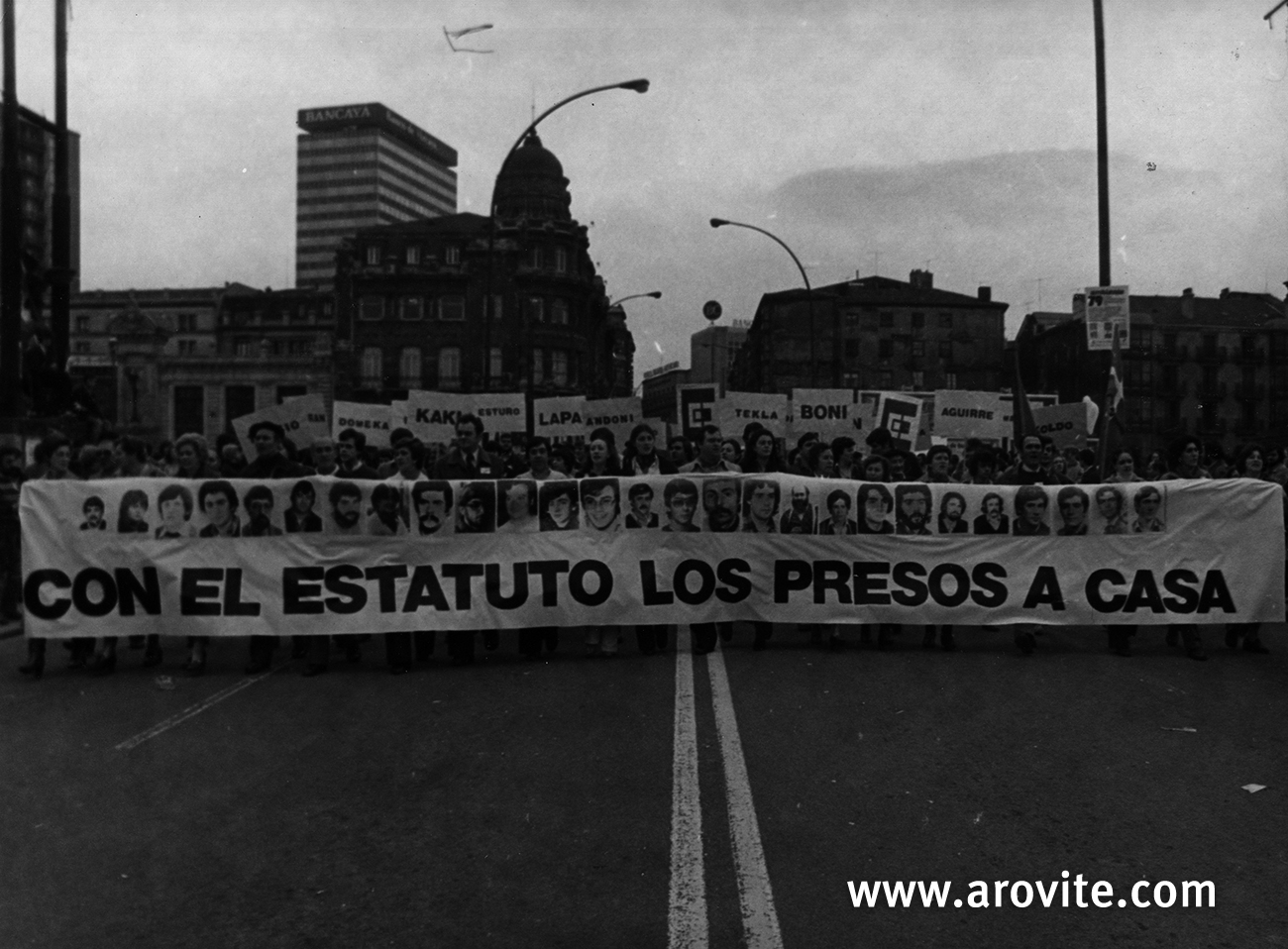
Demonstration in support of amnesty in Bilbao, 3/09/1977. AMB, Collection of La Gaceta del Norte.
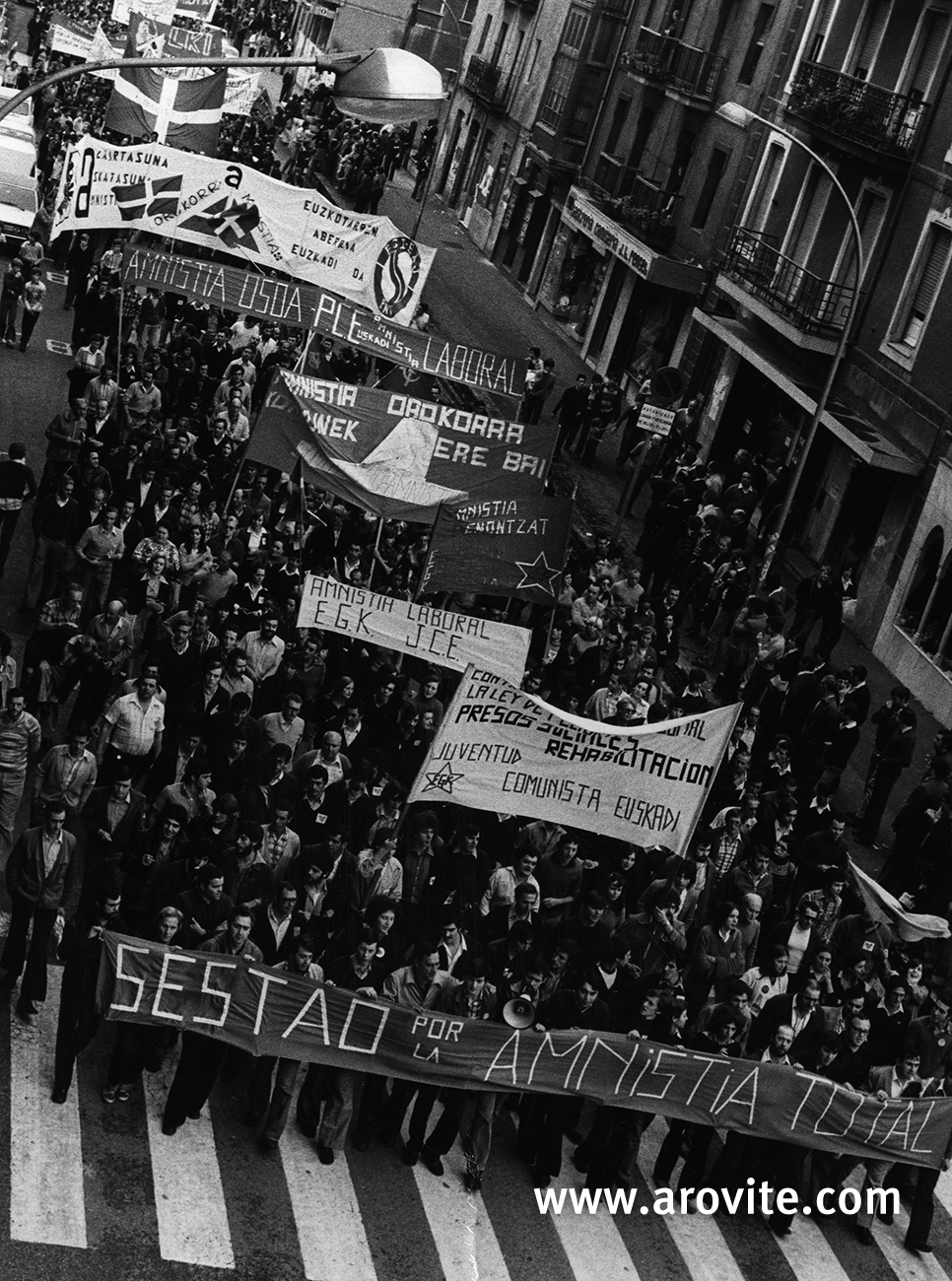
Demonstration in support of amnesty in Sestao, 2/10/1977. AMB, Collection of La Gaceta del Norte.
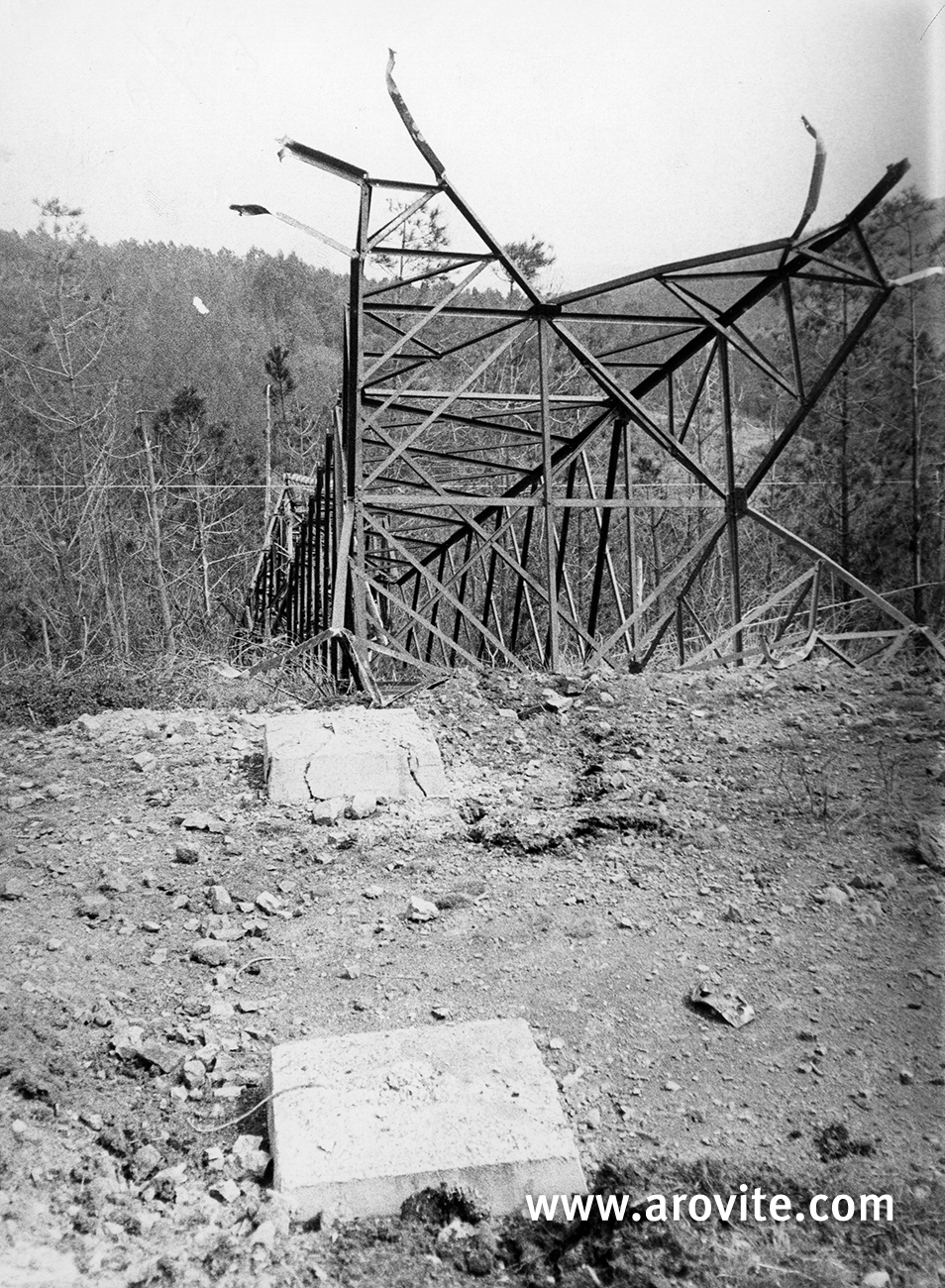
28 kilos of explosives strapped to towers of high voltage of Iberduero in Mungia, 8/04/1978. AMB, Collection of La Gaceta del Norte.
1978
In April, the foundation of HB, Herri Batasuna (Popular Unit) took place, as a coalition of the parties HASI, LAIA, ESB, Euskal Sozialista Biltzarrea (Basque Socialist Party) and ANV, Basque Nationalist Action, besides independent figures. HB was closely associated with ETAm.
In September the Autonomous Anti-capitalist Commandos killed for the first time. The victim was the taxi driver Amancio Barreiro.
A demonstration took place «in support of a free and peaceful Basque Country», which was organized by PNV, supported by political and union forces like PSE-PSOE, PCE-EPK, ORT, UGT and CCOO, and responded to by HB with a counter-march «for the gudaris of yesterday and today».
In December the Spanish Constitution was approved by a referendum.
In the same month para-police terrorists were responsible for the death of the leader of ETAm José Miguel Beñaran (Argala).
In these years of the Transition, ETA blackmailed business owners by means of the so-called «revolutionary tax» or directly robbed them and others to finance the organization.
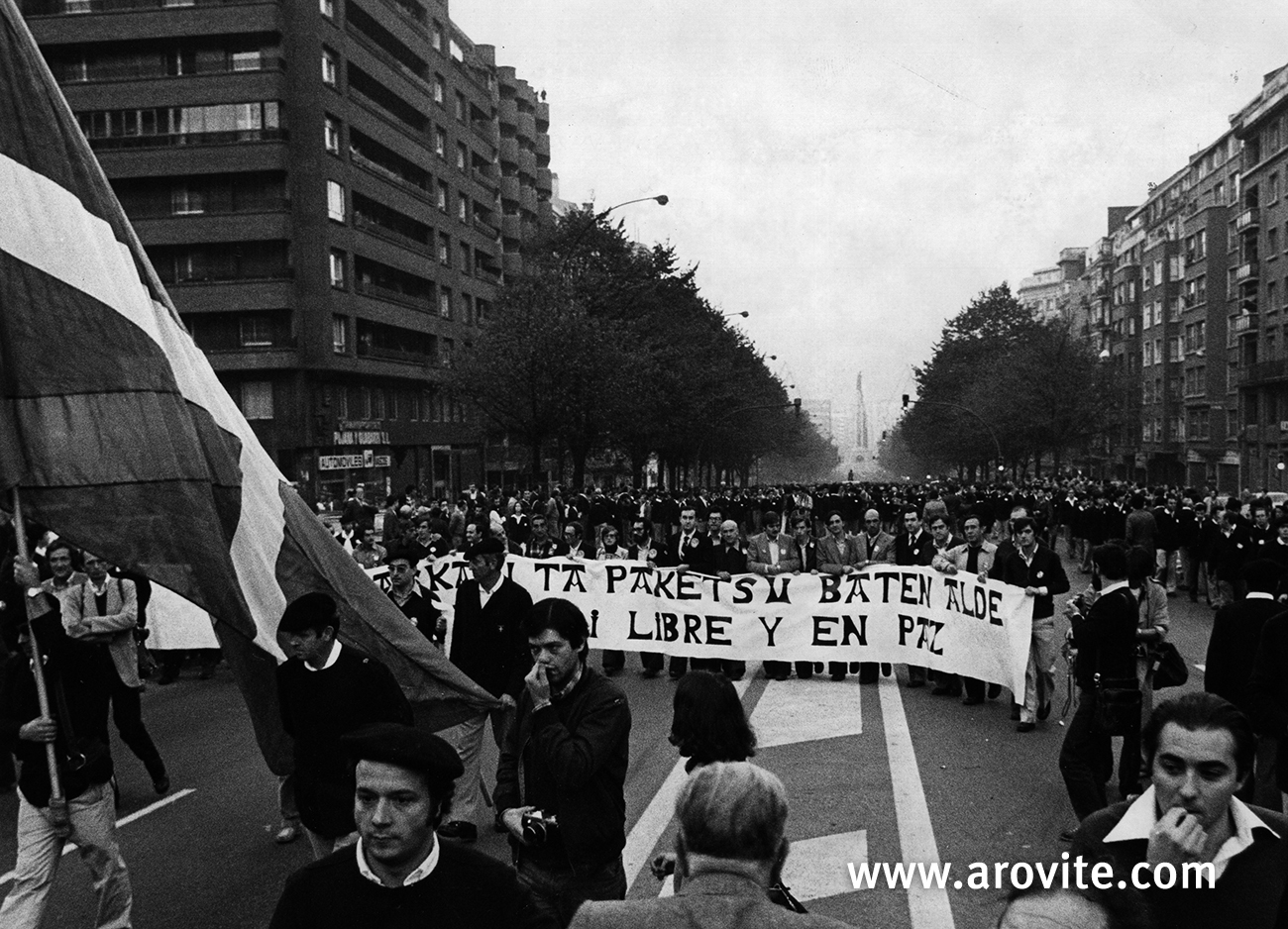
Demonstration «for a free and peaceful Basque Country». Bilbao, 29/10/1978. AMB, Collection of La Gaceta del Norte.
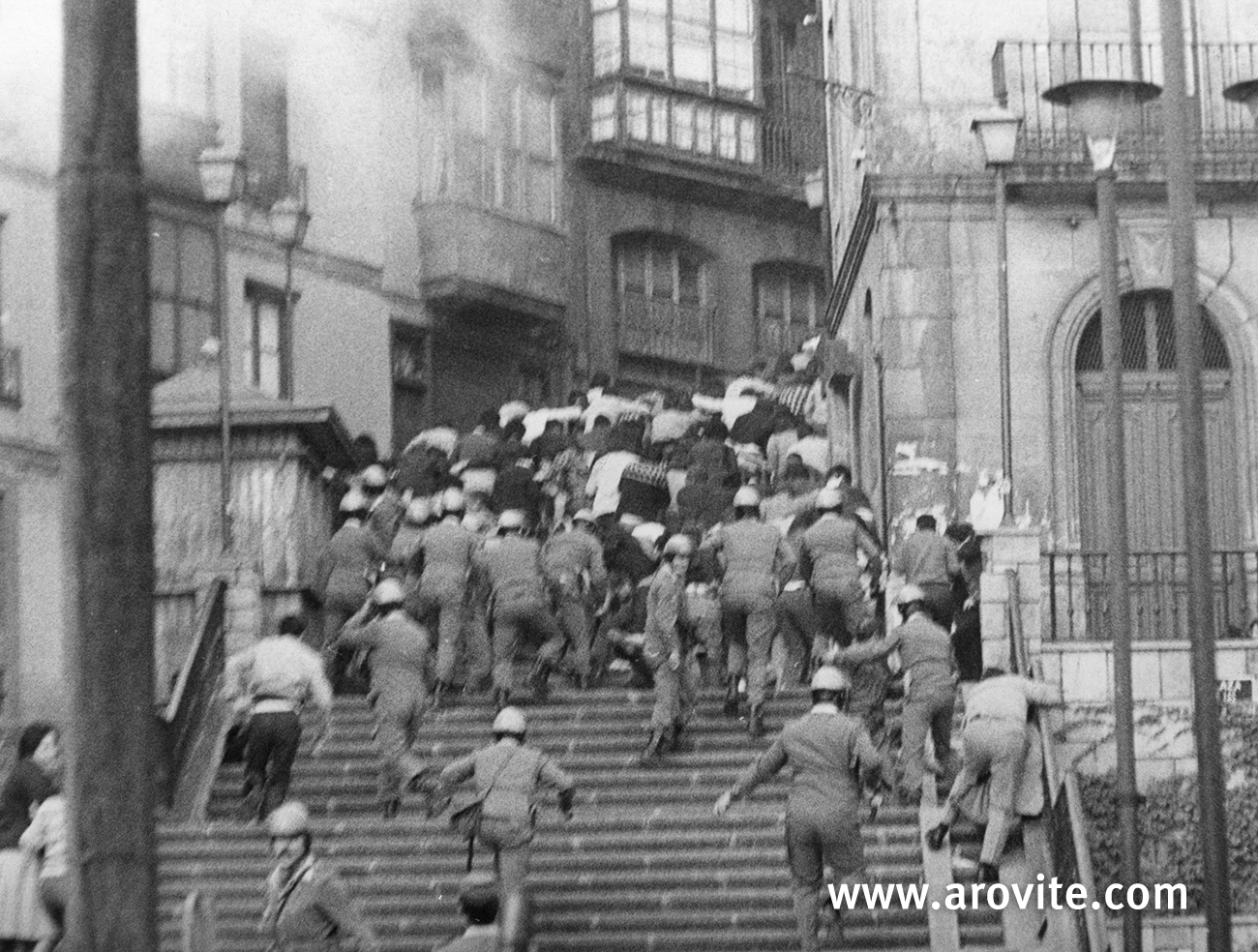
Counter-demontration of HB «for the gudaris of yesterday and today», which was dissolved by the Police in the calzadas de Mallona in Bilbao, 29/01/1978. AMB, Collection of La Gaceta del Norte.
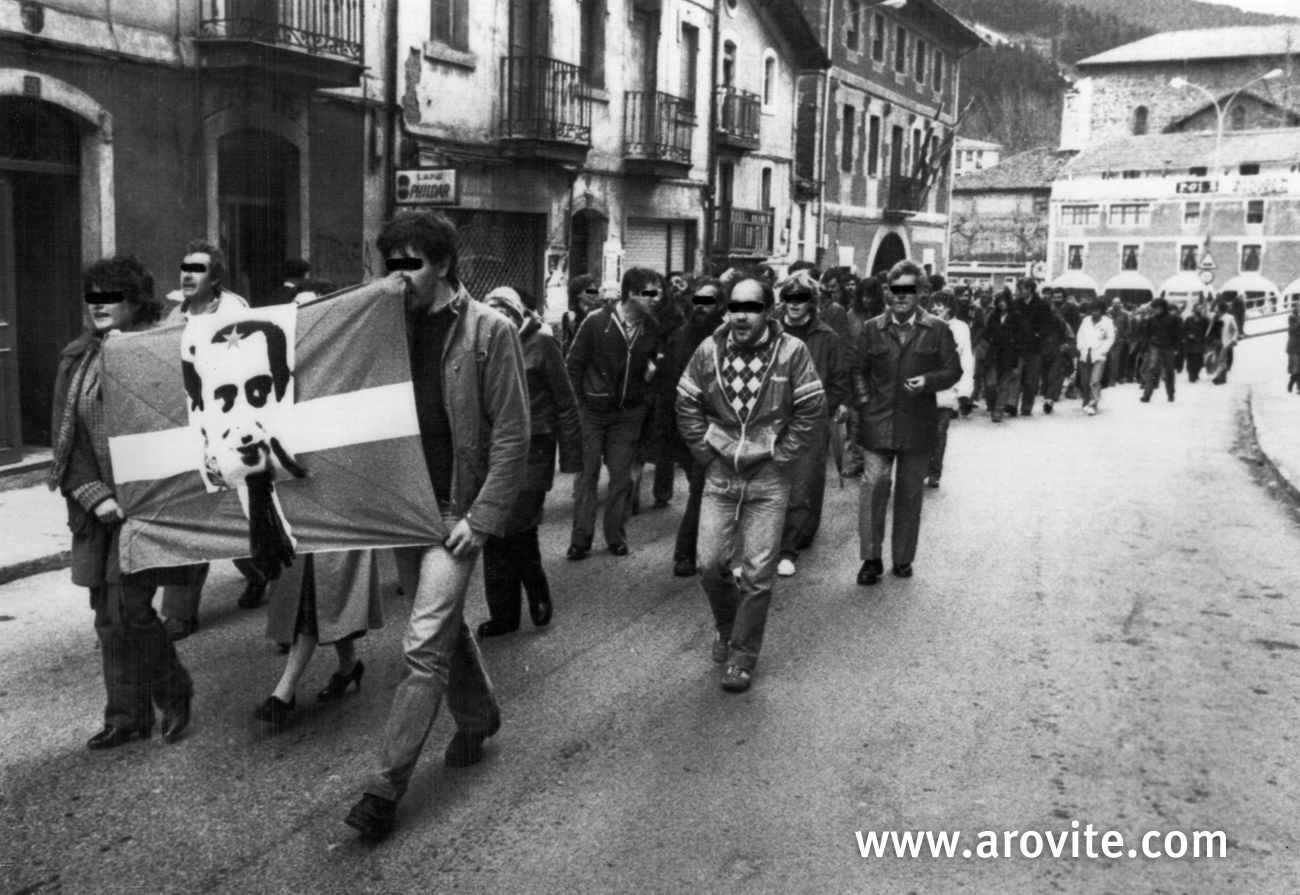
In the Biscayan town of Arrigorriaga several acts of remembrance of José Miguel Beñaran (Argala) took place on the occasion of the third anniversary of the attack in Anglet (France) that had killed this former militant of ETAm.
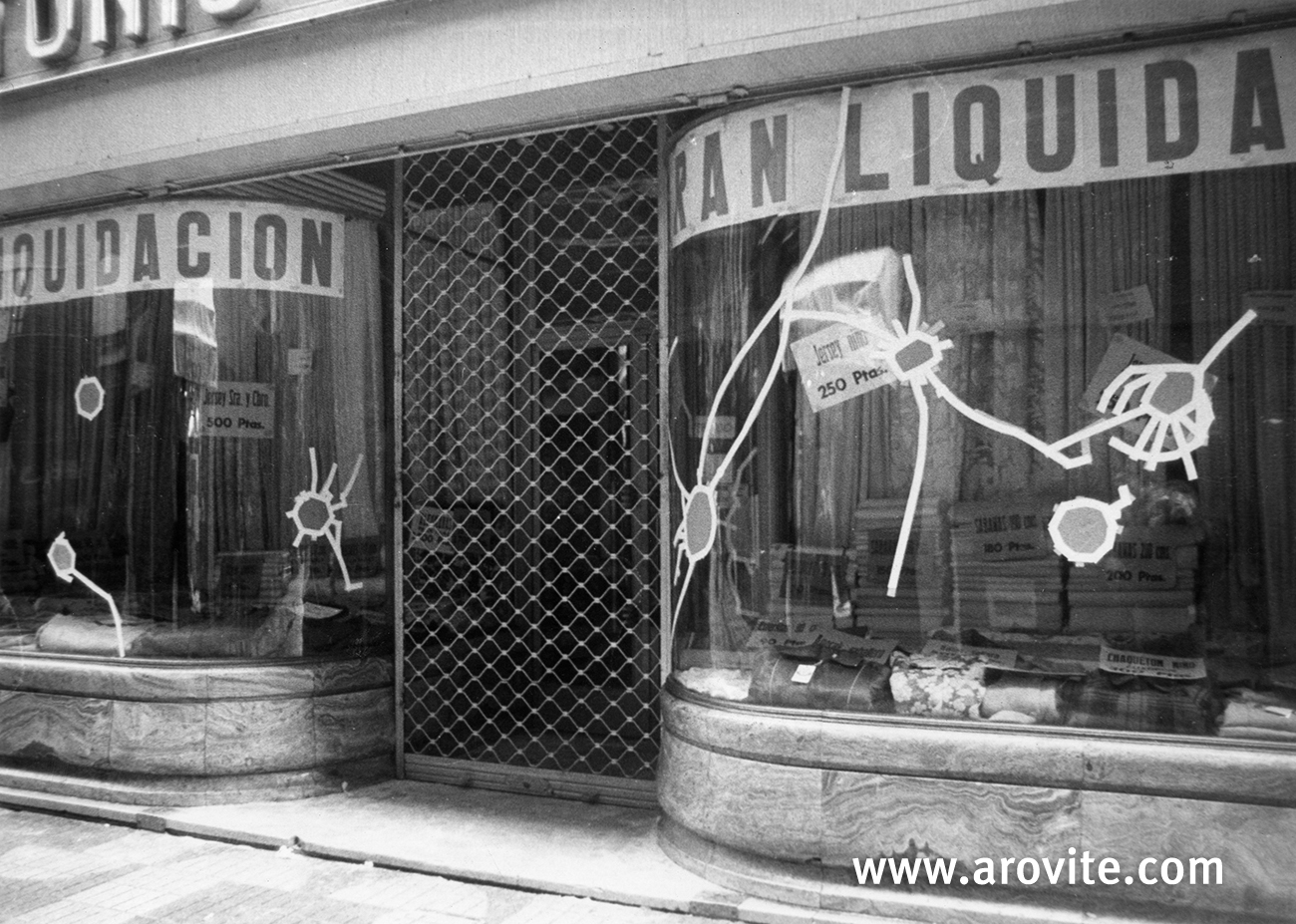
The front of a shop in Bilbao which had been shot by ETAm for not paying the «revolutionary tax». AMB, Collection of La Gaceta del Norte.
1979
Only one year after its foundation HB turned into the second political force in the Basque Country in the municipal elections of April.
In May Jarrai was founded, the youth wing of the radical Basque nationalists, which was linked to ETAm.
In October, the Statute of Autonomy of the Basque Country was approved by a referendum, which was opposed by HB and ETAm.
ETA began a campaign of attacks against Spanish tourist destinations and attractions, which would continue until 2009, with a total of 225 attacks.
ETA started a campaign of attacks against French tourist destinations and attractions, which would continue until 1992, with a total of 320 attacks.
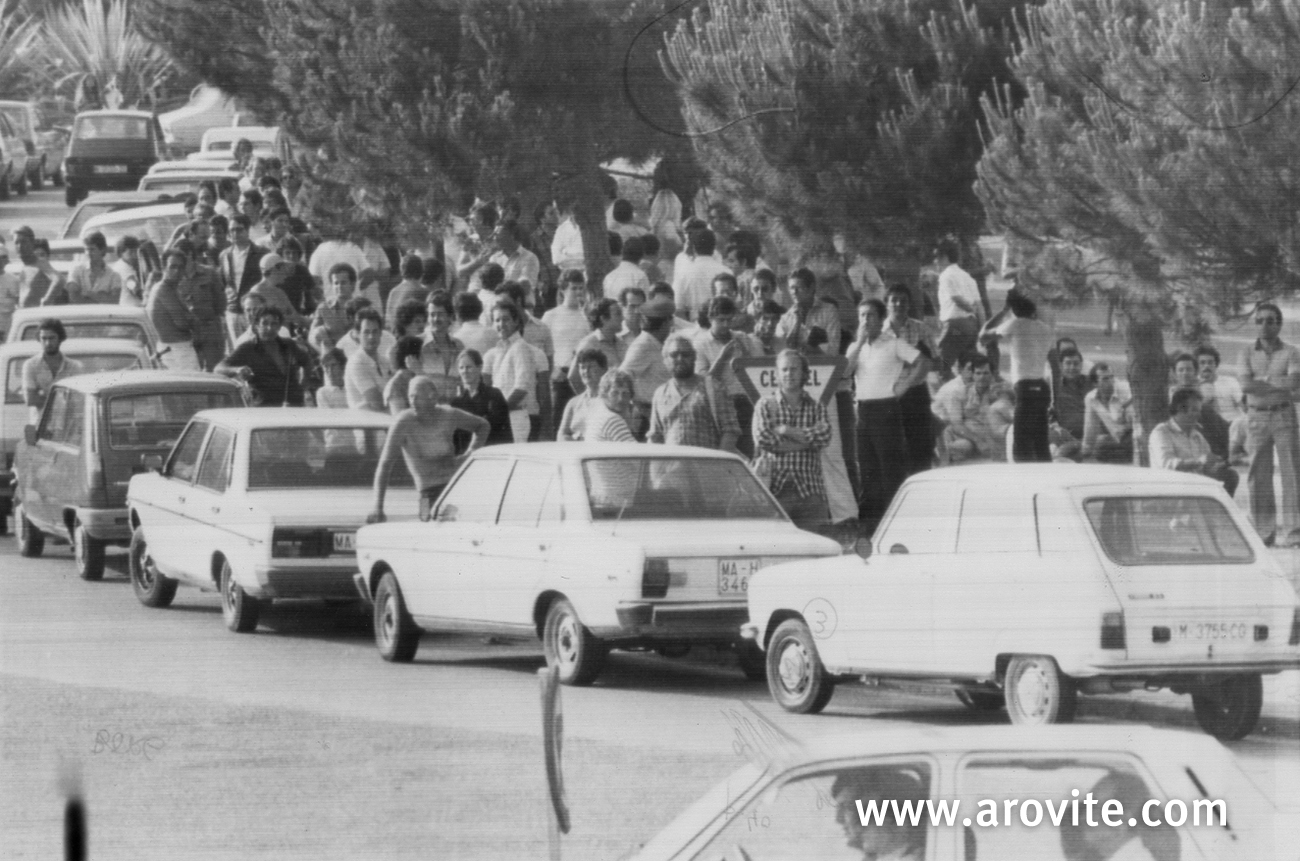
Workers and visitors of Puerto Banús waiting for the explosion of a bomb which was placed by ETApm. Málaga, 5/07/1980. AMB, Collection of La Gaceta del Norte.
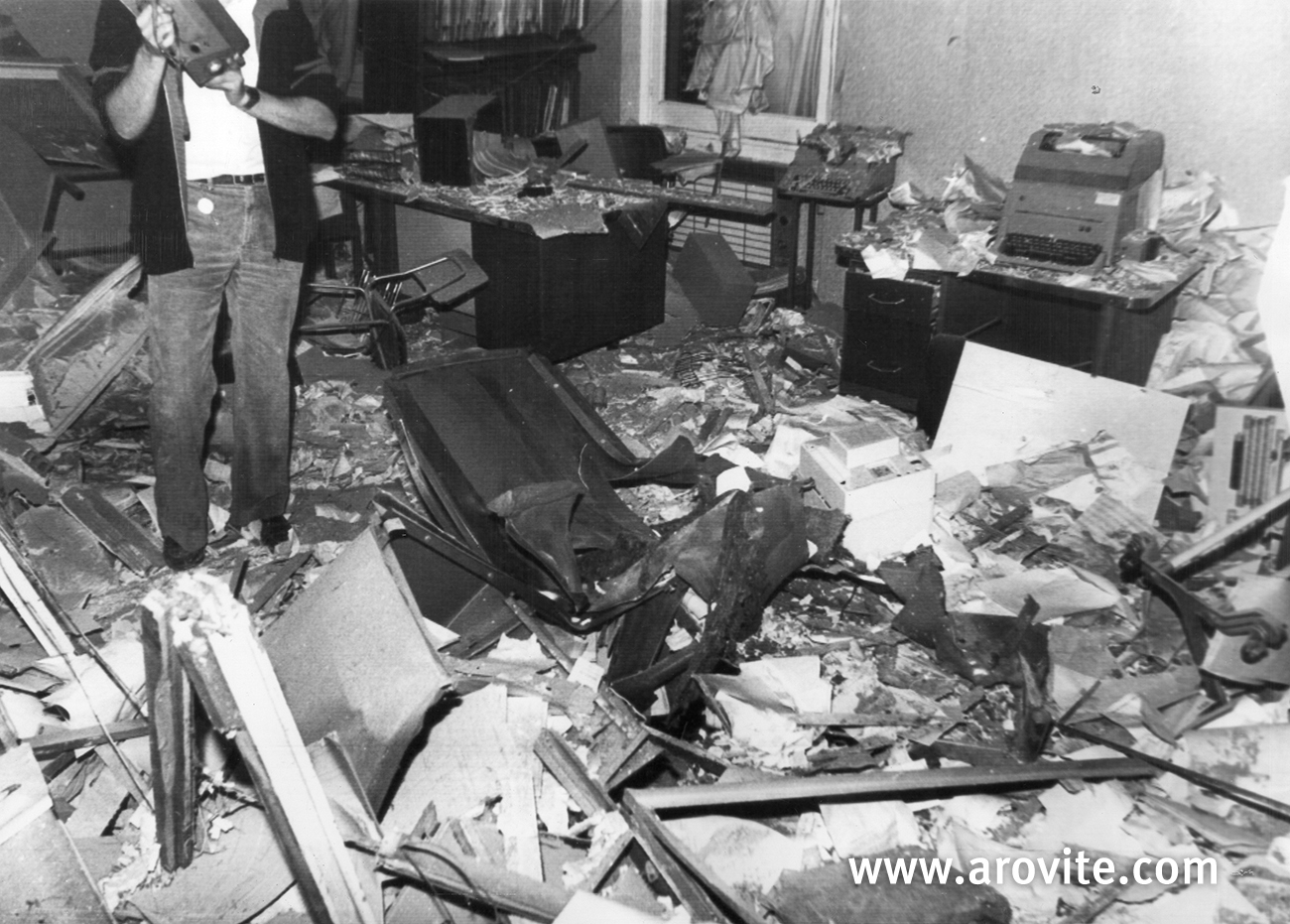
Interior of the office of Seguros Generales in San Sebastián after the explosion of a device, 26/11/1984. AMB, Collection of La Gaceta del Norte.
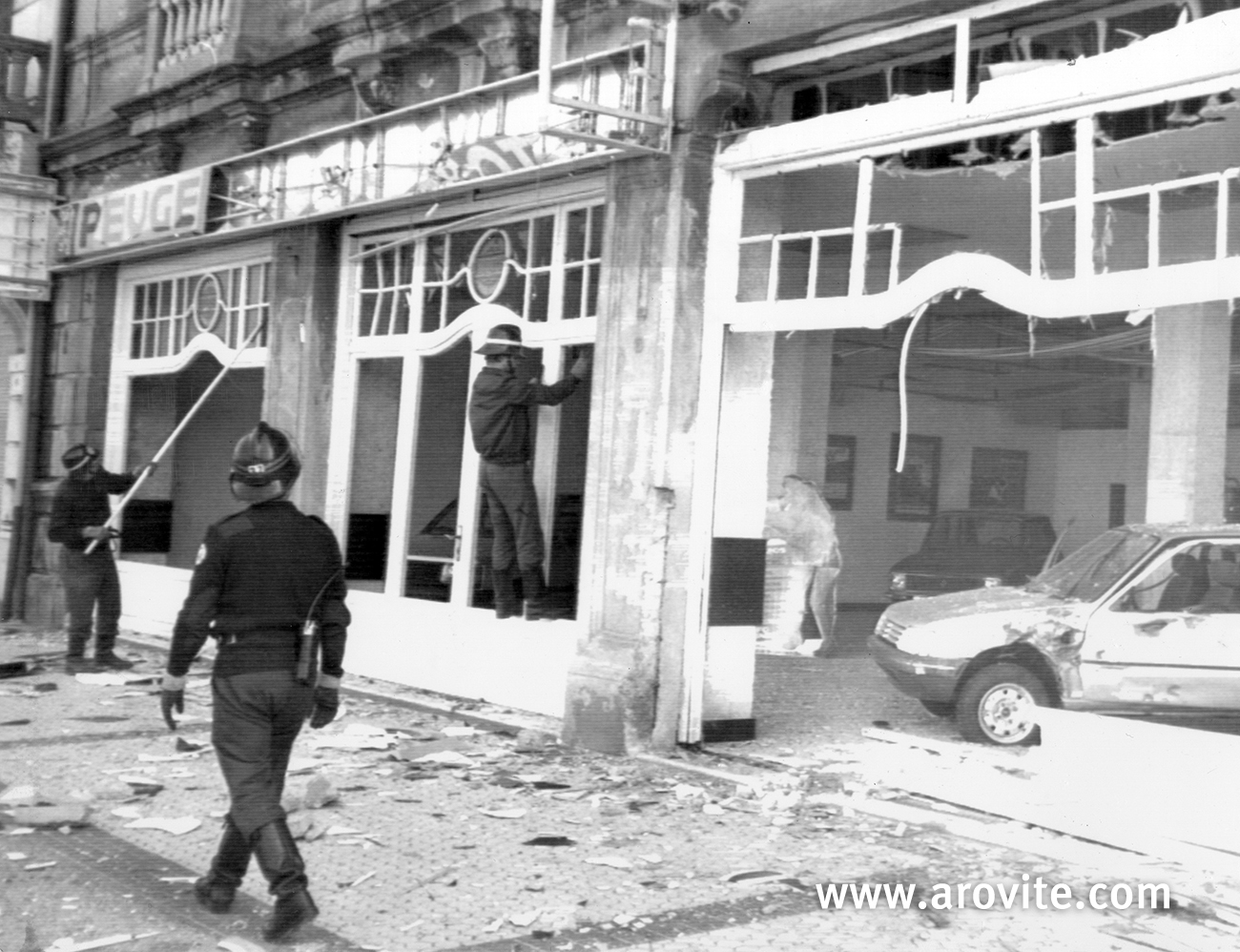
Firemen of San Sebastián removing broken glass at a car dealer of Peugeot-Talbot after a bomb explosion, 31/03/1985. AMB, Collection of La Gaceta del Norte.
1980
The year of the elections for the first Basque Parliament was also the peak year of the cycle of political violence during the Transition to democracy. More than 100 people were killed and the majority of them by ETAm.
In the autonomous elections of March HB became the second force of the Basque Country after PNV.
ETApm started a campaign of killing politicians of the Basque UCD.
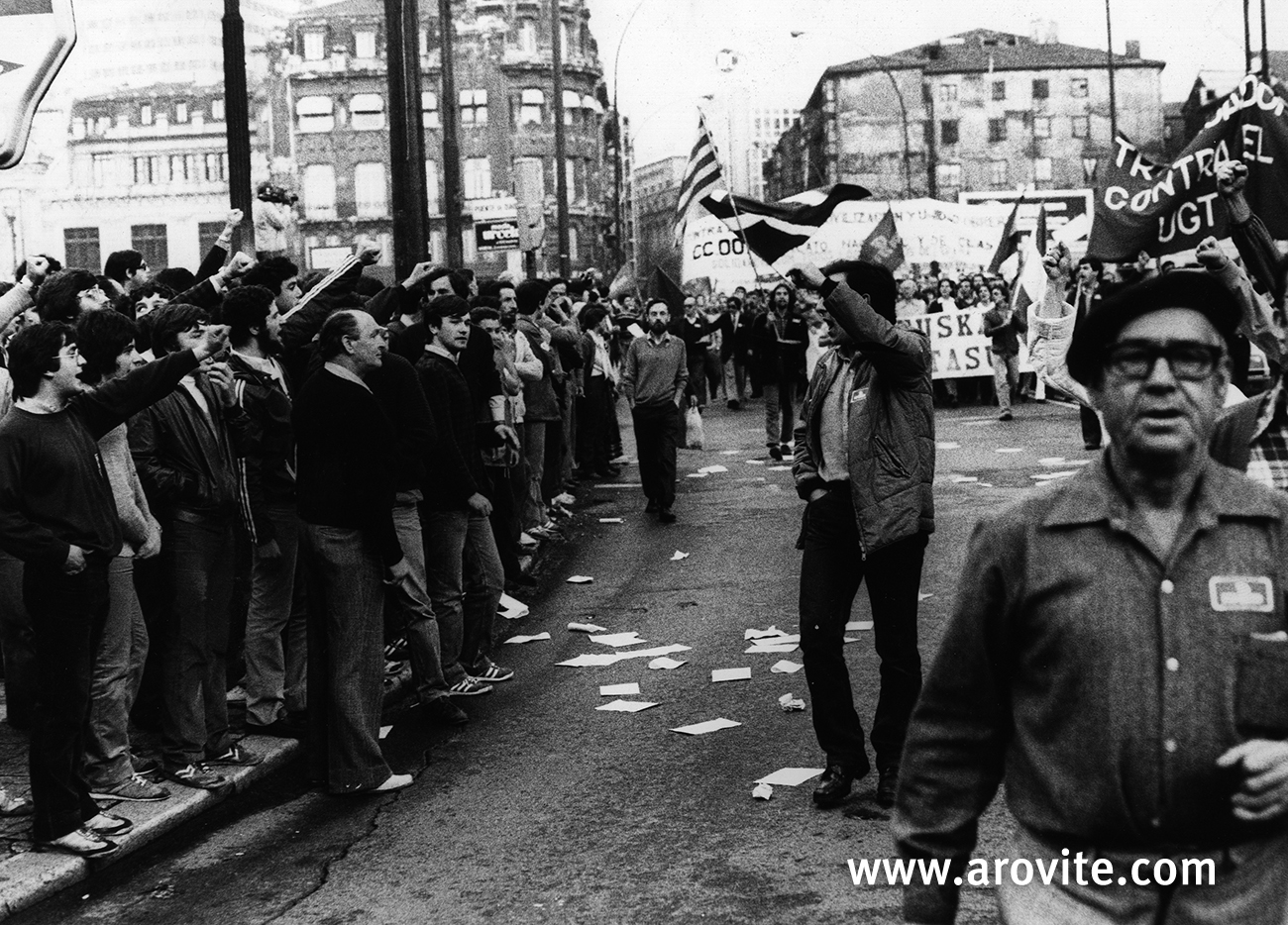
Demonstration against terrorism, which was organized by PSE-PSOE and PCE-EPK. Incidents with sympathizers of radical Basque nationalism. Bilbao, 9/07/1980. AMB, Collection of La Gaceta del Norte.
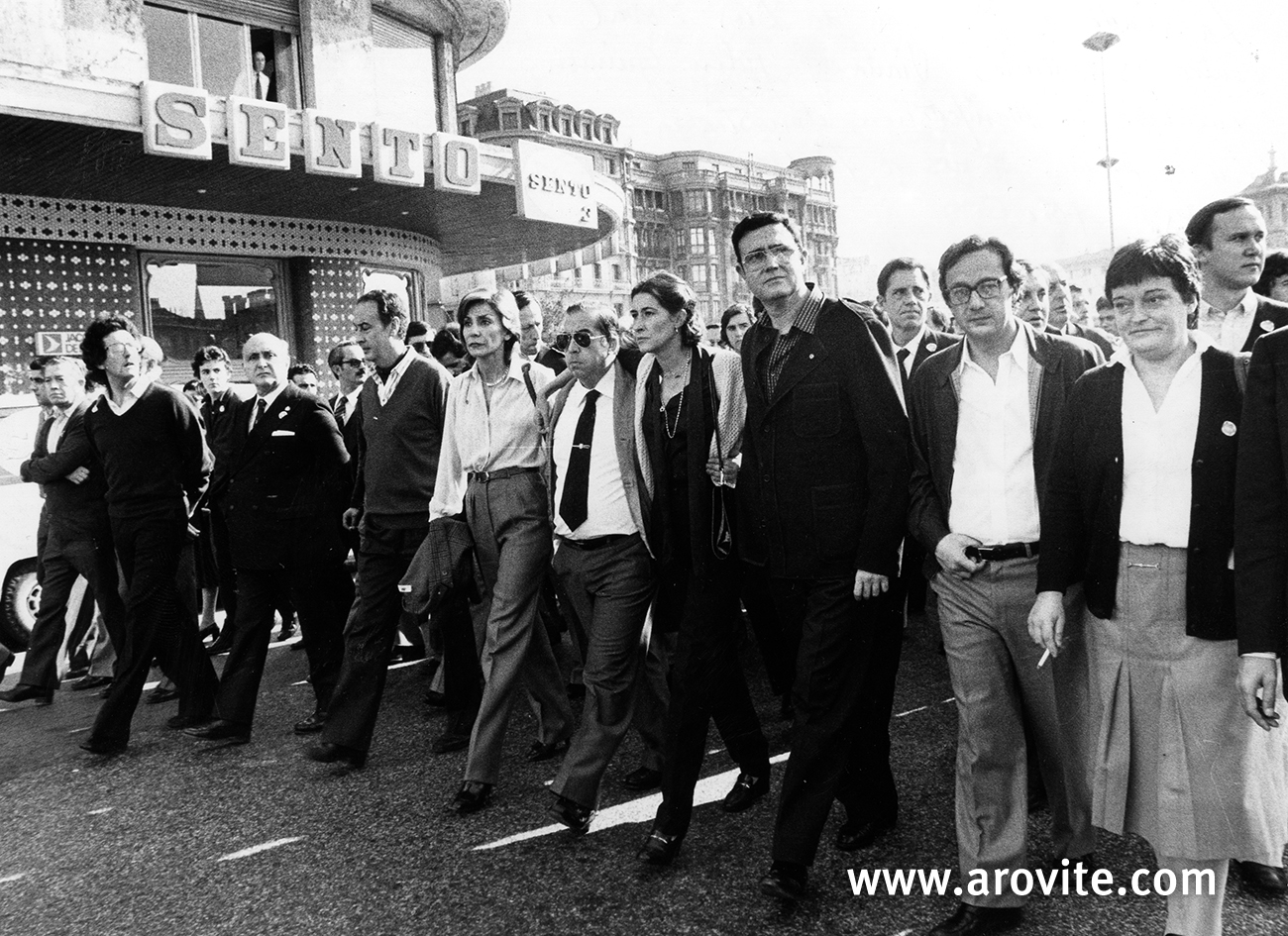
The widow of Juan de Dios Doval, together with the leaders of UCD Jesús María Viana and Julen Guimón, led the demonstration against the assassination of the leader of UCD carried out by ETApm. In the same picture we see Txiki Benegas, general secretary of PSE-PSOE. San Sebastián, 4/11/1980. AMB, Collection of La Gaceta del Norte.
1981
Elected members of HB sang Eusko gudariak (Basque fighters) in front of the King in the Casa de Juntas in Gernika.
In February the assassination of the chief engineer of the nuclear power plant of Lemóniz, José María Ryan, which was carried out by ETAm, unleashed a wave of protests against terrorism in the Basque Country. We can speak of the largest series of demonstrations of that time.
In the same month Joseba Arregi, member of ETAm, died in the Police station after having been tortured.
Failed coup d’état on the 23rd of February, which was attempted by the reactionary, rebellious soldiers, because of the threat of terrorism, among others. ETApm declared a ceasefire and started its dissolution, which ended halfway through the eighties.
The Association of Victims of Terrorism (AVT) was founded.
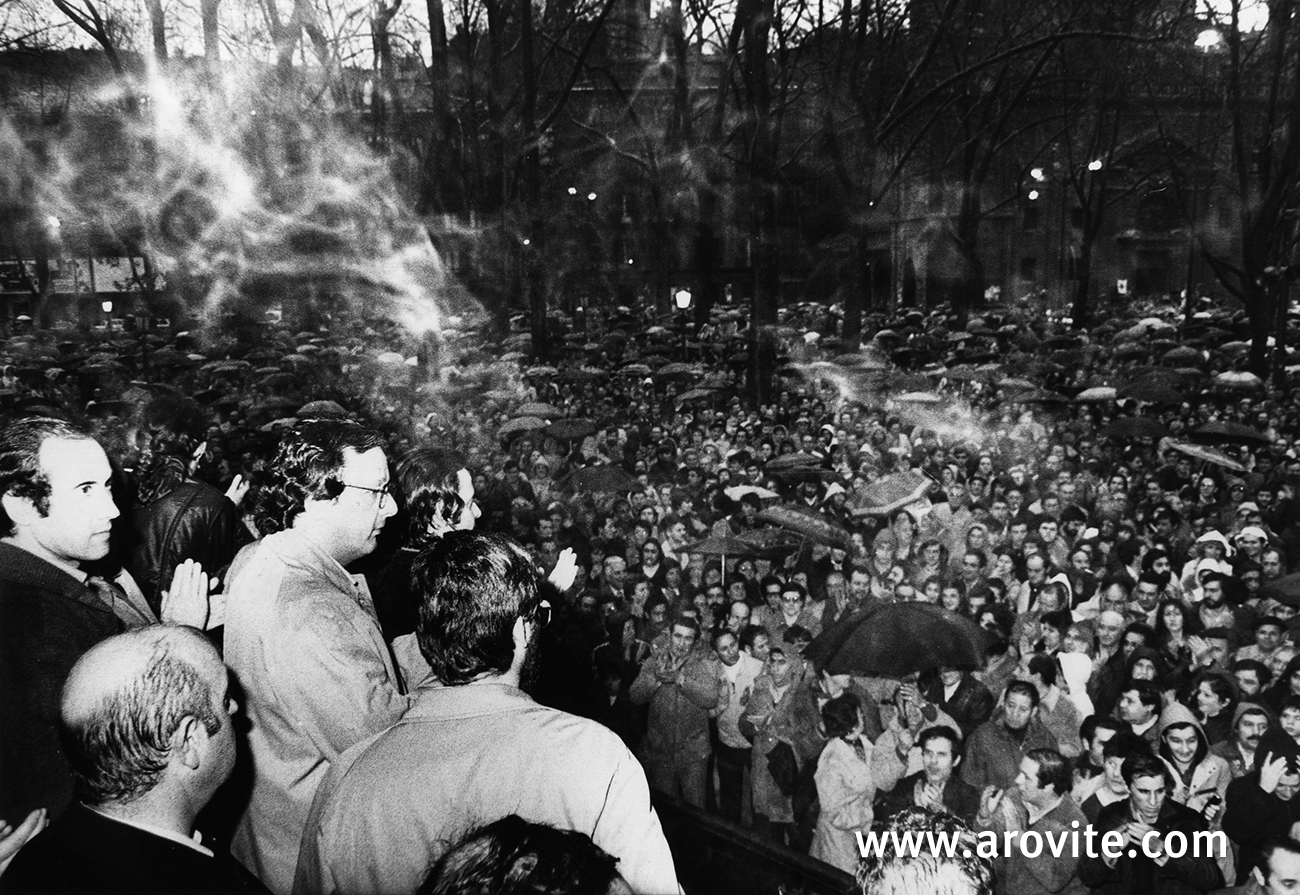
Anti-terrorist demonstration in Bilbao, condemning the assassination of José María Ryan. AMB, Collection of La Gaceta del Norte.
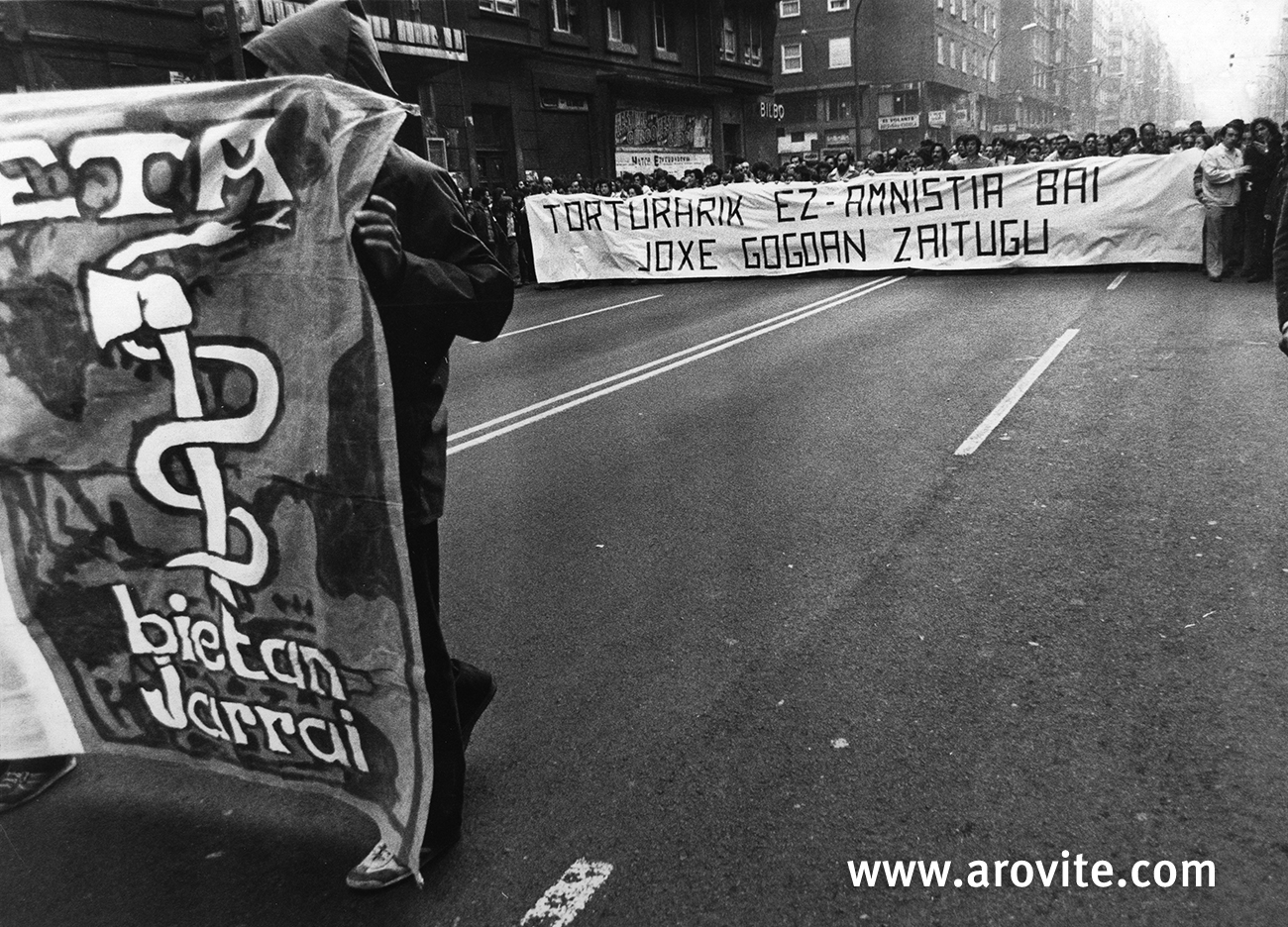
Demonstration for the member of ETAm Joseba Arregi, victim of police torture. Bilbao, 16/02/1981. AMB, Collection of La Gaceta del Norte.
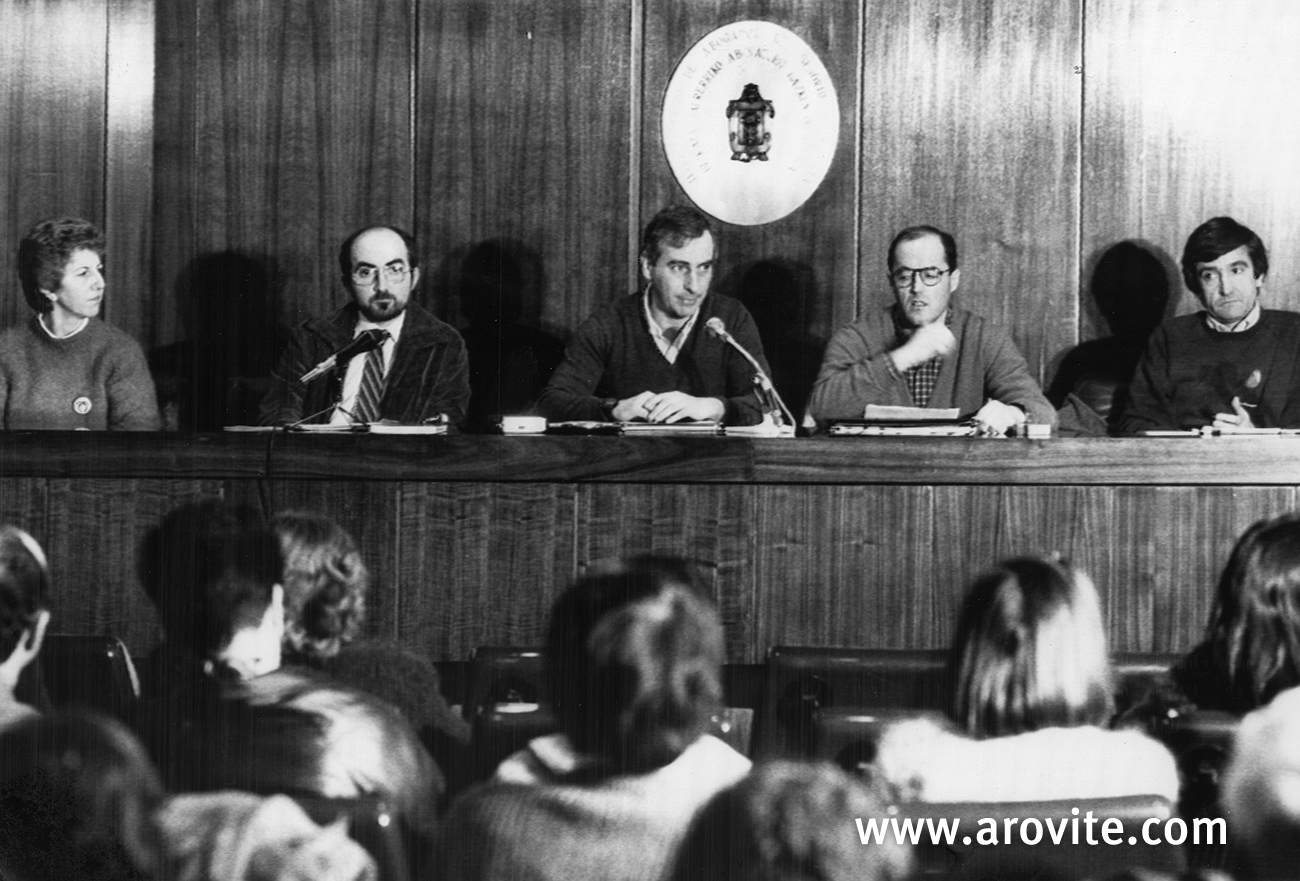
Chat debate of Gestoras Pro Amnistía about the subject of torture, in remembrance of the anniversary of the death of Joseba Arregi, 1/02/1985. AMB, Collection of La Gaceta del Norte.
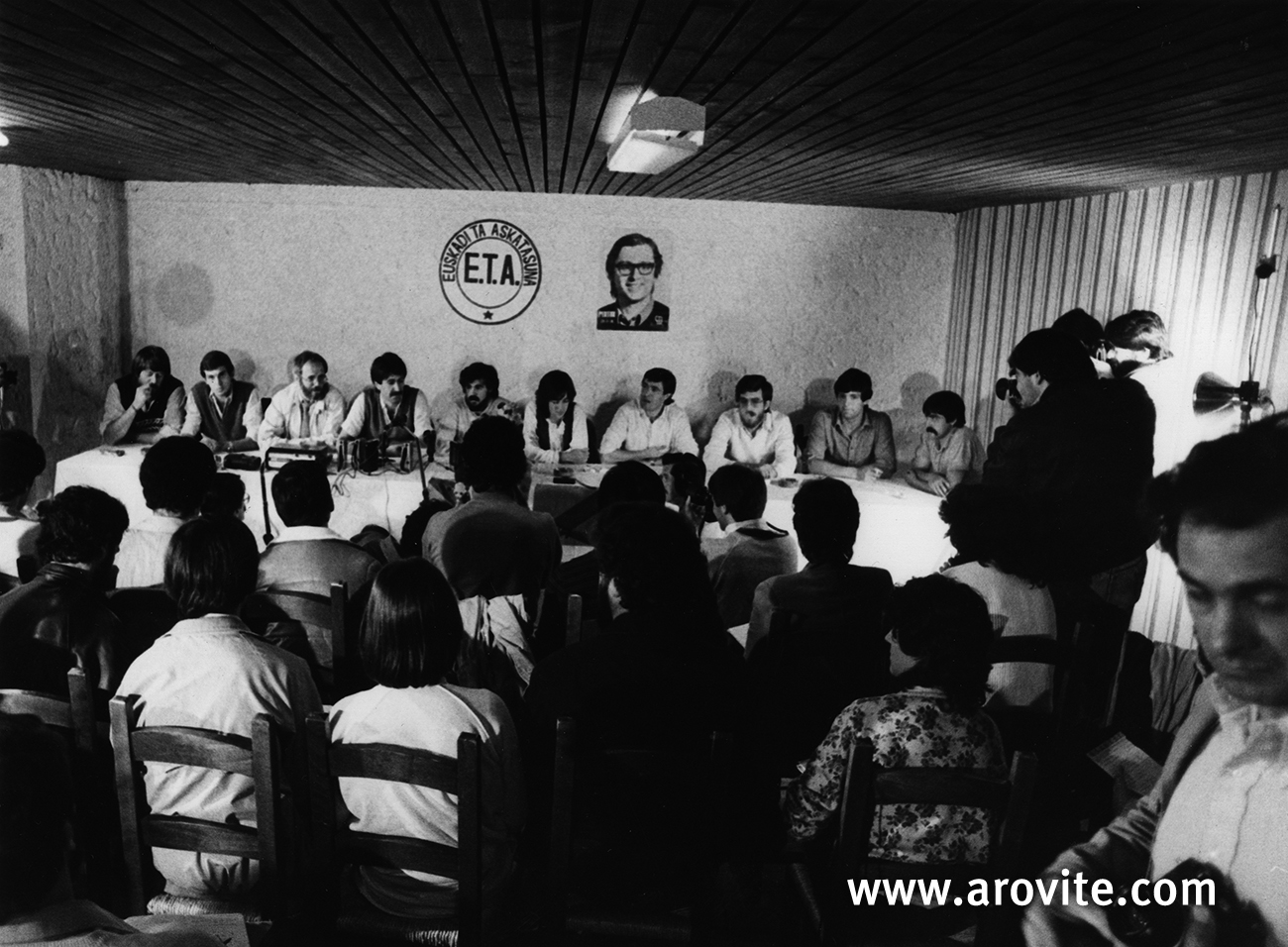
Members of the Seventh Assembly of political-military ETA announced their self dissolution as an armed group in a place somewhere in the south of France, 30/09/1982. In the picture, Miren Alkorta is reading a statement, which announces this decision. AMB, Collection of La Gaceta del Norte.
1982
The construction of the nuclear power plant of Lemóniz stopped in May after the chief engineer, Ángel Pascual, had been killed by ETA.
Approval of the Amejoramiento del Régimen Foral de Navarra (Act of Improvement of the Foral Regime of Navarre), which established an autonomous community, as opposed to the administrative union which was advocated by the abertzale forces.
Absolute majority for the PSOE in the general elections of October.
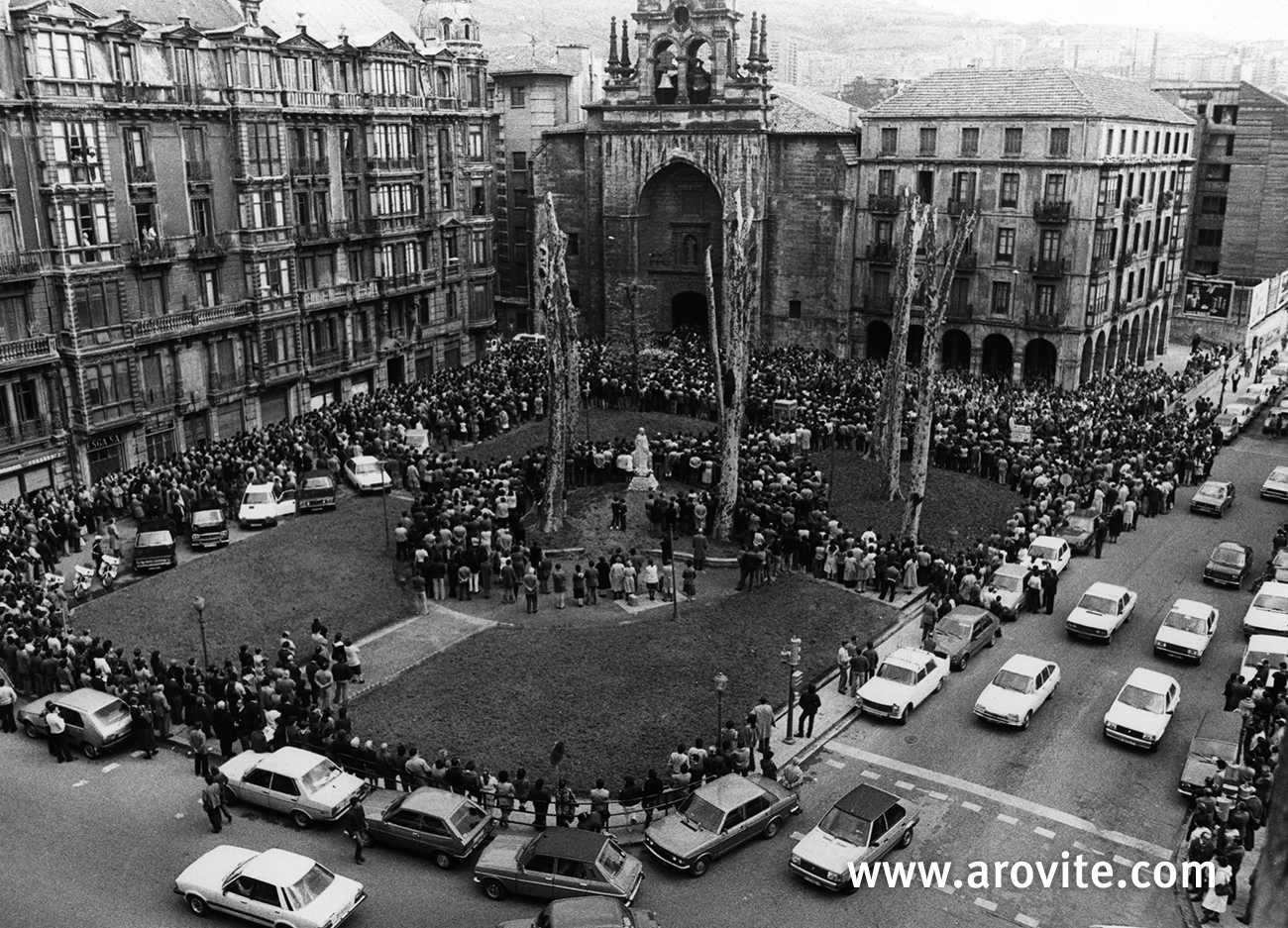
Ángel Pascual, chief engineer of the nuclear power plant of Lemóniz, killed by ETA. Meeting in Jardines de Albia, Bilbao, in front of the church where the funeral was held, 6/05/1982.
1983
First assassinations committed by the GAL, which were terrorist groups created by request of the Government to fight ETA by means of the so-called «dirty war». This groups stayed active until 1987 and killed 27 people.
In October the army medical officer Alberto Martín Barrios was kidnapped and assassinated in Galdakao by ETApm eighth Assembly. The crime caused a lot of protest. A massive protest demonstration was held in Bilbao, in which a placard referred explicitly to the terrorist group: «People against ETA».
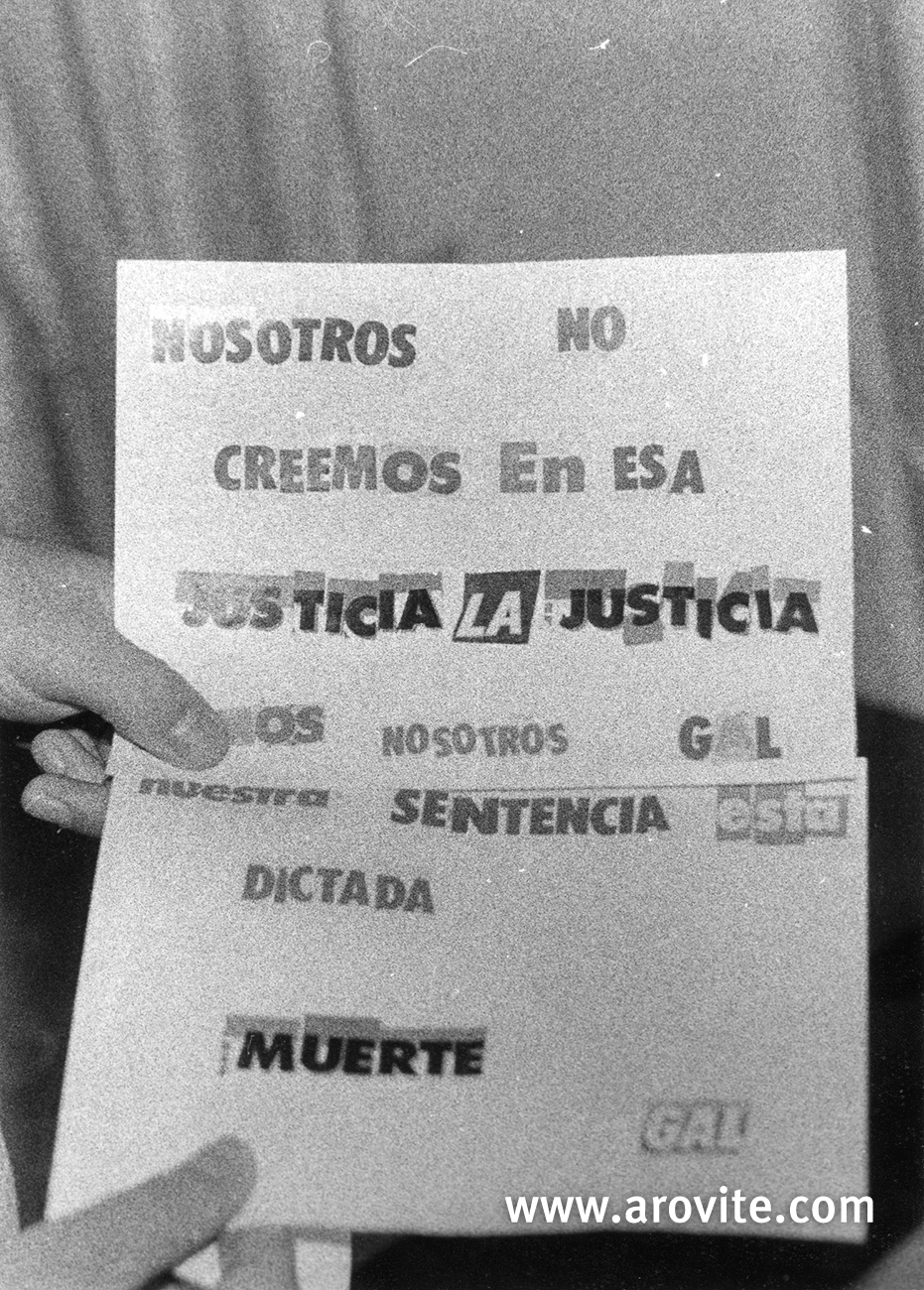
Threatening letter from the GAL to José M. Martínez Beiztegi because of his alleged connection with ETA, 12/06/1985. AMB, Collection of La Gaceta del Norte.
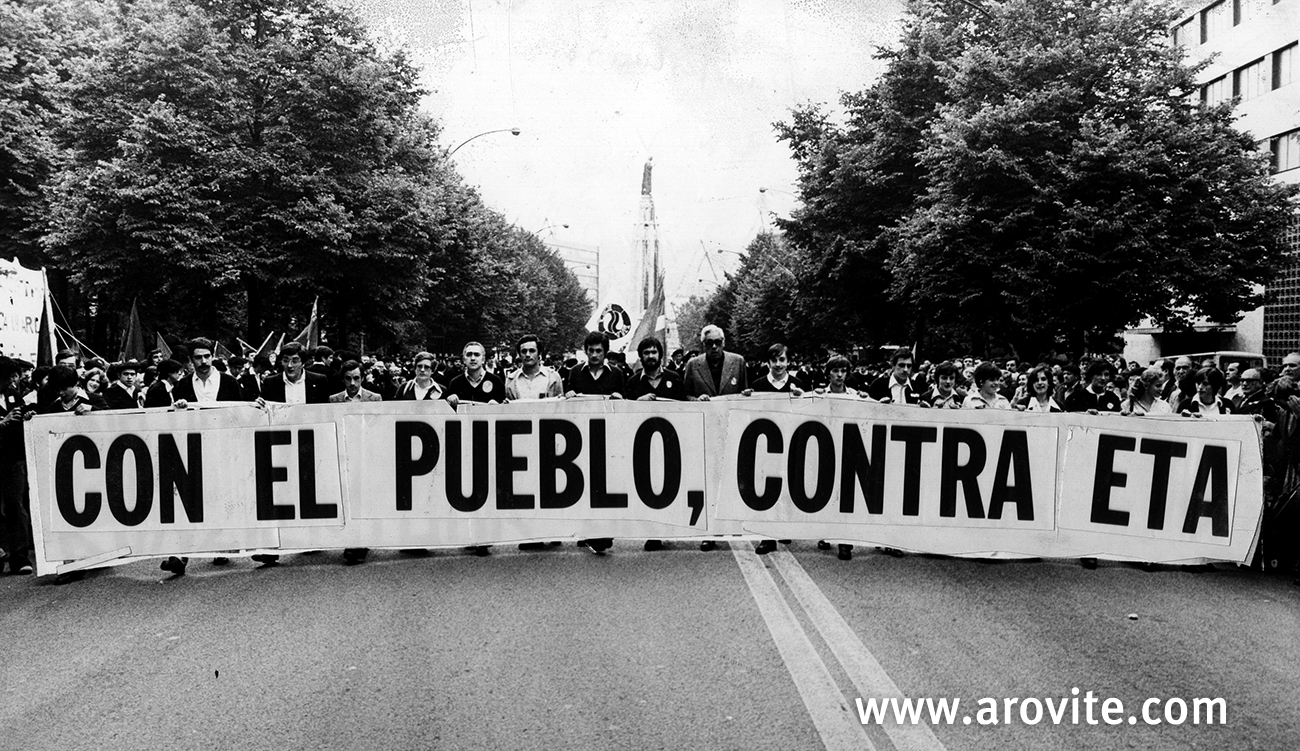
Bilbao, 23/10/1983: head of the anti-terrorist demonstration held after Alberto Martín Barrios had been killed.
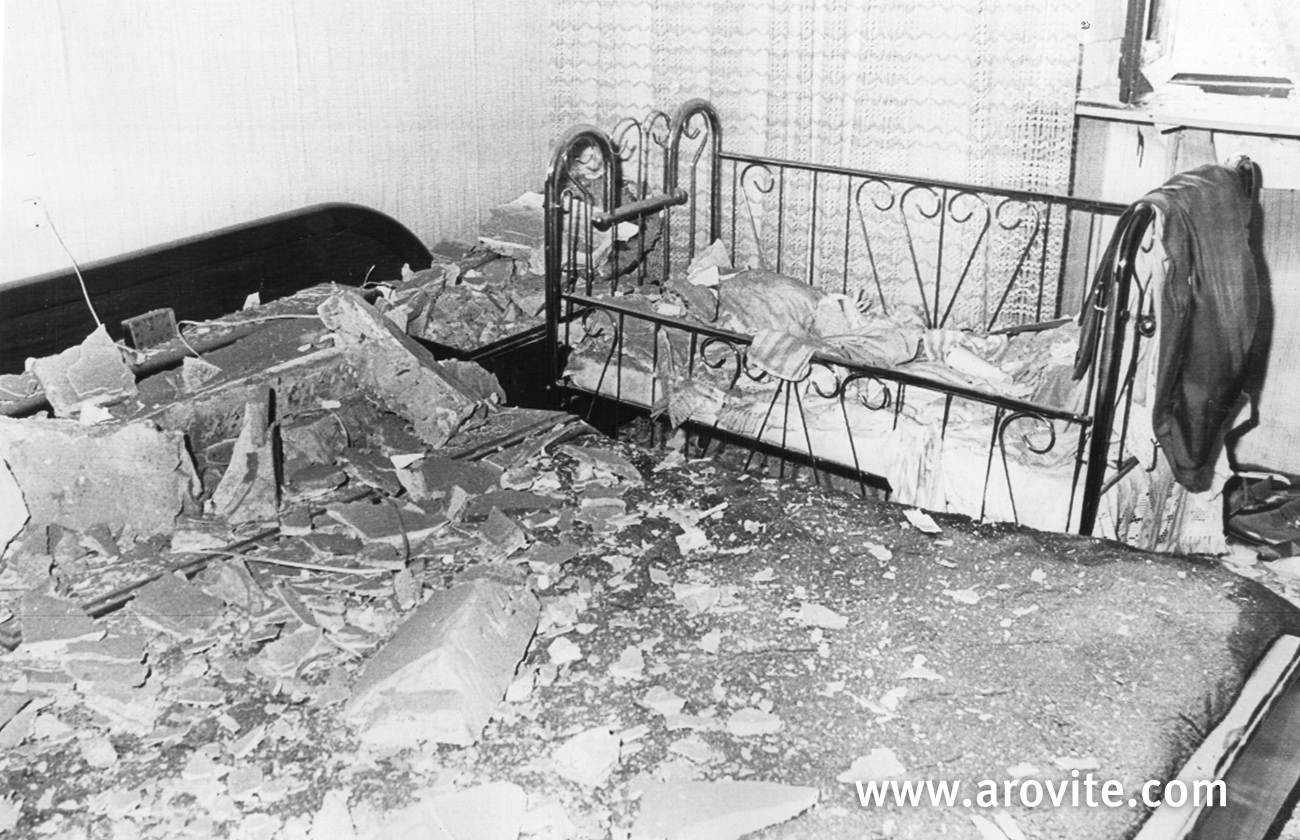
Room in the headquarters of the Civil Guard of Lekunberri, Navarre, attacked with grenades by several members of ETA. AMB, Collection of La Gaceta del Norte.
1984
The French Government collaborated closely with the Spanish Government and started with the extradition of members of ETA.
The GAL killed the leader of HASI and HB Santiago Brouard in Bilbao in November.
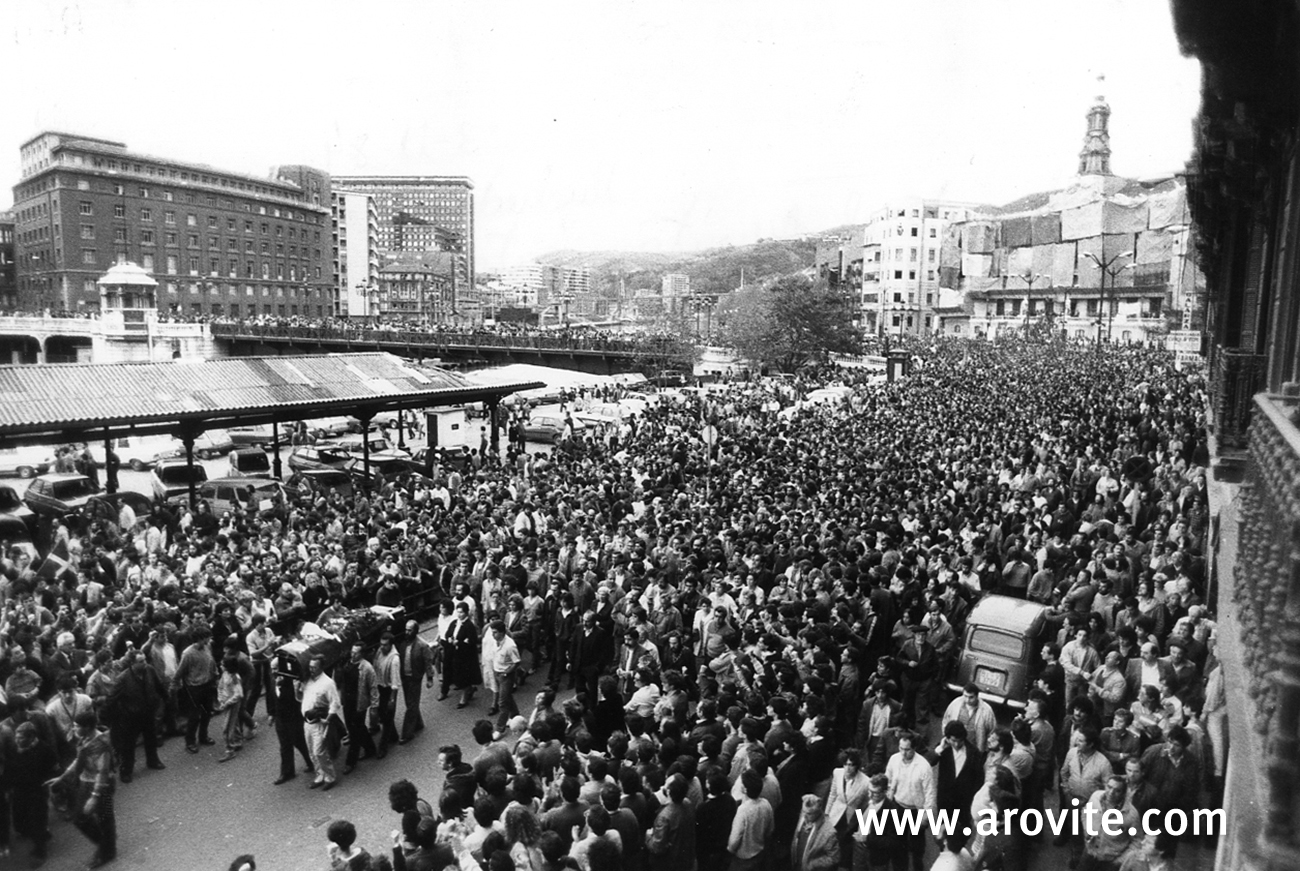
The crowd saying goodbye to Santiago Brouard in front of the City Hall of Bilbao, 23/11/1984. AMB, Collection of La Gaceta del Norte.
1985
The last members of ETApm returned to Spain.
The GAL killed four people, all militants of ETA, in the bar Monbar in Bayonne.
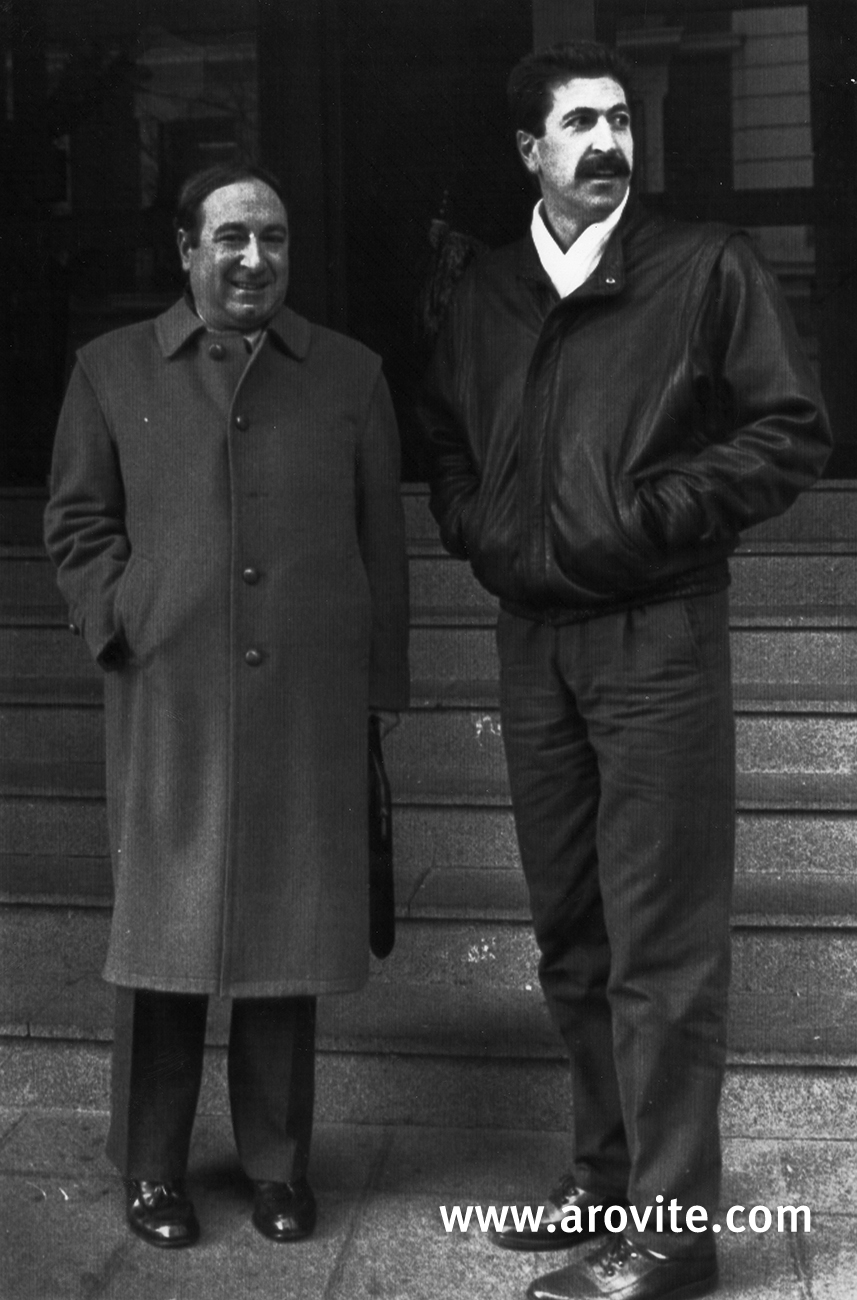
Joseba Aulestia (Zotza), the last leader of the Seventh Assembly of ETApm, which had already come to an end, returned from France to Spain, 14/01/1985. With his return ended the operation of the social reinsertion of the militants of ETA which had been promoted by the deputy and president of Euskadiko Ezkerra, Juan María Bandrés (on the left of the picture). AMB, Collection of La Gaceta del Norte.
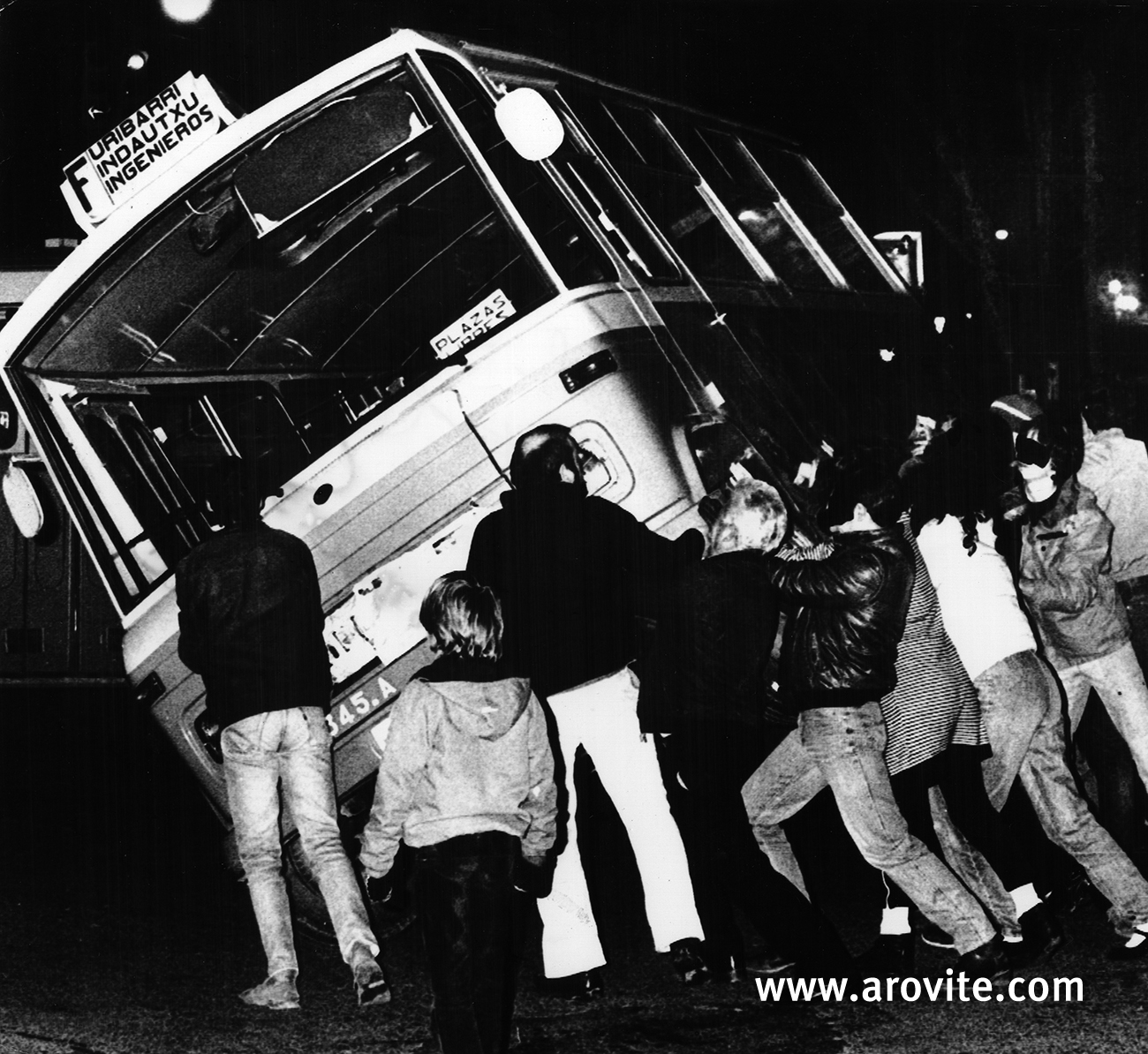
Incidents caused by people who were demonstrating in support of amnesty for the prisoners of ETA, 7/01/1985. AMB, Fondo de La Gaceta del Norte.
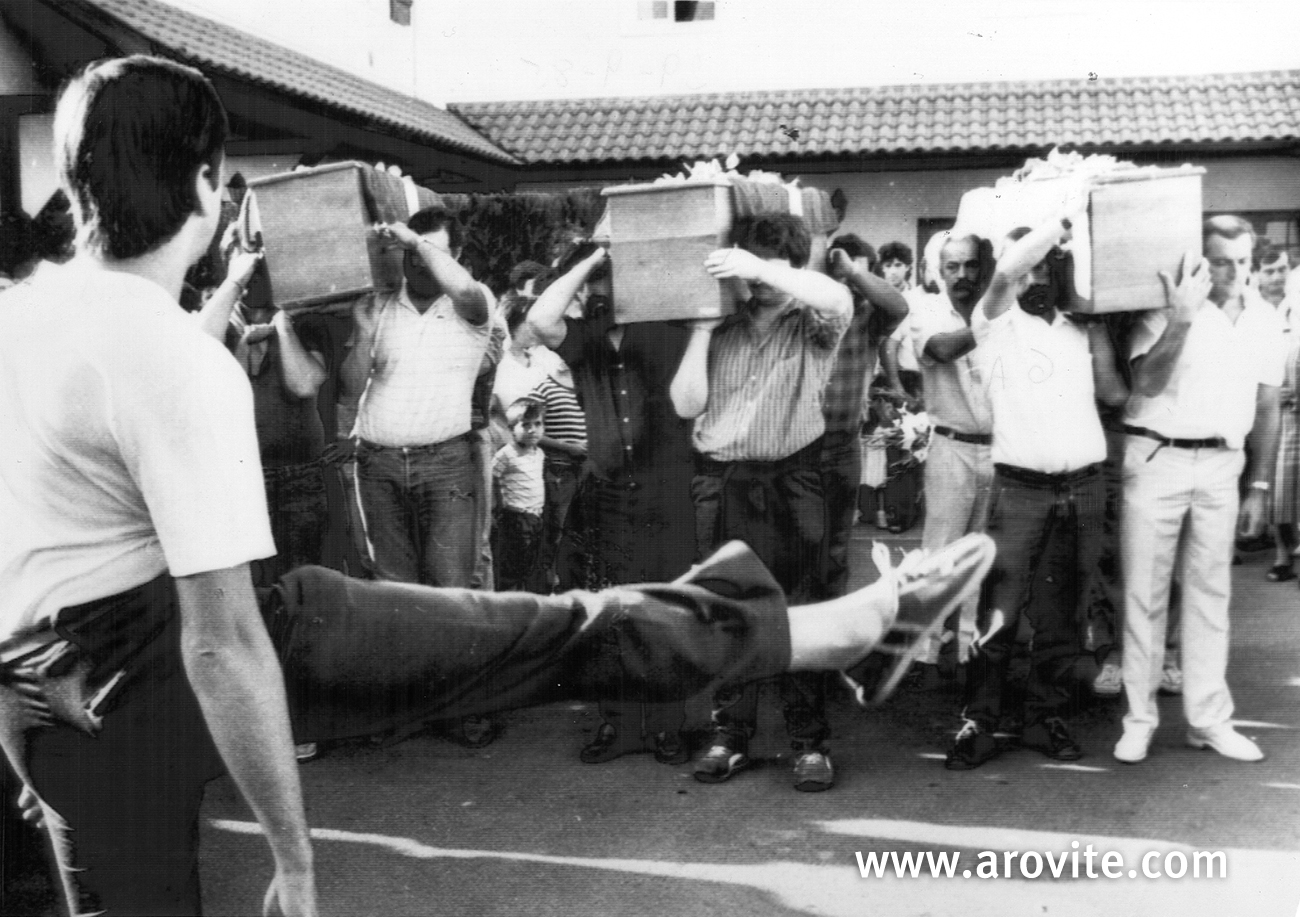
Last tribute to the four members of ETA who were killed by the GAL in the bar Monbar in Bayonne, 28/09/1985. AMB, Fondo de La Gaceta del Norte.
1986
In May the Coordinadora Gesto por la Paz de Euskal Herria (A Gesture for Peace in the Basque Country) was founded, which was an initiative of the civic Basque society with the purpose to hold silent demonstrations after every mortal attack.
ETA was responsible for a massacre in Madrid in July: twelve civil guards were killed by a car bomb on the square of República Dominicana.
In September ETA killed Dolores González Katarain (Yoyes), ex-leader of this organization who had been reinserted.
The anti-terrorist collaboration with France was strengthened: for the terrorists, this was the beginning of the end of the «French sanctuary».
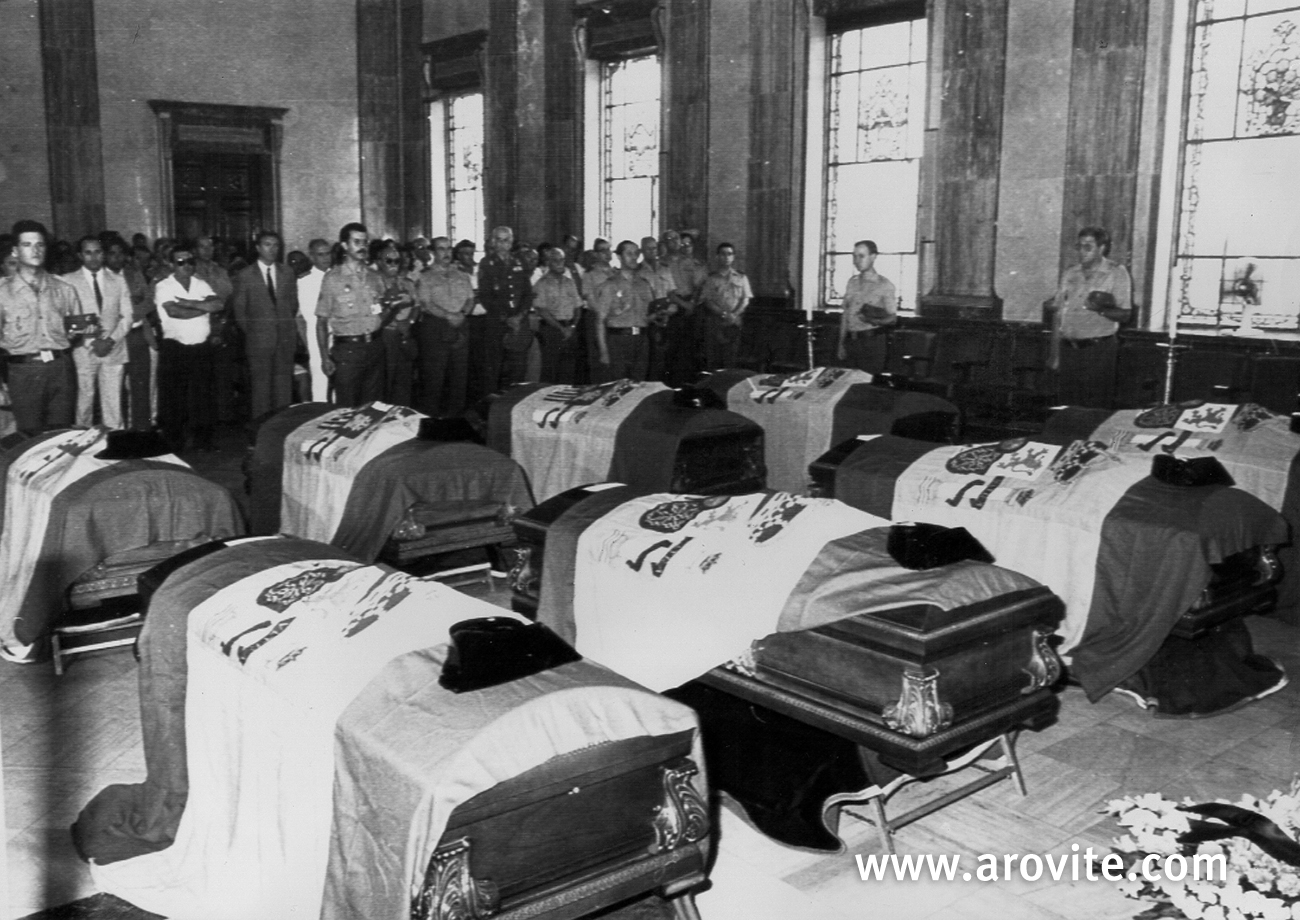
Family and friends of eight of the civil guards who were killed by ETA in an attack on the square of República Dominicana. The funeral chapel was set up in the General Management of the Civil Guard. Madrid, 14/07/1986. AMB, Collection of La Gaceta del Norte.
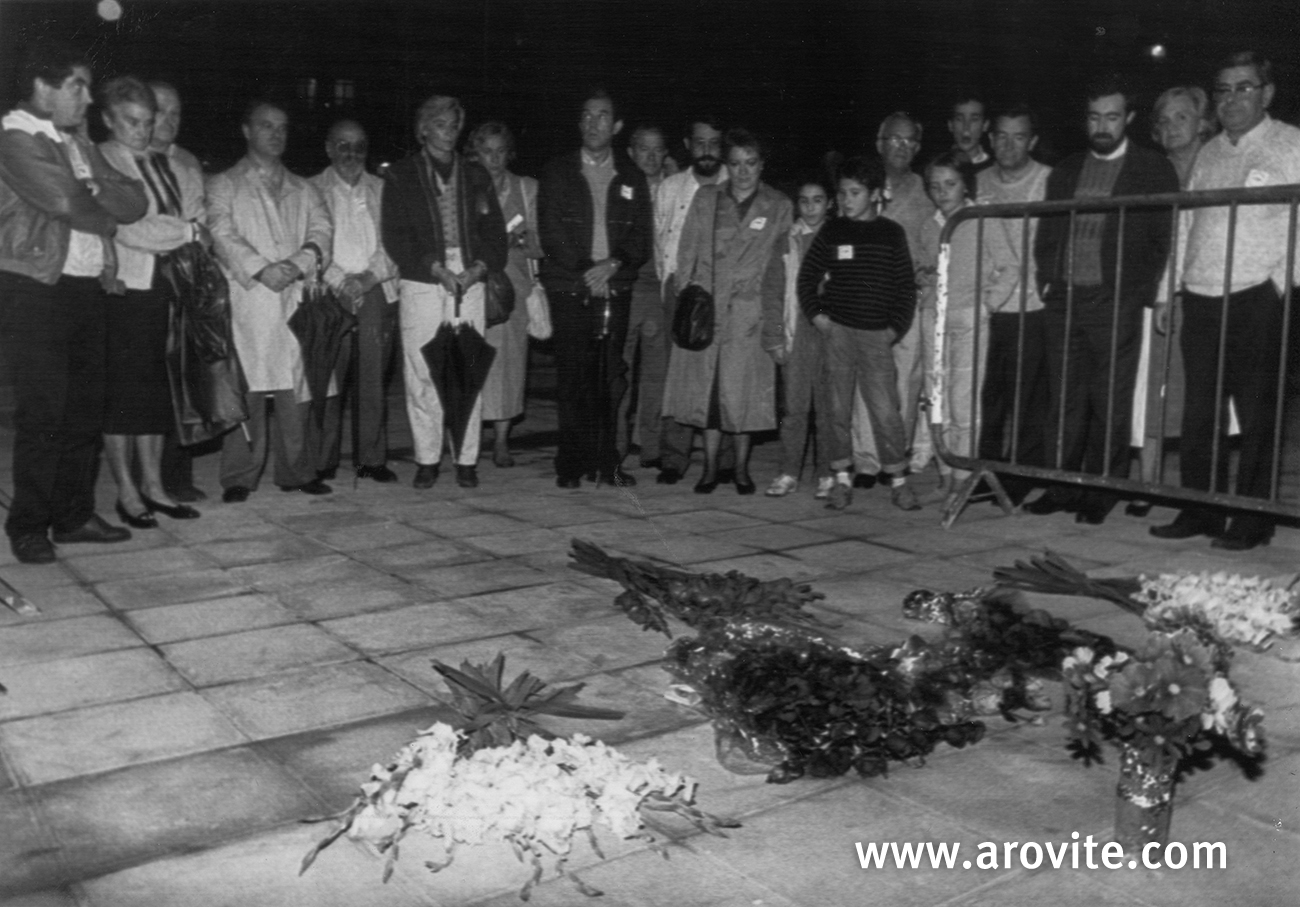
The ex-lehendakari (former President of the Basque Government) Carlos Garaikoetxea and his wife, Sagrario Mina, together with other leaders of Eusko Alkartasuna, which was the formation he led, were going to the place where ETA killed Dolores González Katarain (Yoyes), on the occasion of the tribute in her memory. Ordizia, 18/10/1986. AMB, Collection of La Gaceta del Norte.
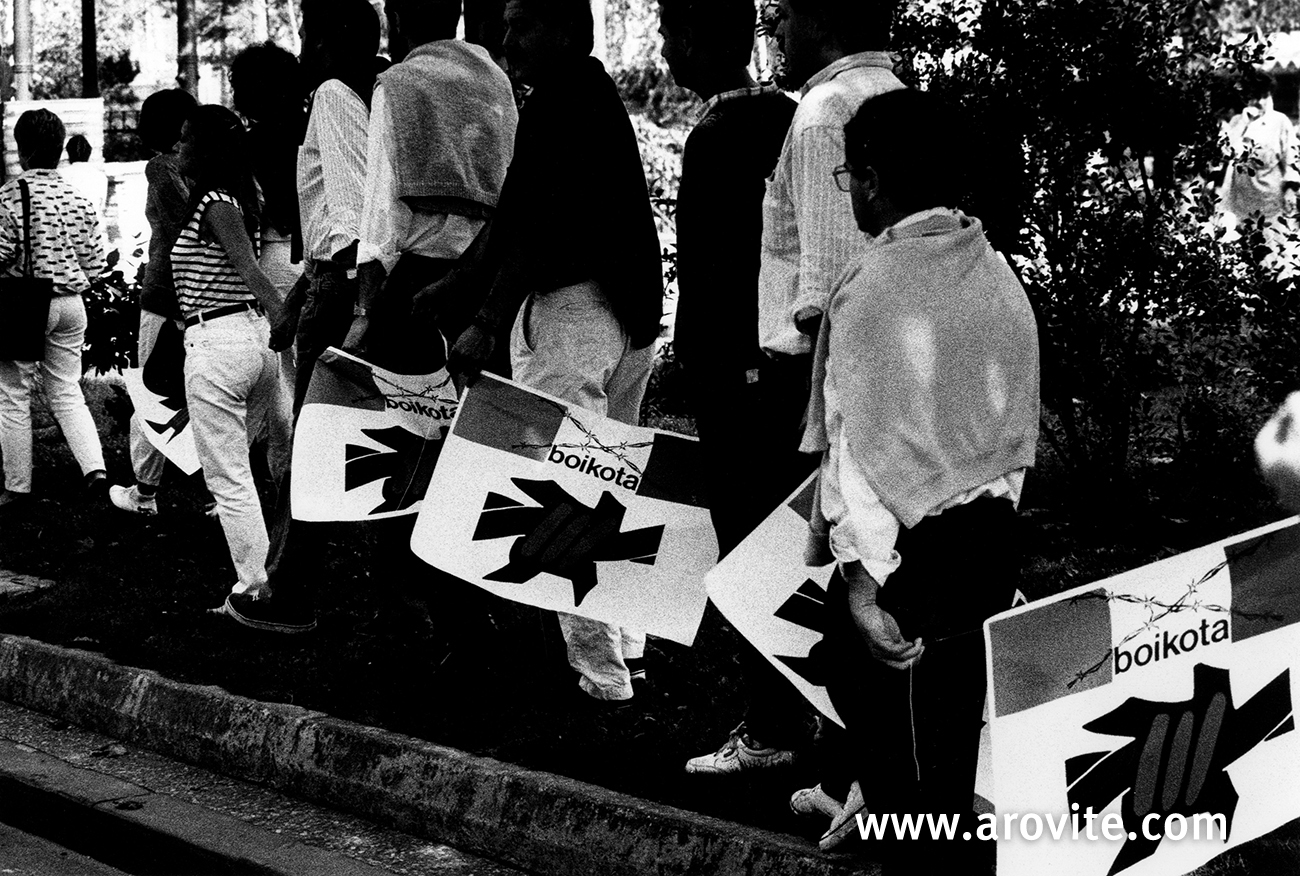
Demonstration against the extradition of members of ETA from France to Spain in San Sebastián, 6/03/1987. Demonstrators asked for a boycott of France. AMB, Collection of La Gaceta del Norte.
1987
HB obtained its best results in history in the elections for the European Parliament in June, with the help of the extreme left in Spain (Movimiento Comunista, Communist Movement, and the Liga Comunista Revolucionaria, Revolutionary Communist League): 363.000 votes and one member of the Parliament.
Only a few days after the elections, the explosion of a car bomb, which was located in the shopping mall Hipercor de Barcelona, caused the death of 21 people. This became the biggest attack in the history of ETA.
Another car bomb of ETA against the headquarters of the Civil Guard of Zaragoza killed 11 people in December.
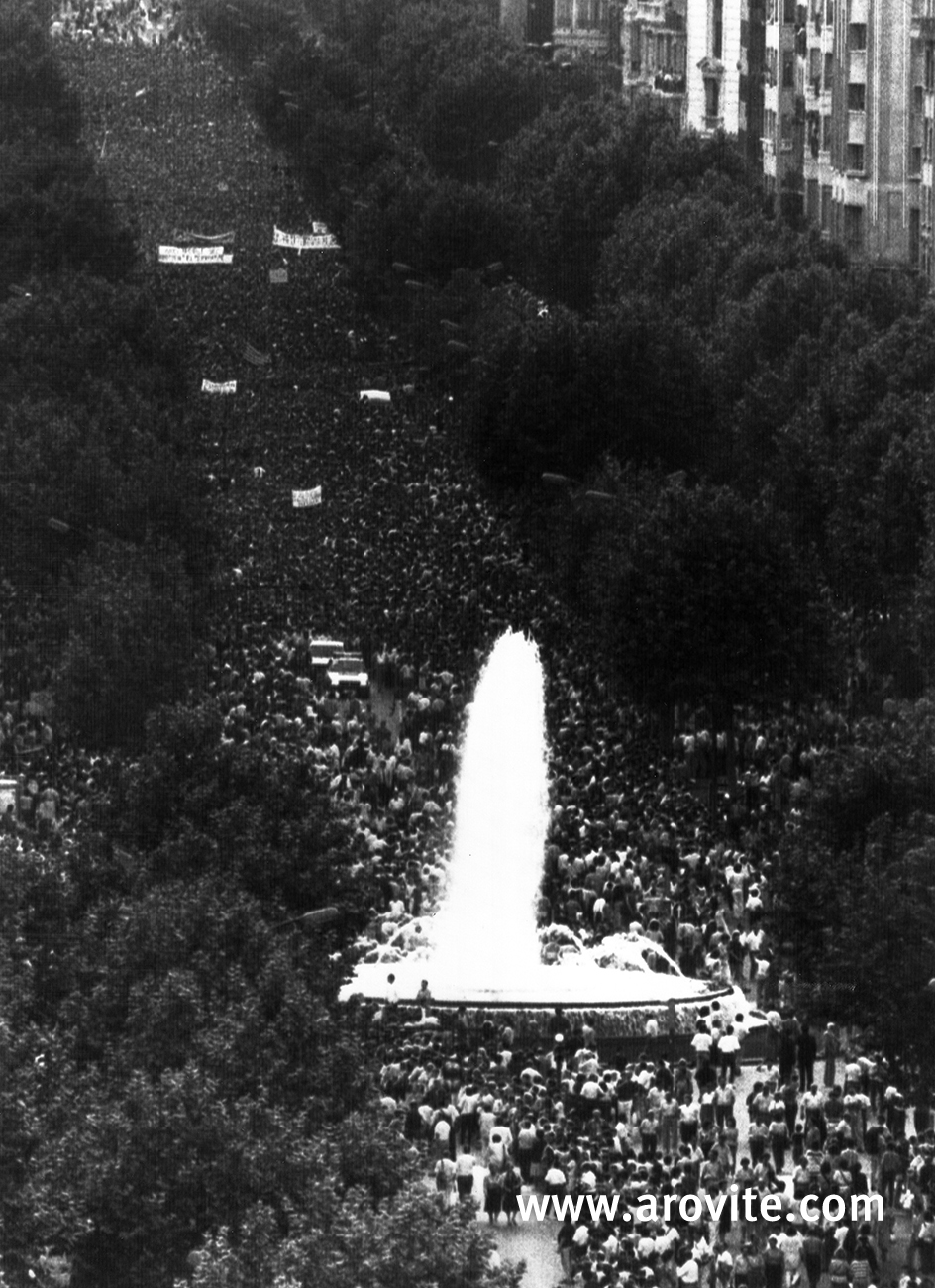
Massacre in Hipercor at the hands of ETA. Air view of the massive protest demonstration. Barcelona, 22/06/1987. AMB, Collection of La Gaceta del Norte.
1988
In January the Basque democratic parties signed the Agreement for the Normalization and Pacification of the Basque Country, better known as the Pact of Ajuria Enea.
The parallel agreements of Madrid (November, 1987) and Navarre (October, 1988) set the base for a minimal consensus to deal with terrorism at a political level.
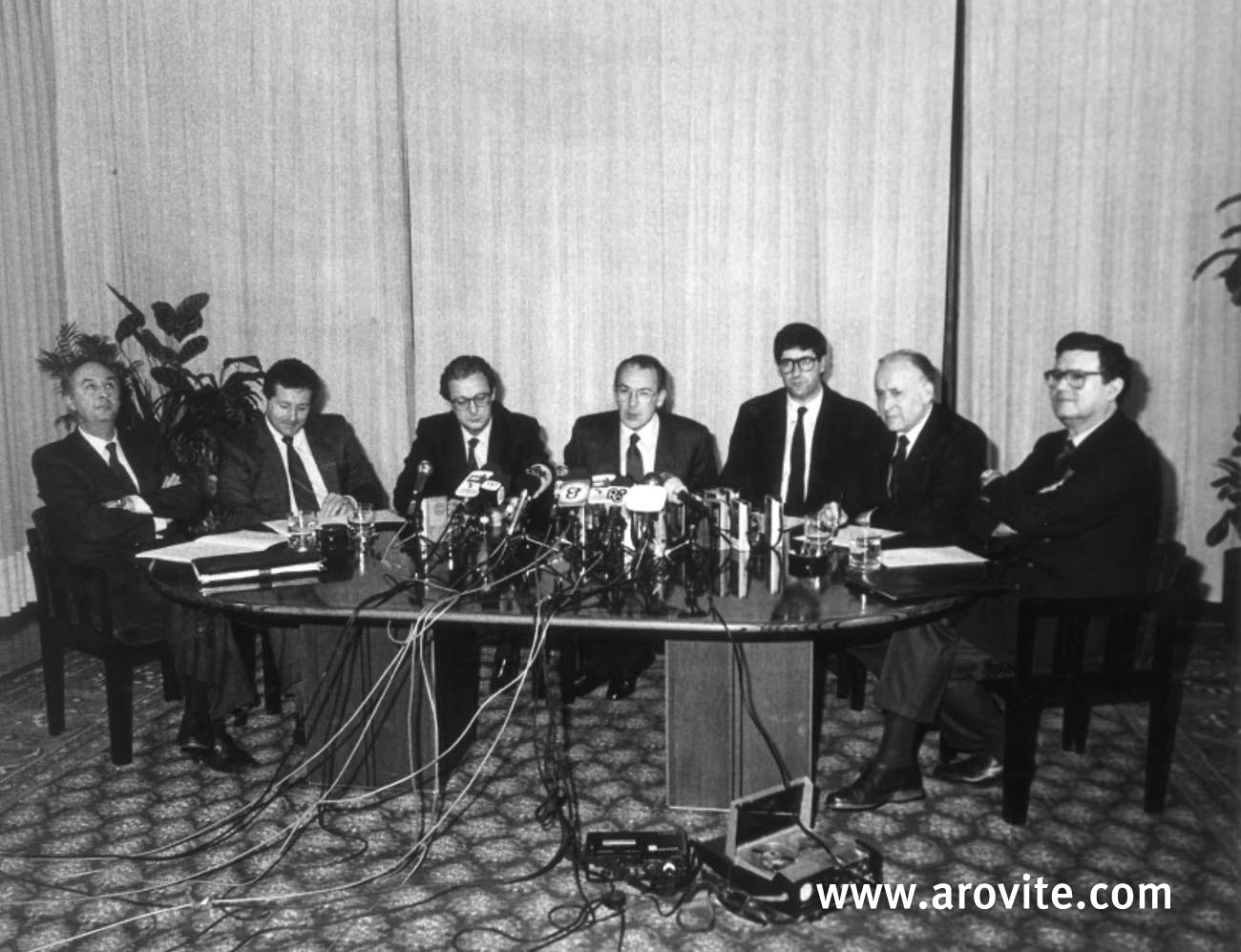
The signing of the Agreement for the Pacification of the Basque Country (Pact of Ajuria Enea). From left to right: Alfredo Marco Tabar (CDS), Inaxio Oliveri (EA), José María (Txiki) Benegas (PSE-PSOE), José Antonio Ardanza, lehendakari (President) of the Basque Government, Kepa Aulestia (EE), Xabier Arzalluz (PNV), Julen Guimón (AP). Vitoria, 12/01/1988. Photographer: Eduardo Argote. Archive of El Correo.
1989
ETA declared a ceasefire in January and negotiations were initiated between the terrorist organization and the representatives of the Spanish Government in Argel.
These negotiations were stopped when ETA started killing again. This time the civil guard José Calvo de la Hoz was murdered in April.
In November, extreme rightists killed the MP of HB for Biscay Josu Muguruza in Madrid.
The Spanish Government began with its policy of the dispersion of the prisoners of ETA across the different prisons in Spain.
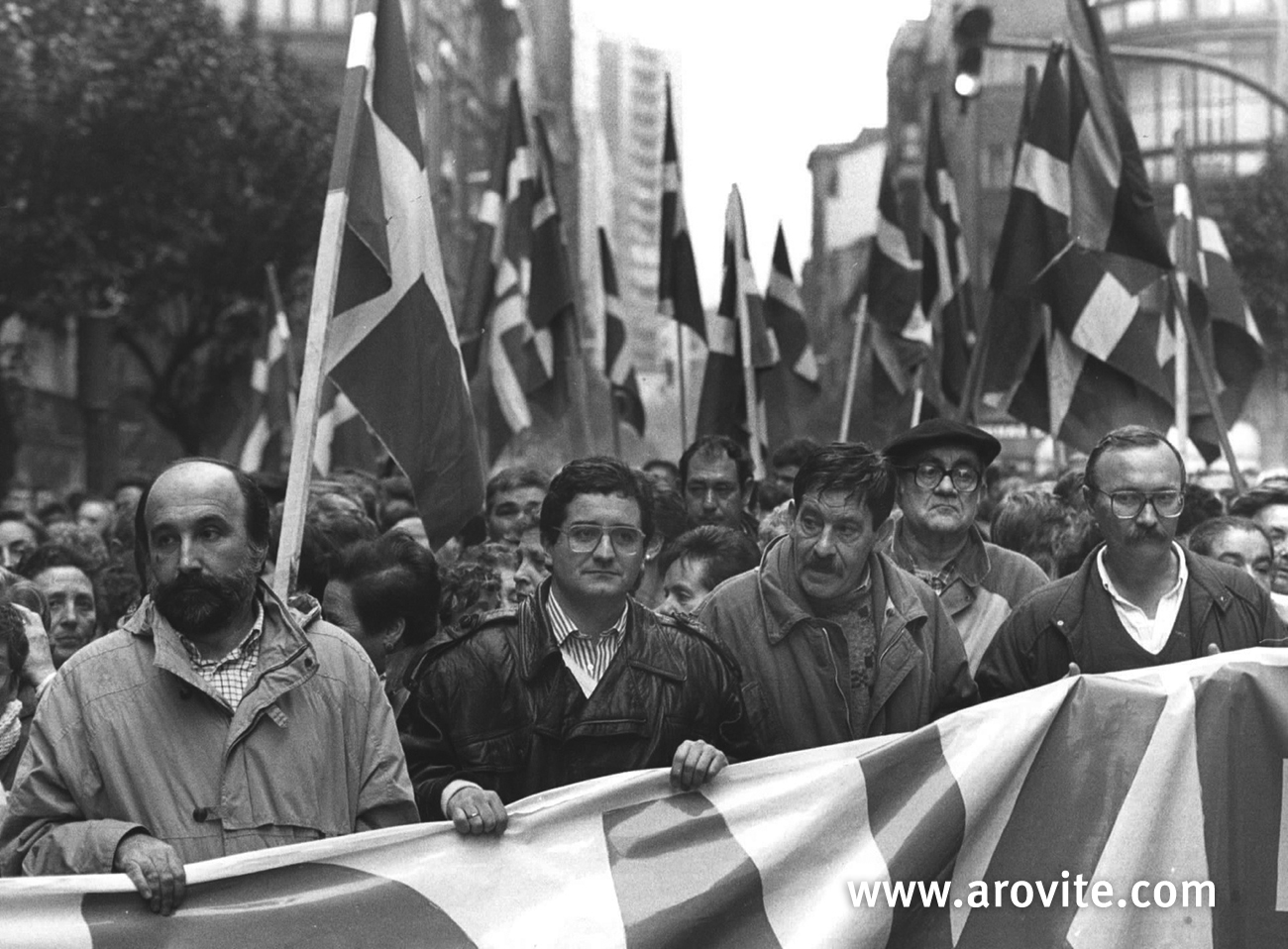
Demonstration in support of the negotiations with ETA, headed by the leaders of the radical Basque nationalist movement Iñaki Esnaola, Txema Montero, Jon Idígoras and Gorka Martínez. Bilbao, 22/01/1989. Archive of El Correo.
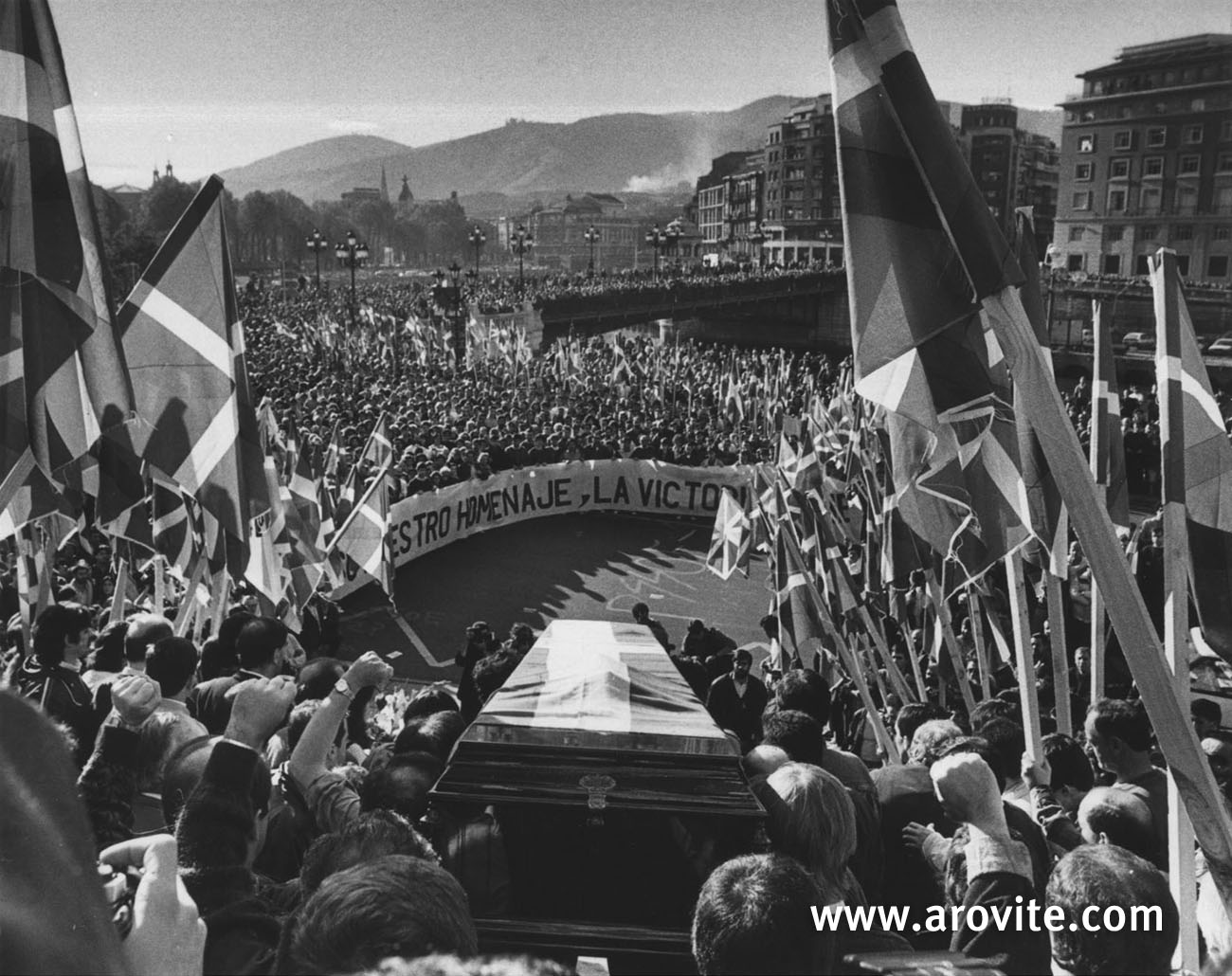
Tribute to the MP Josu Muguruza on the day of his funeral. Muguruza was killed by extreme rightists in Madrid. Bilbao, 23/11/1989. Archive of El Correo.
1992
In March, for the first time, the Police arrested all the leaders of ETA in Bidart (France). ETA ended its campaign against the highway of Leizaran (Pamplona-San Sebastián) because of changes in the outline of the first project, after having killed three people and having committed many attacks.
Elkarri was founded, defined as a «social movement for social dialogue and agreement in Euskal Herria».
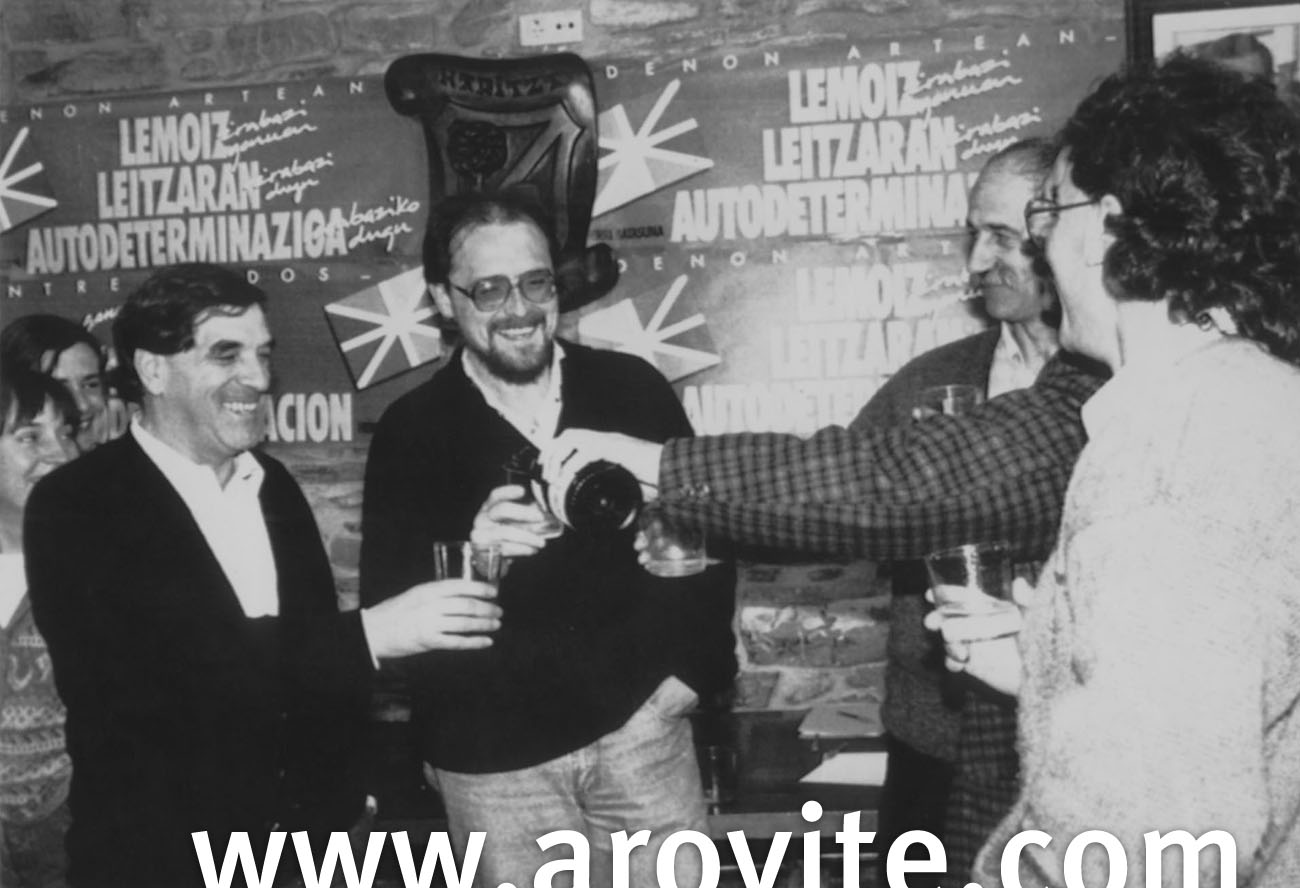
José Luis Elkoro (left), José María Olarra (right) and two other members of HB, celebrating the modification of the outline of the highway of Leizaran. San Sebastián, 22/04/1992. Photographer: Villagrán. Archive of El Correo.
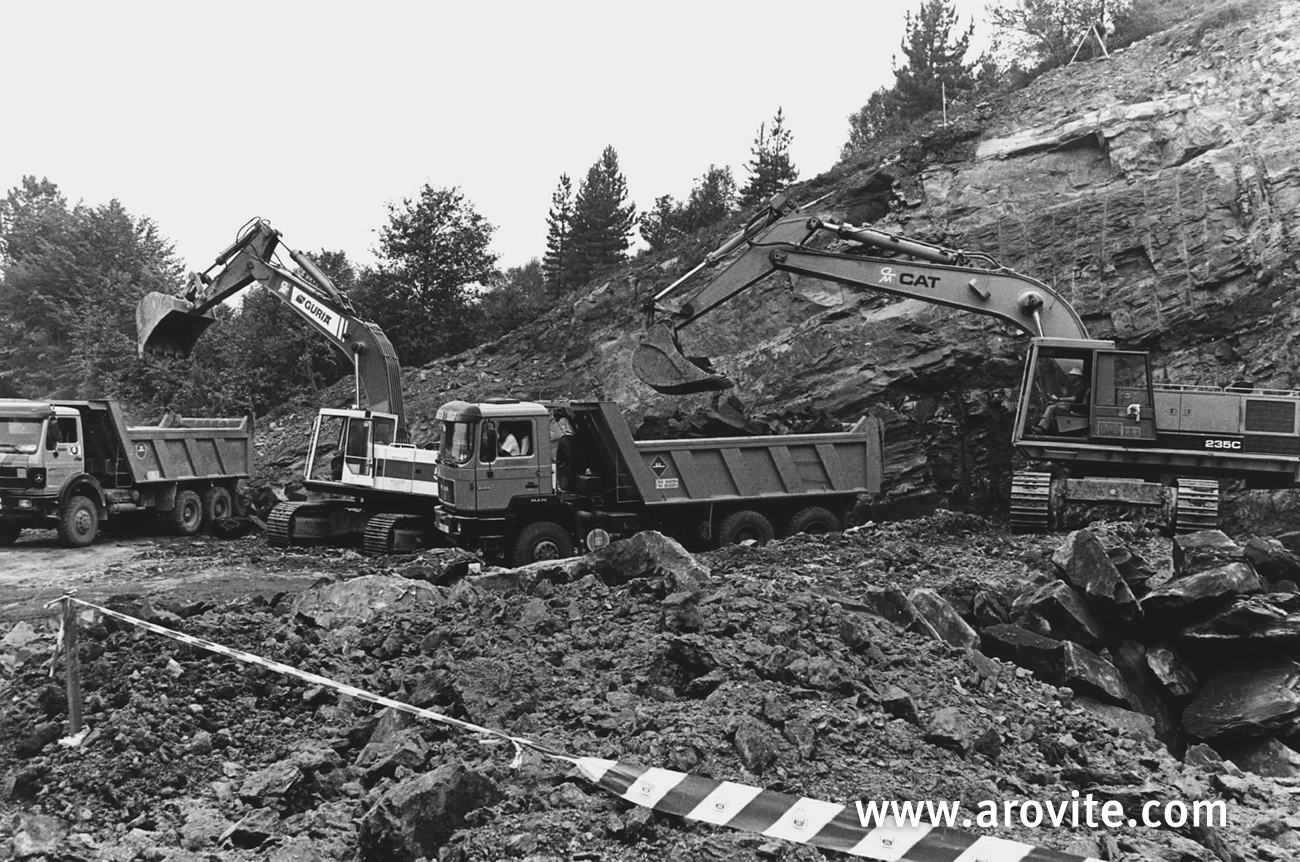
Works on the highway of Leizaran on the hill of San Lorenzo, Gipuzkoa, 14/08/1992. Photographer: Javier Mingueza. Archive of El Correo.
1993
HB hit the bottom in the general elections of June. Only two MP’s of HB were elected, in comparison to its five deputies in the Third Legislature (1986-1989).
Gesto por la Paz started a campaign of continuing protests to claim the liberation of the people kidnapped by ETA, who were Julio Iglesias Zamora, José María Aldaia, Cosme Delclaux and José Antonio Ortega Lara. The blue bow became the symbol of the campaign.
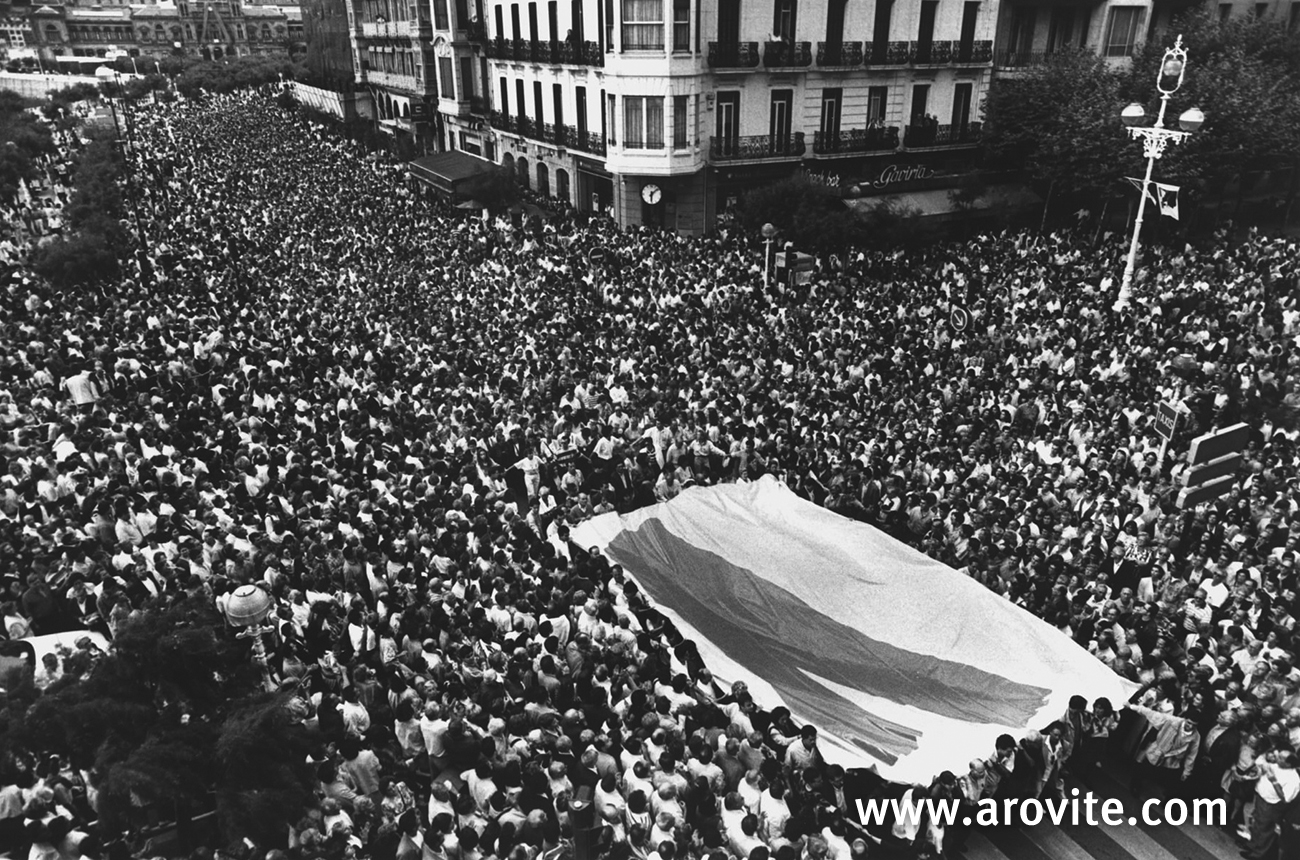
Mass demonstration, which was organized by Gesto por la Paz to claim the liberation of Julio Iglesias Zamora, a business owner who was kidnapped by ETA. At the front of the march people were holding a big blue bow, a new symbol for peace in the Basque Country. San Sebastián, 12/09/1993.
1994
The document Oldartzen drew the new political line of HB and gave the green light for the kale borroka (street violence), within a strategy of «socialization of the suffering».
1995
In January ETA assassinated the leader of the Basque PP and deputy mayor of San Sebastián, Gregorio Ordóñez.
ETA promoted its «Democratic Alternative», another version of «KAS alternative», searching for the union of the abertzale forces to achieve self-determination for the people of the Basque Country.
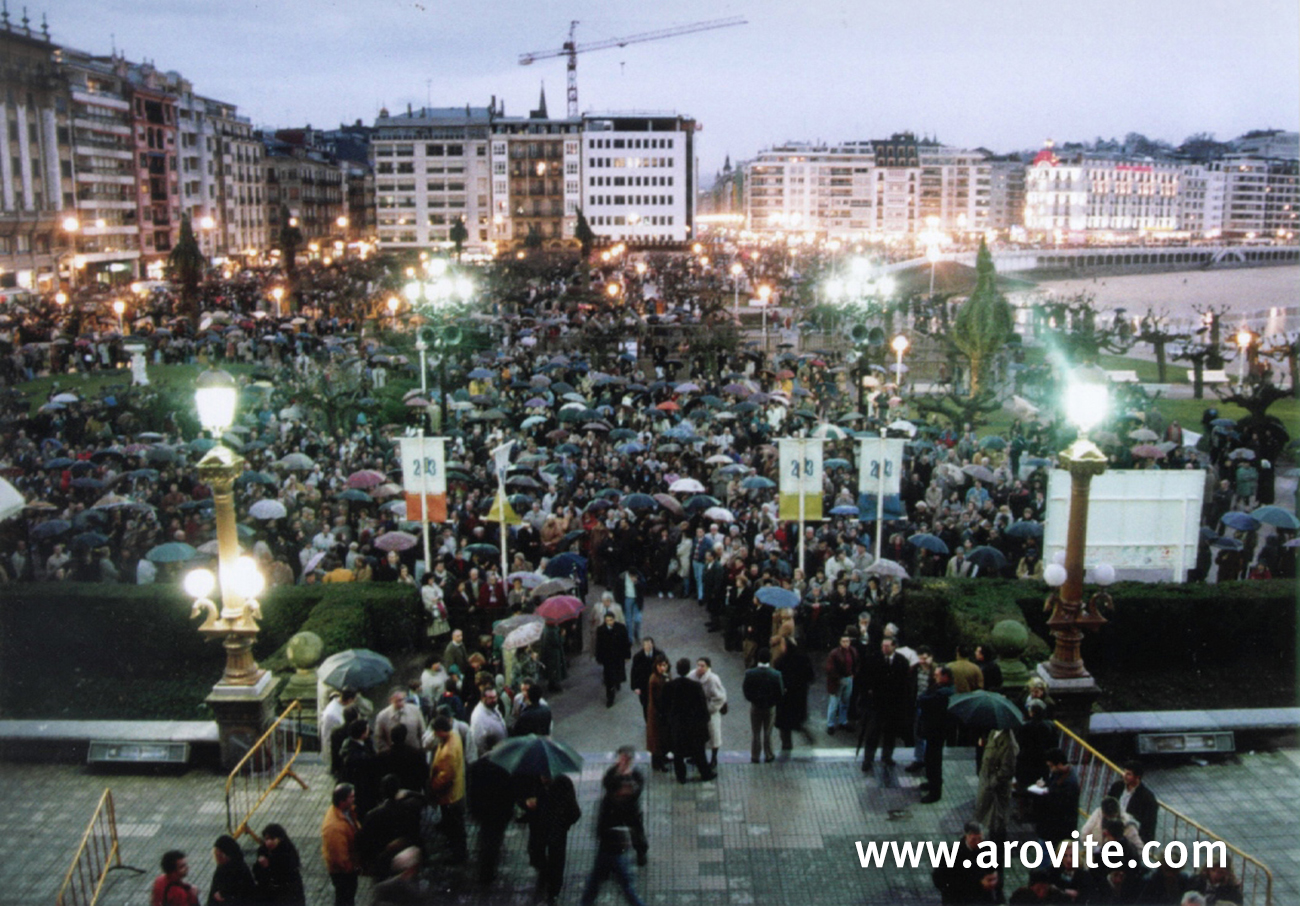
Peace demonstration, organized by Gesto por la Paz, in memory of Gandhi and Gregorio Ordóñez, leader of the PP killed by ETA. San Sebastián, 29/01/1995. Archive of El Correo.
1996
In January ETA kidnapped the prison officer José Antonio Ortega Lara and, in return of his liberation, demanded the move of the prisoners of ETA to prisons in the Basque Country.
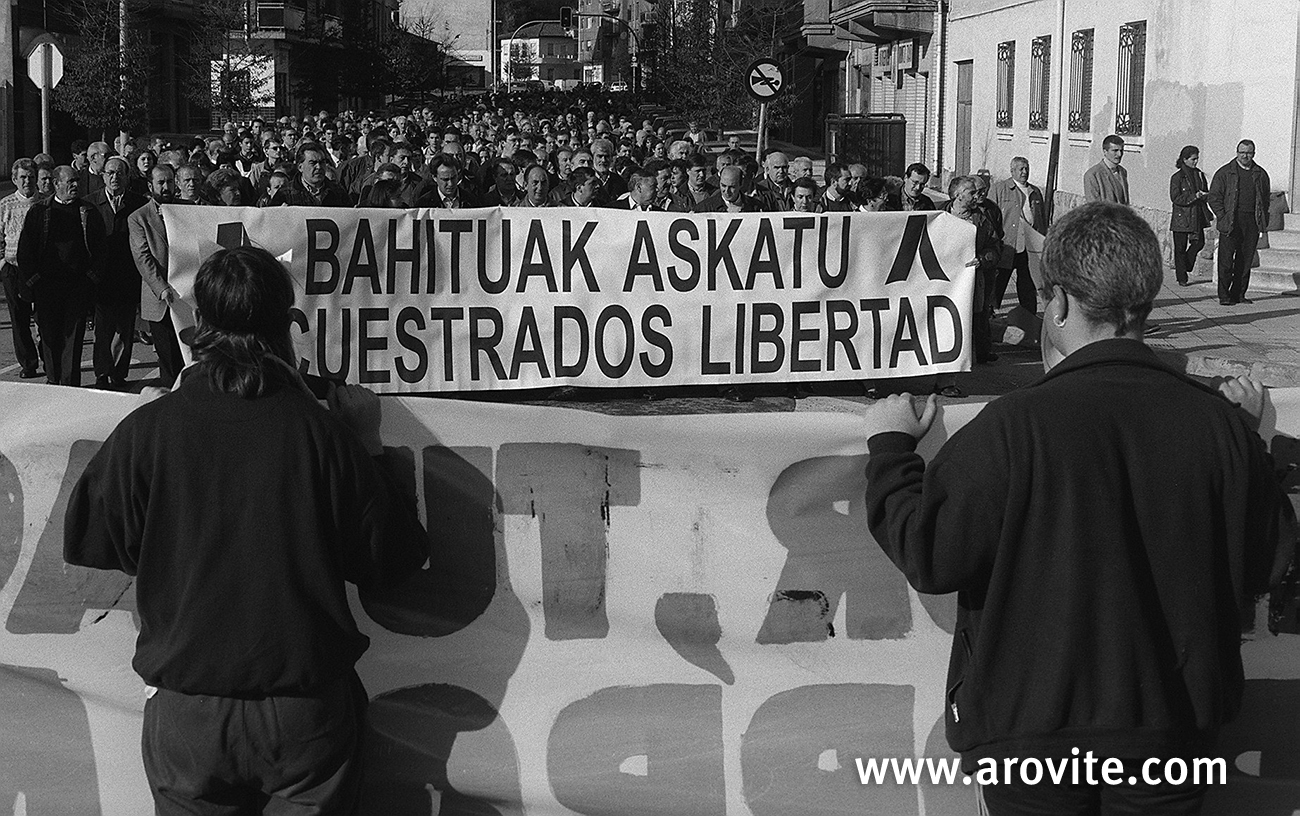
Pacifist demonstration for the liberation of the two men kidnapped by ETA: José Antonio Ortega Lara and Cosme Delclaux, and the counter-demonstration of the radical Basque nationalists in Llodio, 23/12/1996. Archive of El Correo.
1997
In July the Civil Guard released Ortega Lara after 532 days in captivity, the longest kidnapping at the hands of ETA.
Some days afterwards, ETA kidnapped and killed the young city councillor for the PP in Ermua, Miguel Ángel Blanco. The demonstrations of rejection supposed an inflection point with respect to the attitude of the Basque society towards terrorism.
Imprisonment of the Mesa Nacional (directorate) of HB under the accusation of their collaboration with the armed organization for trying to spread a video with the «Democratic Alternative» of ETA.
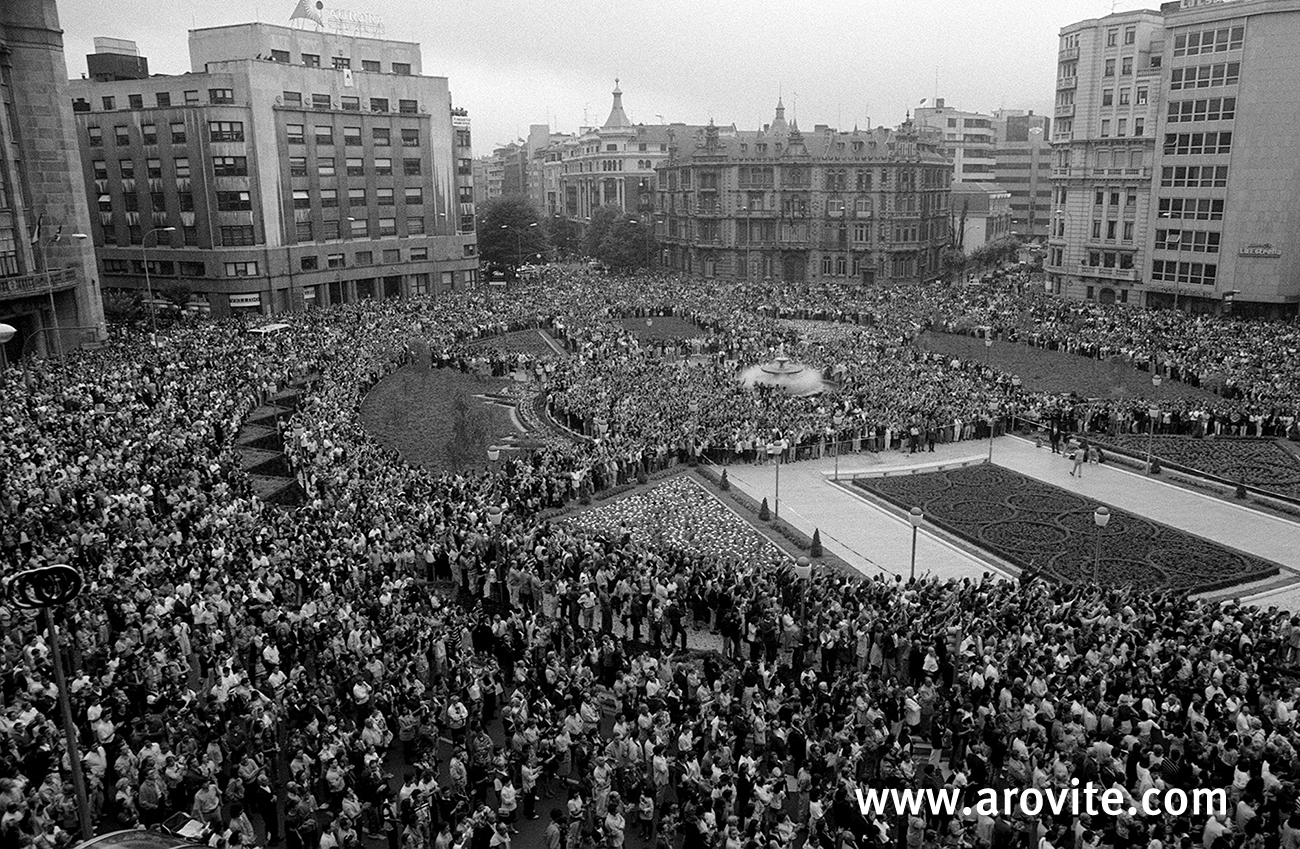
Mass demonstration against the assassination of the city councillor of PP in Ermua Miguel Ángel Blanco on the square of Moyua in Bilbao, 13/07/1997. Archive of El Correo.
1998
In February the Ermua Forum against terrorism was created.
In July the newspaper Egin was forced to close. In January 1999 it was replaced by a new one: Gara.
In September, a few days after all the abertzale forces signed the Pact of Estella in support of self-government for the Basque people, ETA declared a ceasefire which was described as «indefinite and without conditions».
In October, EH (Euskal Herritarrok, Basque citizens), successor of HB, had the best result ever achieved by the radical Basque nationalist movement in autonomous elections (14 members of Parliament).
In November Colectivo de Víctimas del Terrorismo en el País Vasco (COVITE, Collective of Victims of Terrorism in the Basque Country) was founded.
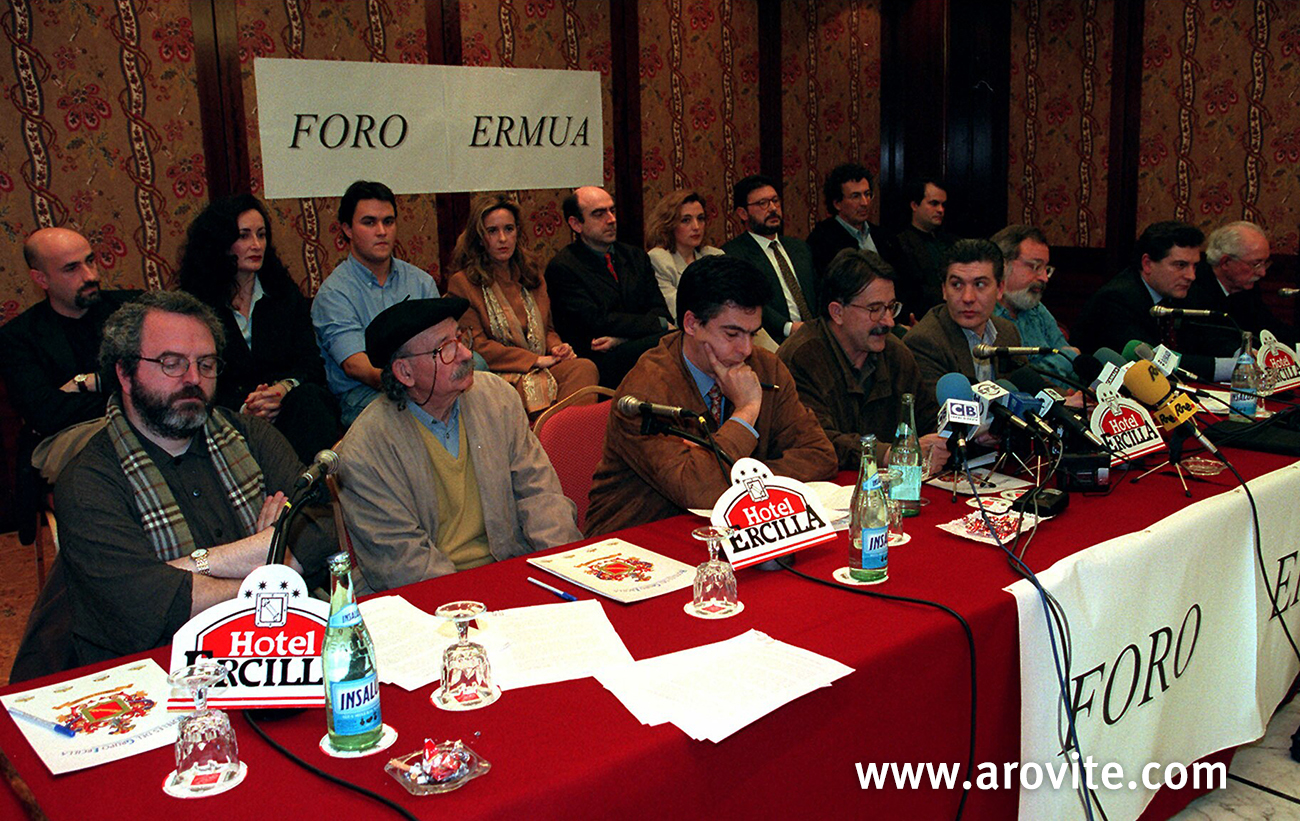
Presentation of the manifest of the Ermua Forum against ETA, with Basque intellectuals and professionals (Jon Juaristi, Agustín Ibarrola, Fernando Savater, Manuel Montero, etc.) in Hotel Ercilla, Bilbao, 13/02/1998. Photographer: Bernardo Corral. Archive of El Correo.
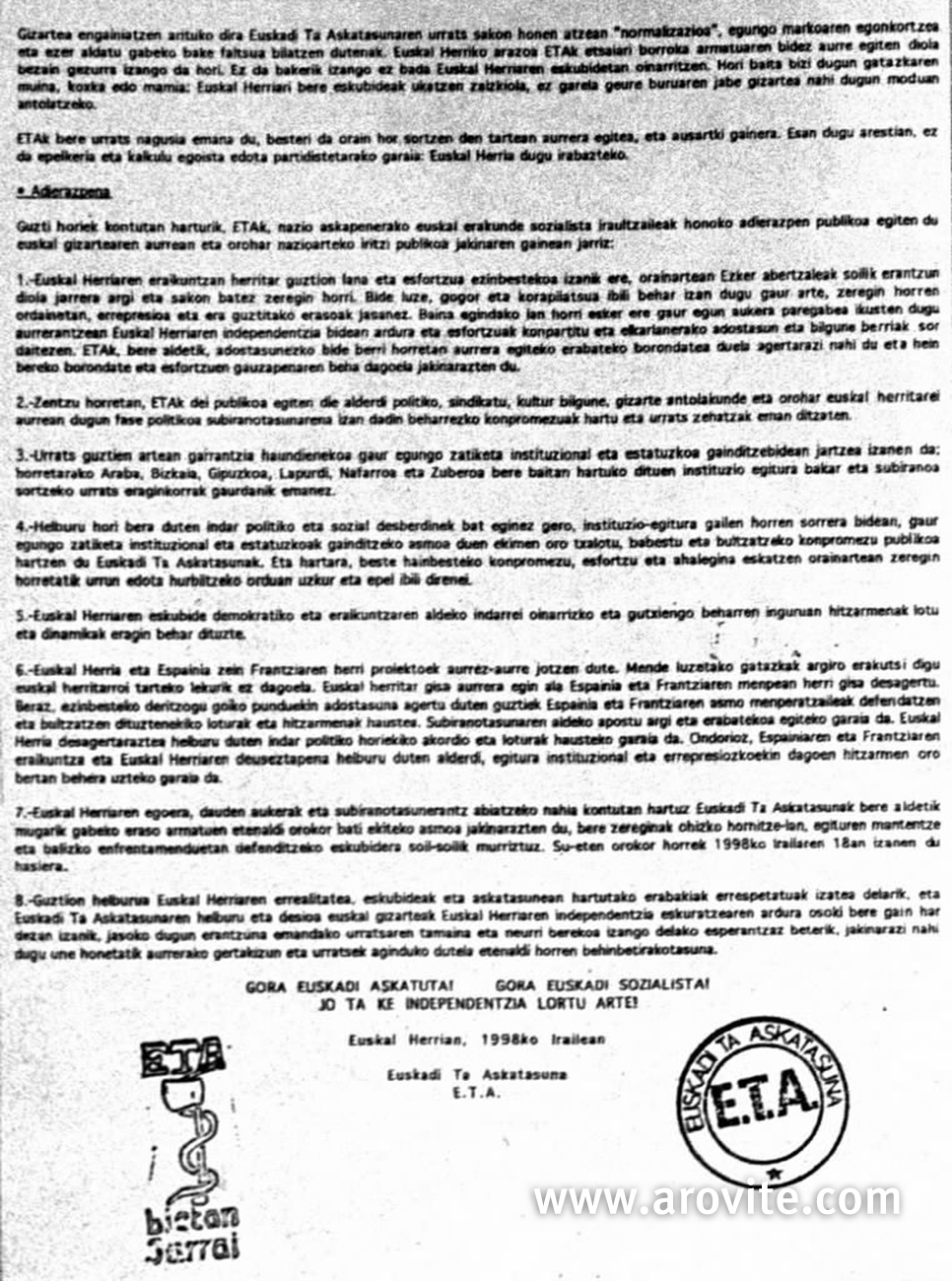
Last page of the statement in which ETA announced an indefinite ceasefire, 17/09/1998. Photographer: T. Fernández. Archive of El Correo.
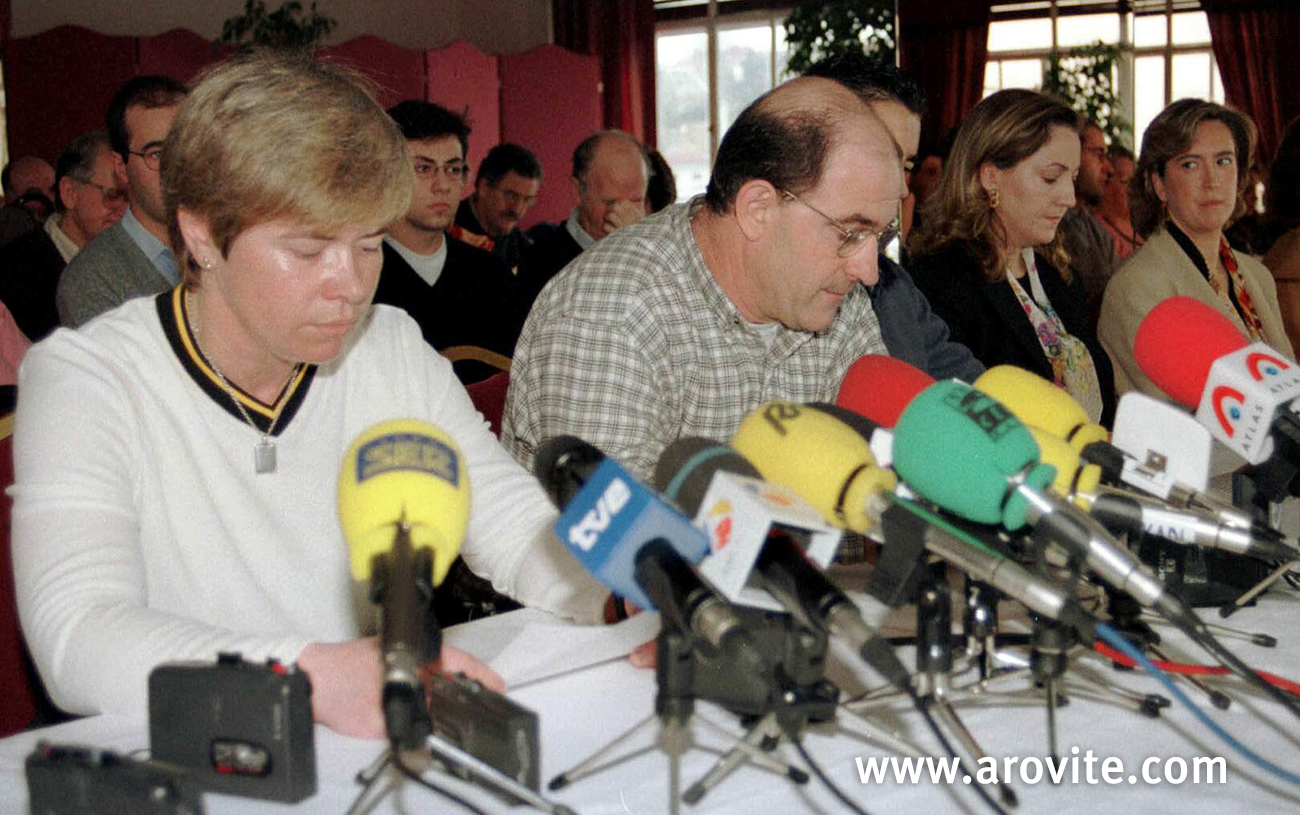
From left to right, Inmaculada Iruretagoyena and Miguel Olaciregui, during the press conference of the victims of terrorism, 28/11/1998. Archive of El Correo.
1999
Creation of the civic platform ¡Basta ya! (Enough is enough) against ETA.
In December ETA ended its ceasefire.
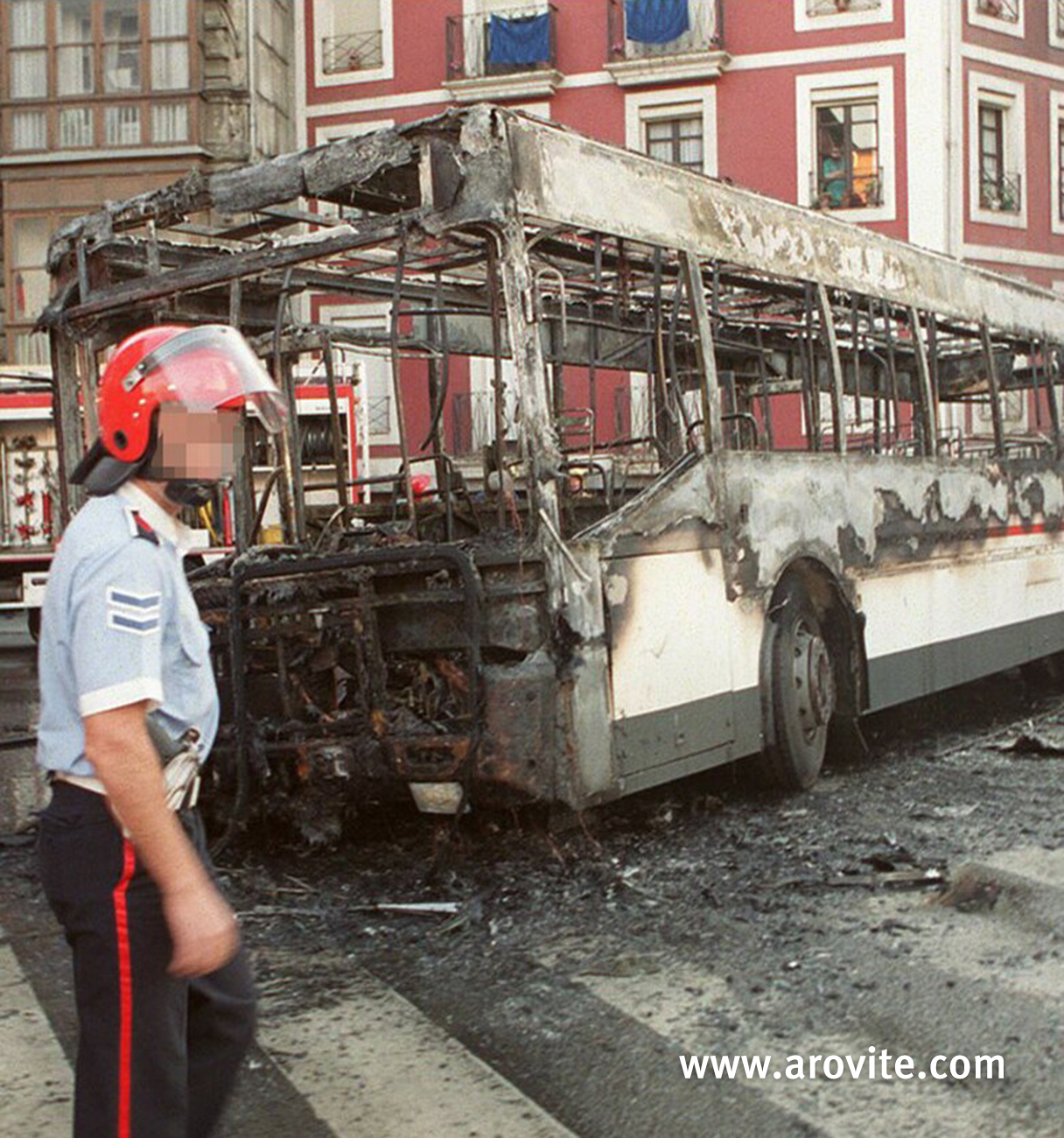
A Basque policeman passing in front of a bus which had been burnt by radicals in Bilbao, 29/09/1999. This happened on the same day as the celebration of Gudari Eguna (Day for the Basque Fighter). Photographer: Luis Calabor. Archive of El Correo.
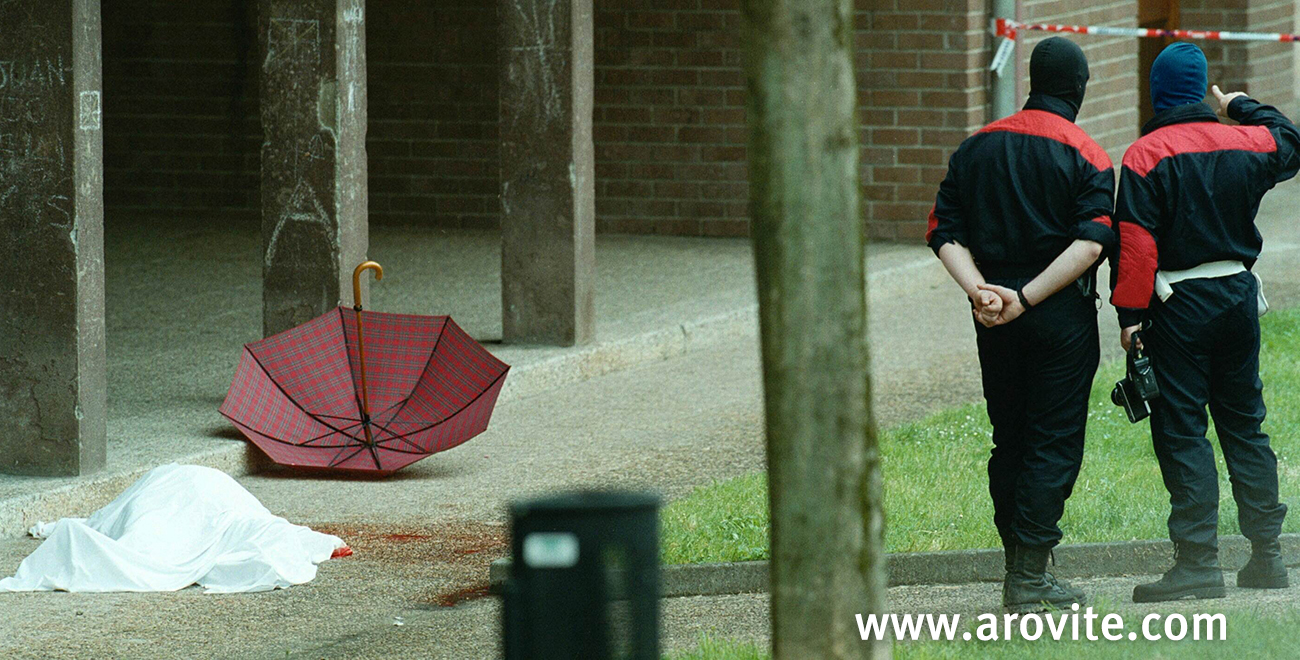
Dead body of José Luis López de Lacalle, journalist and veteran anti-Francoist fighter, lying under a sheet after being killed by a member of ETA. Andoain, 8/05/2000. Photographer: J. M. López. Archive of El Correo.
2001
In May HB appeared again as Batasuna (Unity). The critics of the violence of ETA split and founded a new political party: Aralar.
In the autonomous elections of May Euskal Herritarrok went from 14 to 7 seats. The Gestoras Pro Amnistía were illegalized in December.
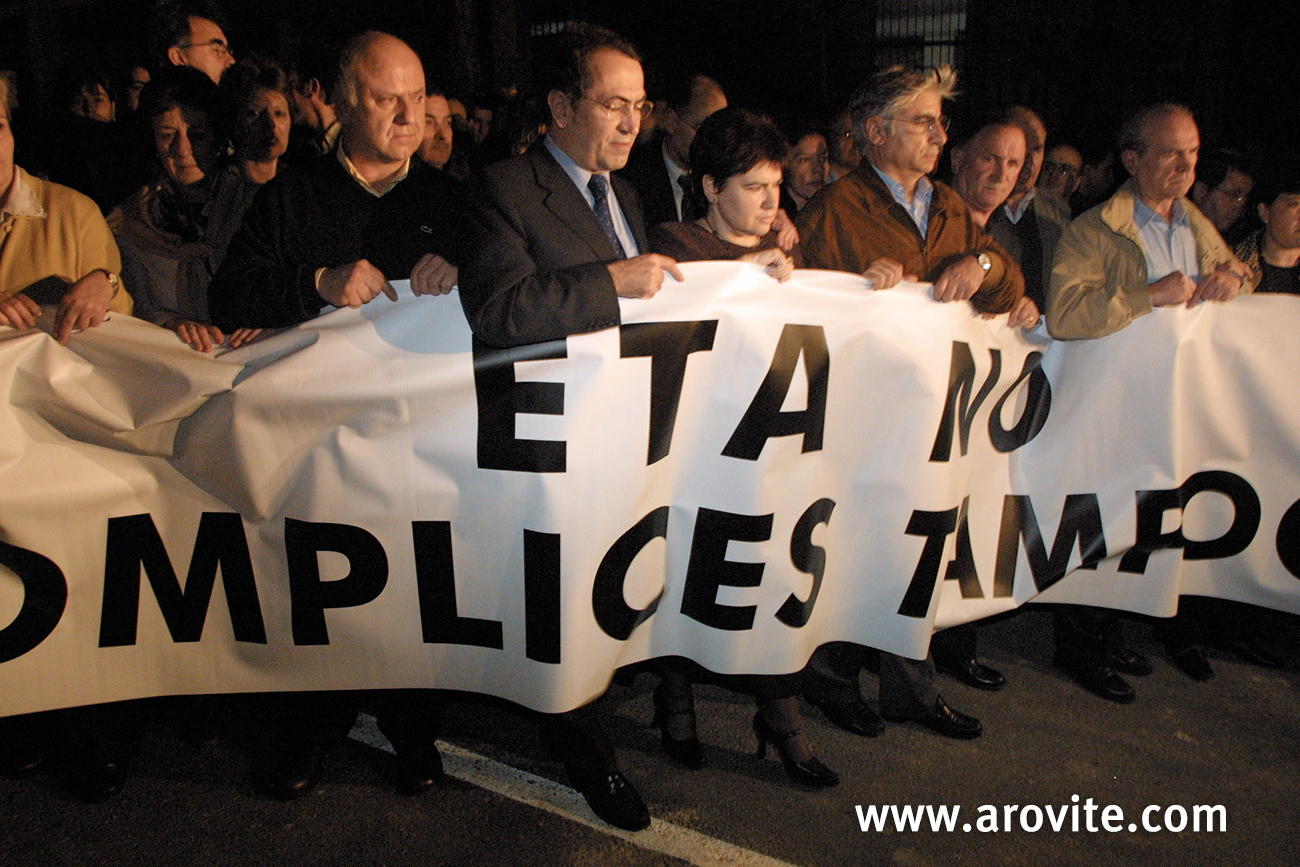
Image of the head of the demonstration, with socialist leaders, after ETA had murdered Froilán Elespe, who had been city councillor of PSE-PSOE in Lasarte, 20/03/2001. Photographer: Ignacio Pérez. Archive of El Correo.
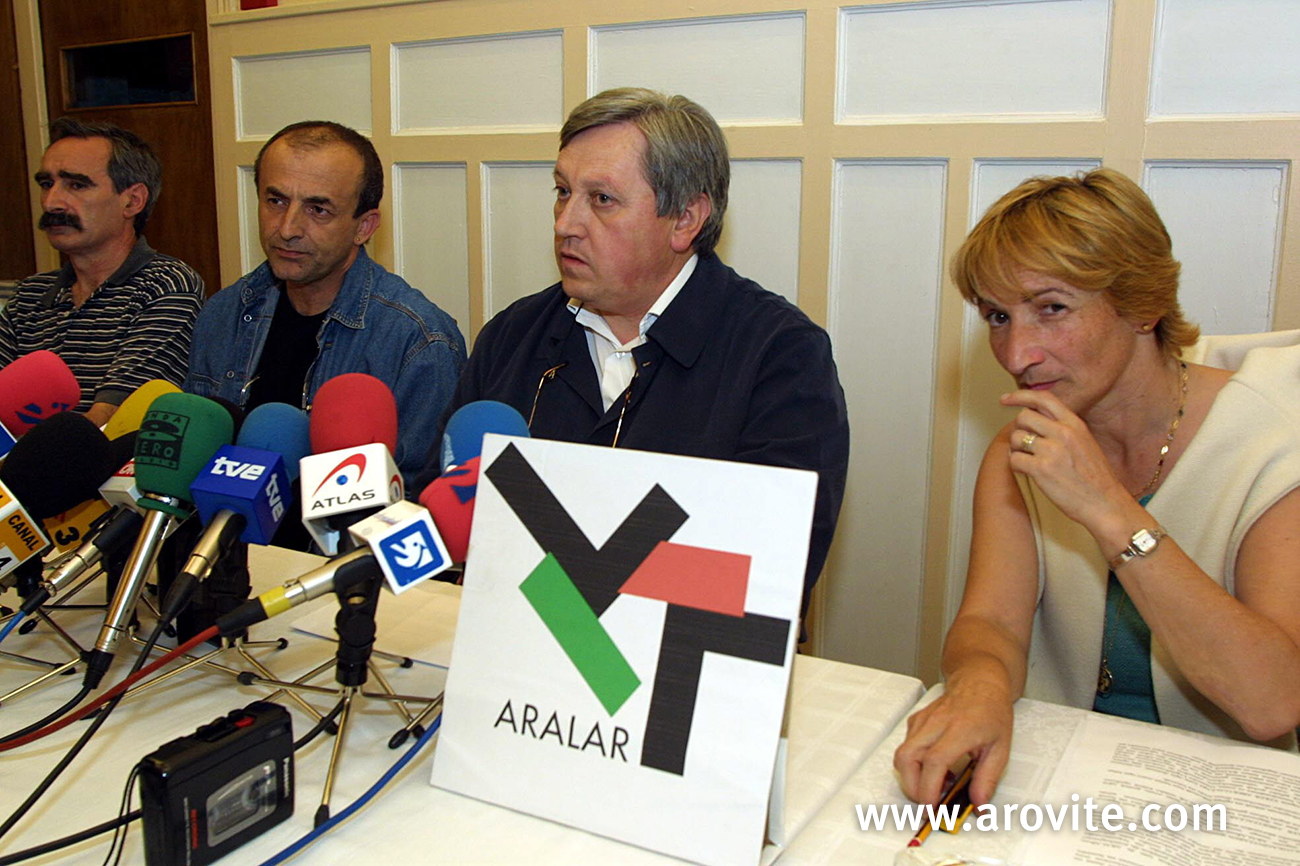
Patxi Zabaleta and other members of Aralar during a press conference. Pamplona, 05/07/2001. Photographer: Luis Azanza. Archive of El Correo.
2002
Approval of the Law of Political Parties, based on the Agreement for Freedom of two years ago, which prevents that a party that supports the use of violence against democracy turns into a legal political force.
In September ETA declared that all the headquarters and acts of PP and PSOE were «military targets».
2003
In June, by virtue of the application of the Law of Parties, Batasuna was illegalized in Spain.
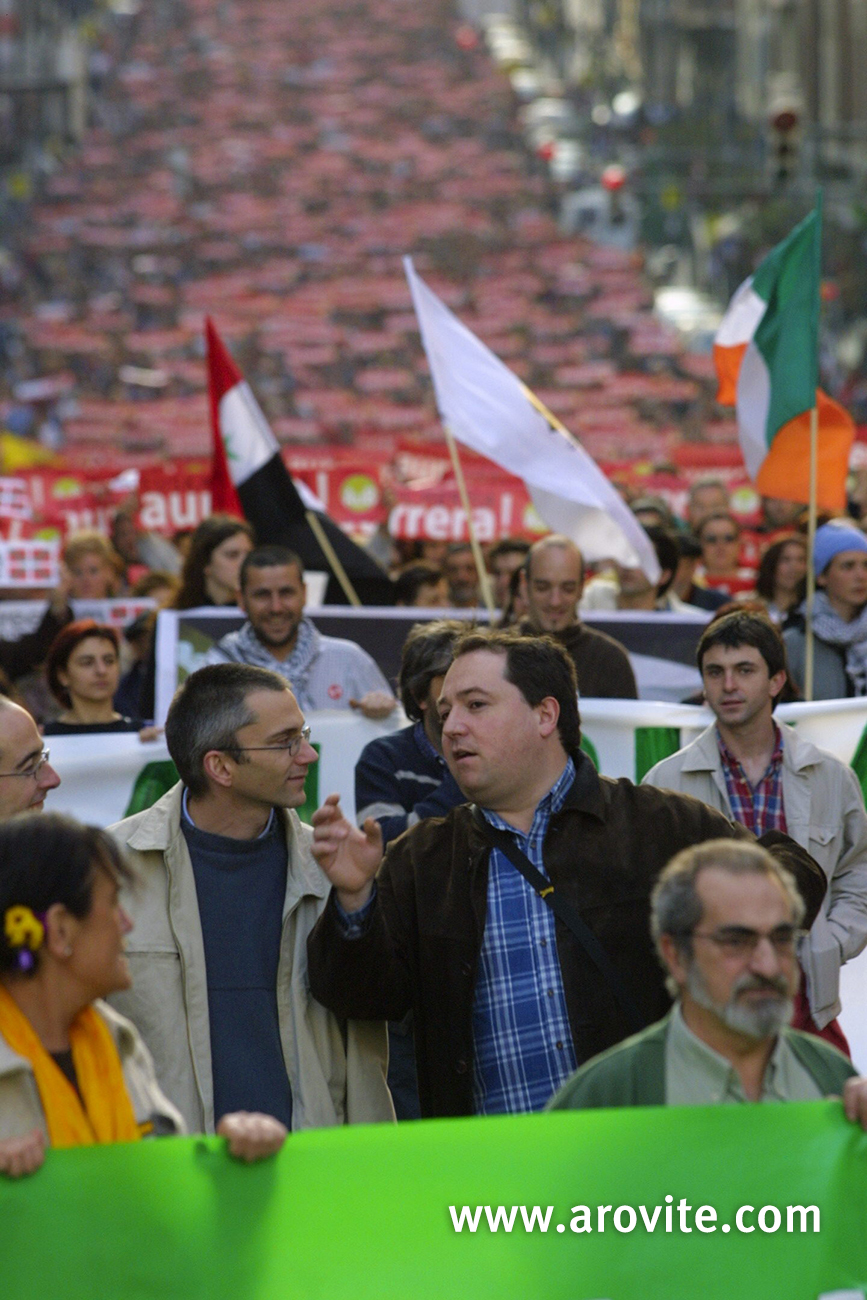
Demonstration on the streets of Bilbao against the illegalization of Batasuna and other lists of candidates of the radical Basque nationalist movement, 22/03/2003. Joseba Permach and Pernando Barrena were among the participants. Photographer: Ignacio Pérez. Archive of El Correo.
2004
In April ETA announced a ceasefire exclusively for Cataluña.
2005
In May the Congress’ approved the negotiations between the Government of José Luis Rodríguez Zapatero and ETA in order to achieve the end of violence if the terrorists laid down their arms and did not ask for political compensation.
Next, in June, ETA announced that, until further notice, politicians, except the members of the Government, were no longer their target.
2006
The new «permanent» ceasefire of ETA, which had been declared in March, was already broken in December with the attack in the car park of the airport of Barajas (Madrid) which cost the life of two people: the Ecuadorians Carlos Alonso Palate and Diego Armando Estacio.
Elkarri was turned into a new pacifist organization: Lokarri.
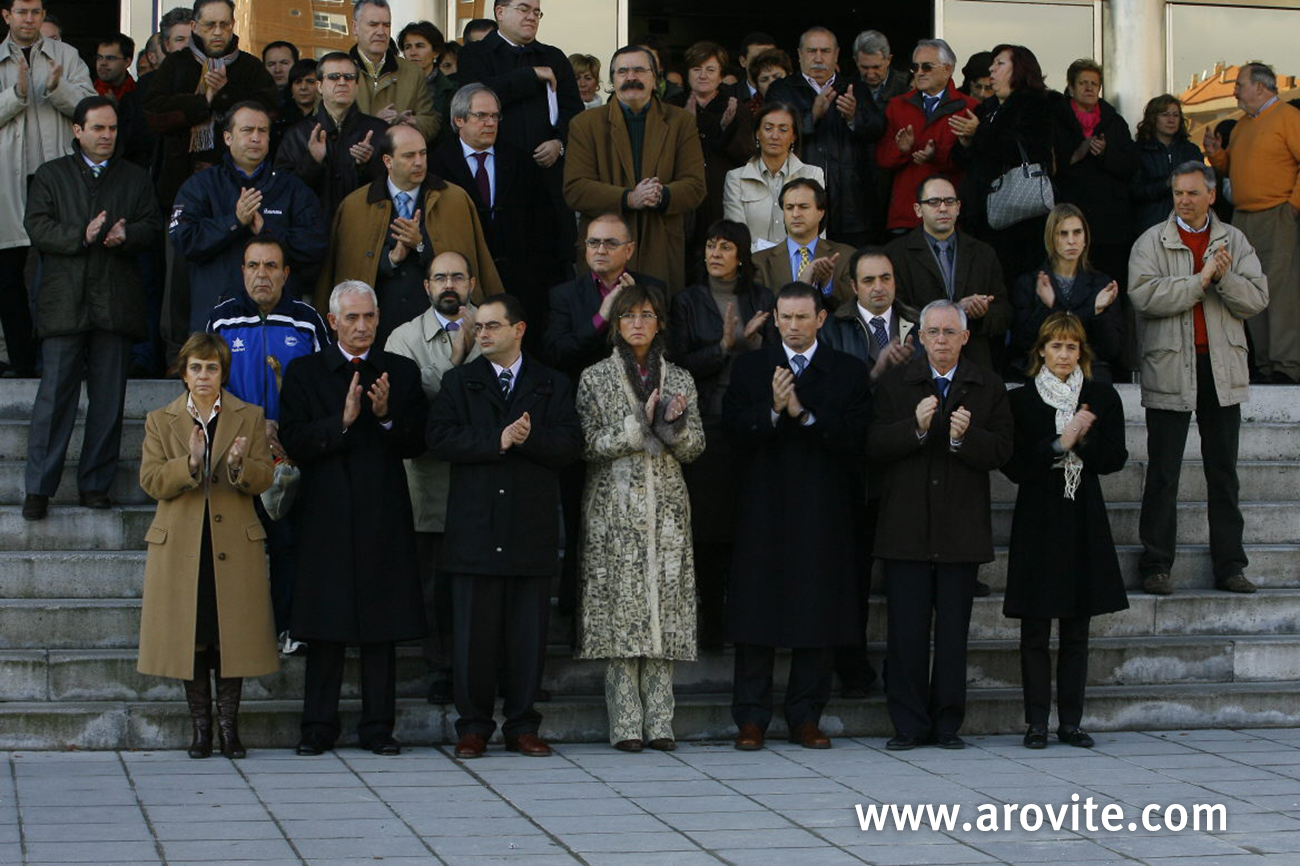
Lehendakari (President) Juan José Ibarretxe and the several ministers of the Basque Government in a silent demonstration in Lakua against the attack at the car park of Barajas, with which ETA broke its ceasefire. Vitoria, 04/01/2007. Photographer: J. Andrade. Archive of El Correo.
2007
In June ETA ended its ceasefire.
2008
In November Garikoitz Aspiazu, leader of the military machine of ETA, was arrested in France.
In less than a month the French police arrested his presumed successor: Aitzol Iriondo.
2009
In April Jurdan Martitegi was arrested. He was the third leader of ETA who got arrested within six months.
The European Court of Human Rights ratified the sentence of 2003 which had illegalized Batasuna.
2010
The radical Basque nationalists presented the document Zutik Euskal Herria (Euskal Herria standing) in February, in which they abandoned the use of political violence.
The French policeman Jean-Serge Nérin died in March in a confrontation with several members of ETA. It was the last murder committed by the terrorist organization.
In September ETA announced that it would no longer carry out “armed actions”.
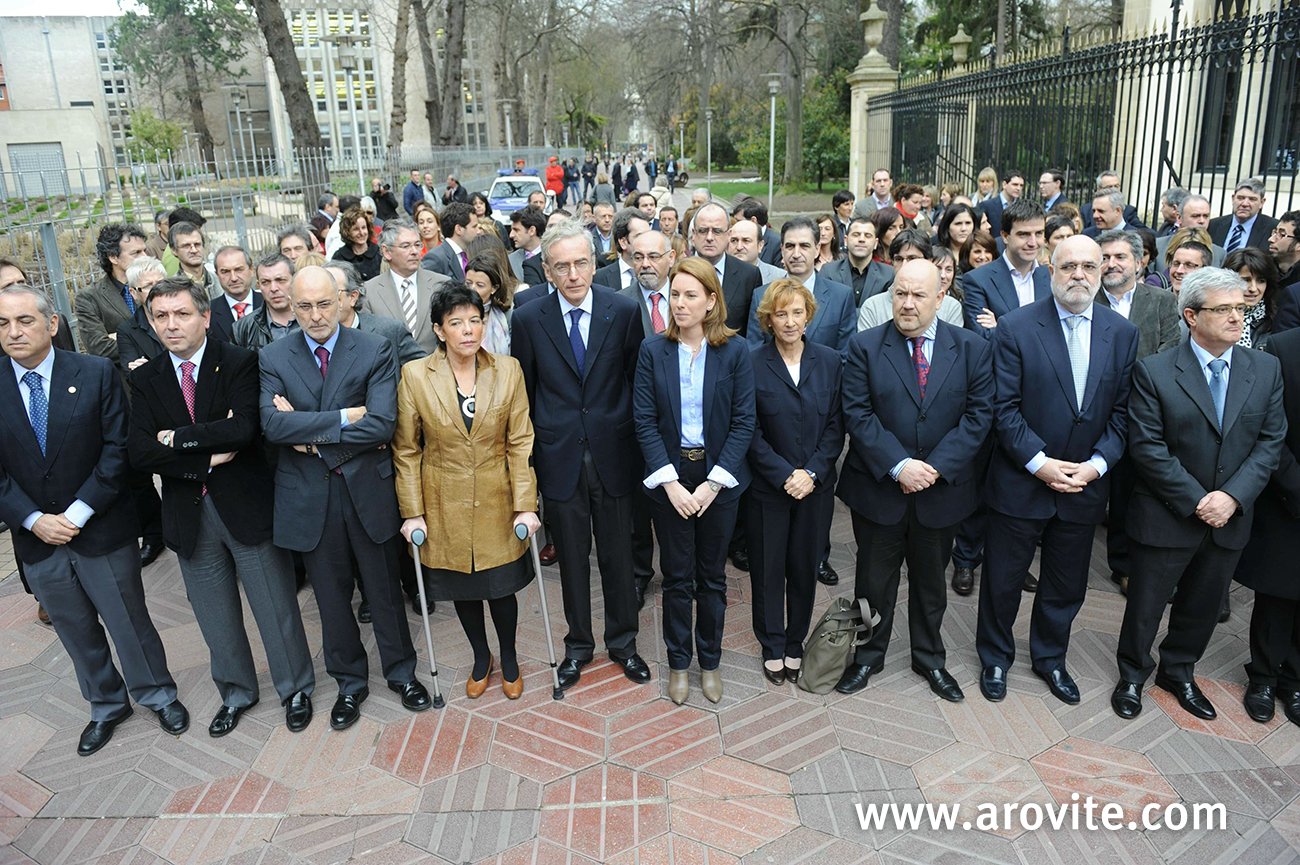
Act in the Basque Parliament in tribute to Jean-Serge Nérin, the first French police officer who was killed by ETA. Vitoria, 19/02/2010.

